Ohio Reptiles and Amphibians, 2016
Here are some reptiles, amphibians, and a few other things that I observed
in southeastern Ohio in 2016, in mostly chronological order.
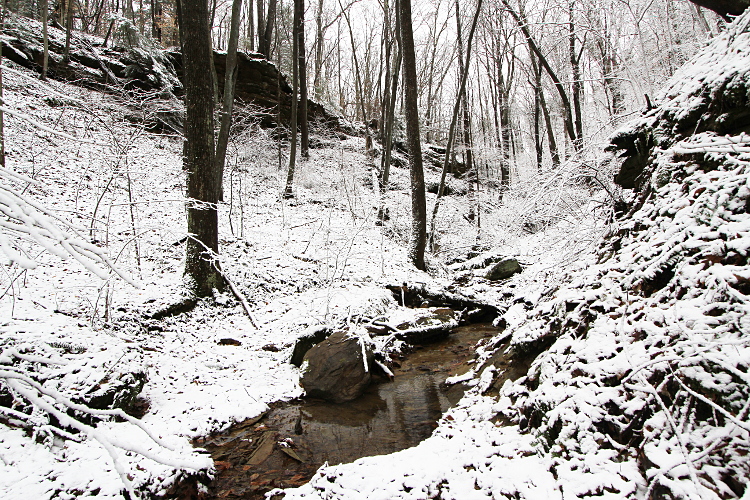
A ravine in the Hocking Hills in mid January.
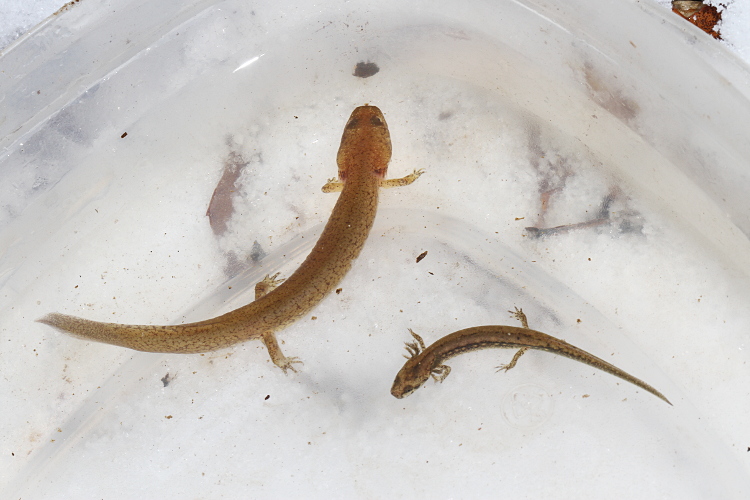
A couple of salamander larvae found in the above creek. The larger
one is a Northern Spring Salamander
(Gyrinophilus porphyriticus porphyriticus) and the smaller one is a
Southern Two-lined Salamander (Eurycea cirrigera).

A closer look at the Spring Salamander larva.
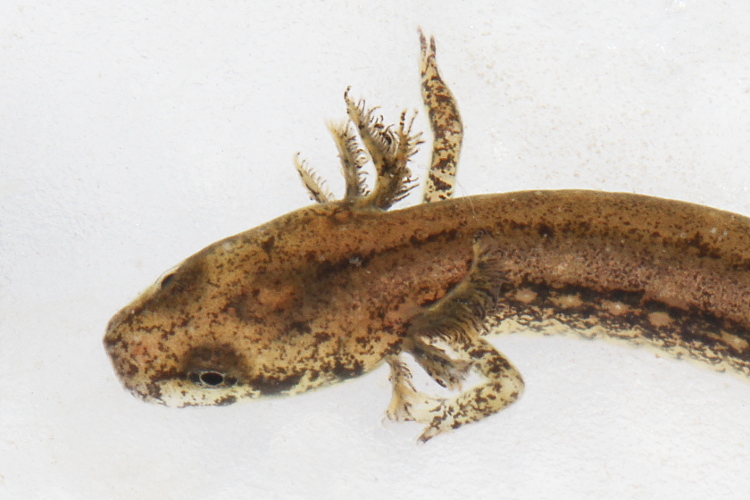
And at the Two-lined Salamander larva.
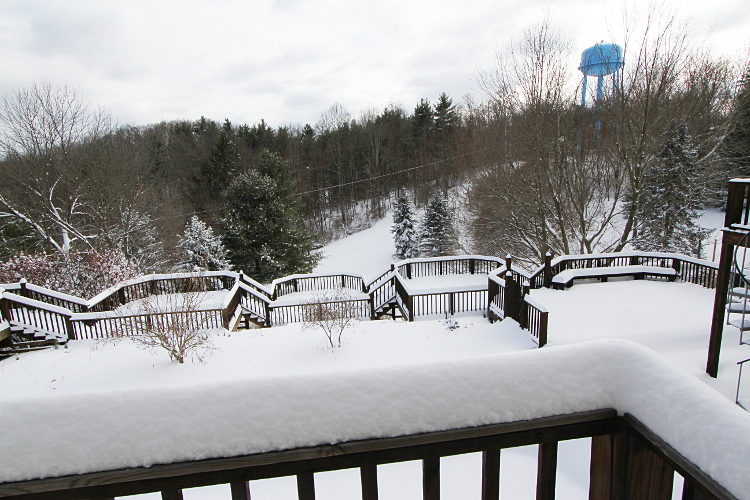
Our backyard on January 23. In spite of what you see here, overall it was
relatively short and warm winter.
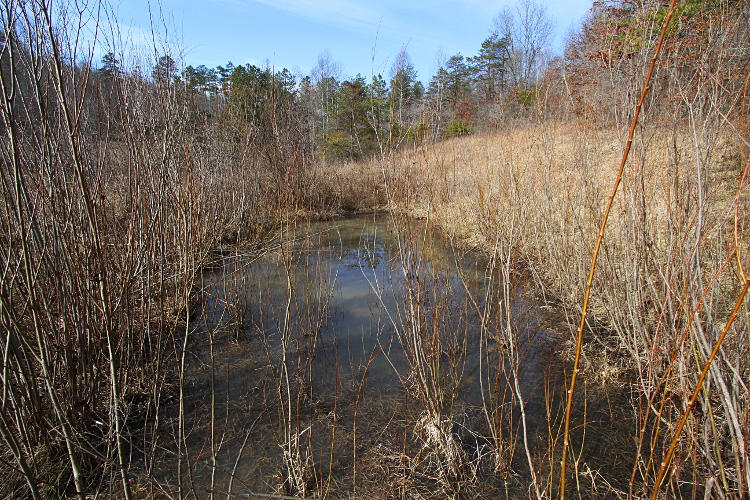
Several (at least 6) dead Jefferson Salamanders
(Ambystoma jeffersonianum) were observed in this pool on February 6.
I suspect they entered the pond sometime earlier in the winter and
the pond froze for too long, suffocating them.
There were also at least 12 live Eastern Newts
(Notophthalmus viridescens) in the pool.
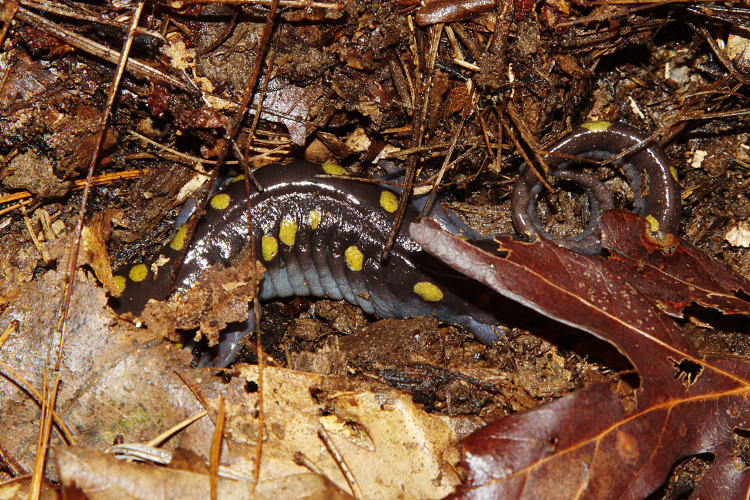
One of several Spotted Salamanders (Ambystoma maculatum) found under
logs on February 21. Shown as found. It's neat how they curl their tails up
when resting under cover. I assume they do this to avoid the end of
their tail getting frozen or chewed on by some other critter.
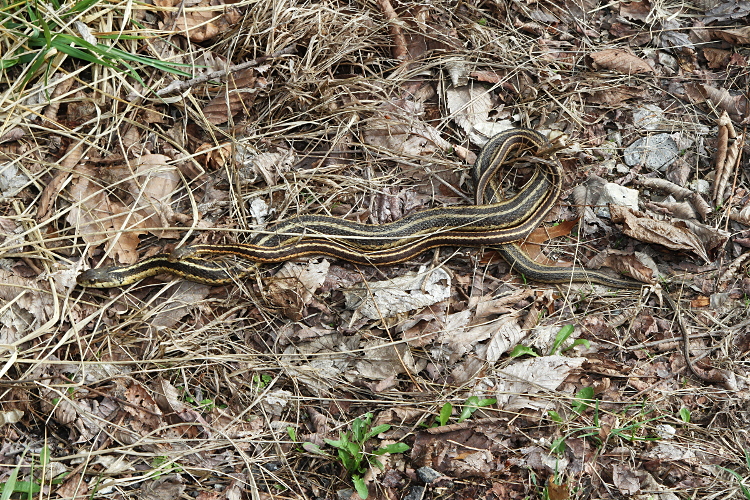
An amorous pair of Common Gartersnake (Thamnophis sirtalis)
observed on the Ohio University campus on March 11. It's that time of year.
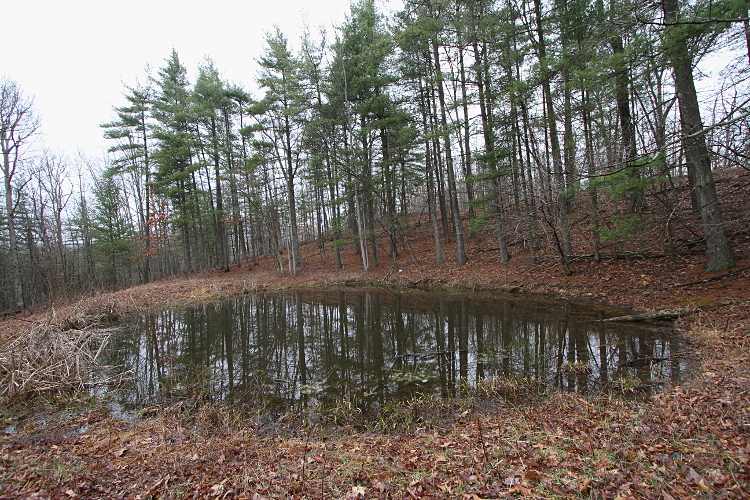
A man-made pond on a ridgetop that I checked out for the first time on
March 13. It seems to have been here for a very long time. It had many
nesting Four-toed Salamanders (Hemidactylium scutatum),
lots of Spotted Salamander (Ambystoma maculatum) egg masses,
Eastern Newts (Notophthalmus viridescens), and Green Frogs
(Rana clamitans) in it.
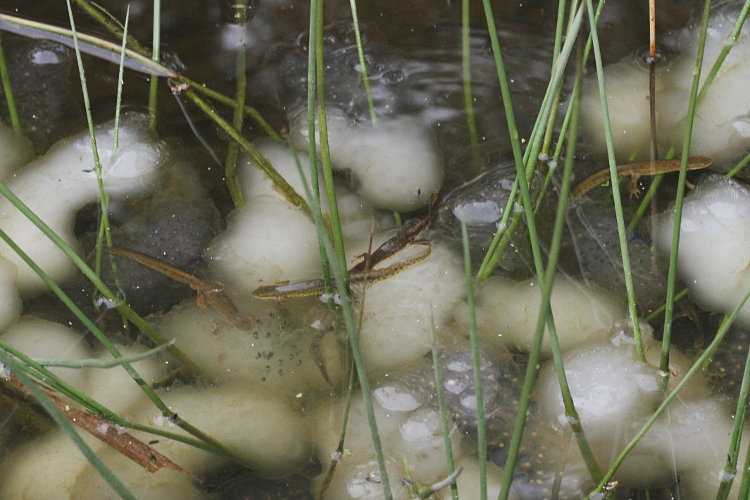
Eastern Newts feasting on Spotted Salamander eggs. Hopefully they don't eat all of them!!
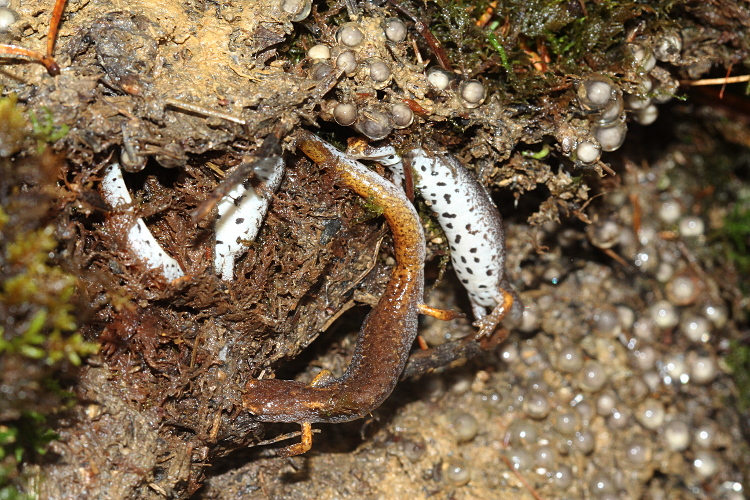
A communal Four-toed Salamander nest in the making.
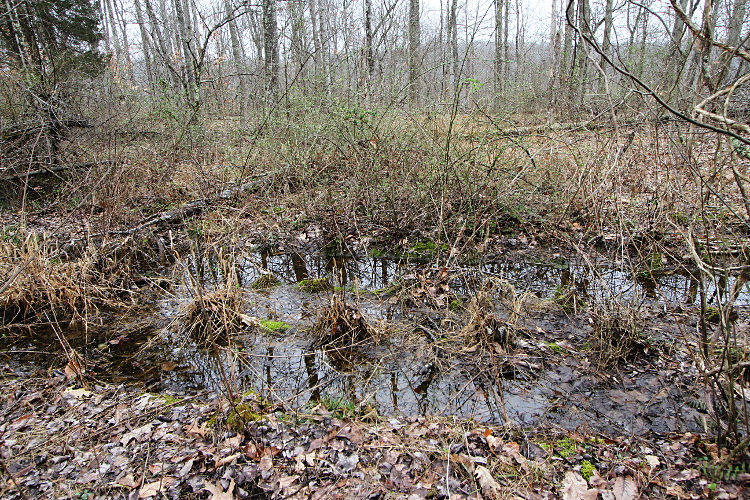
This pool of water in a disturbed area on a ridgetop is a nesting site for
Four-toed Salamanders.
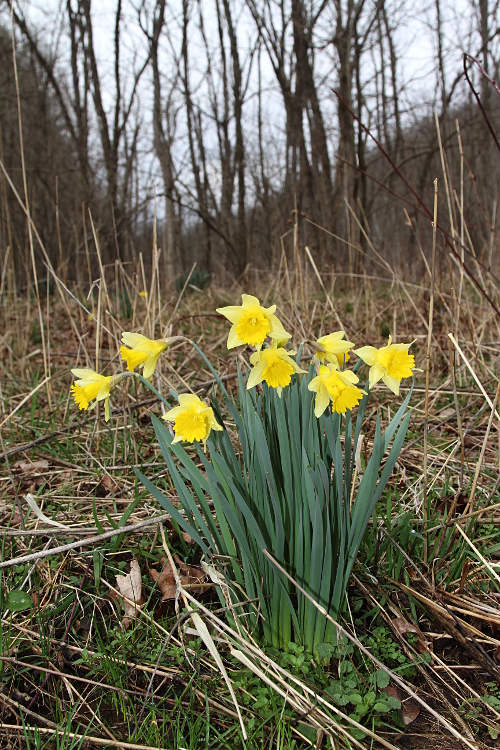
Daffodils observed at a long abandoned homestead.
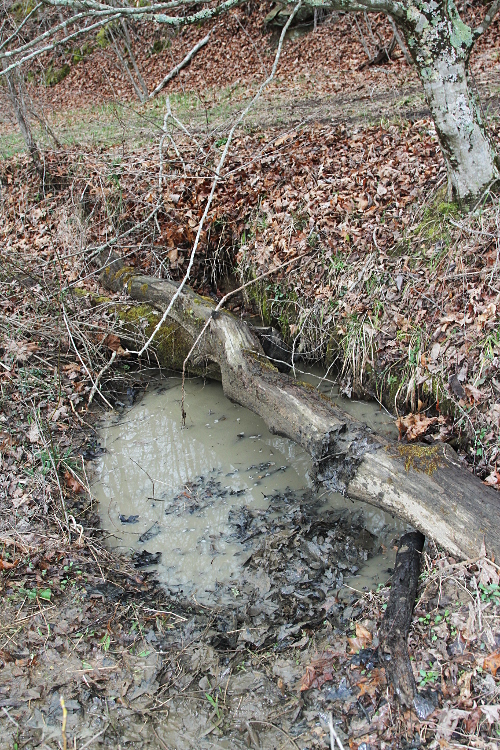
A pool of water that I dipnetted. There is an ATV trail in the background
and a creek in the opposite direction.
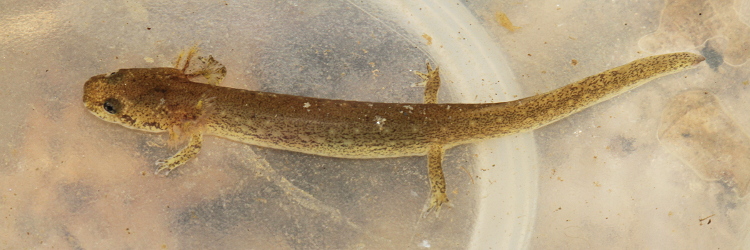
A Mud Salamander (Pseudotriton montanus) larvae found in the pool.
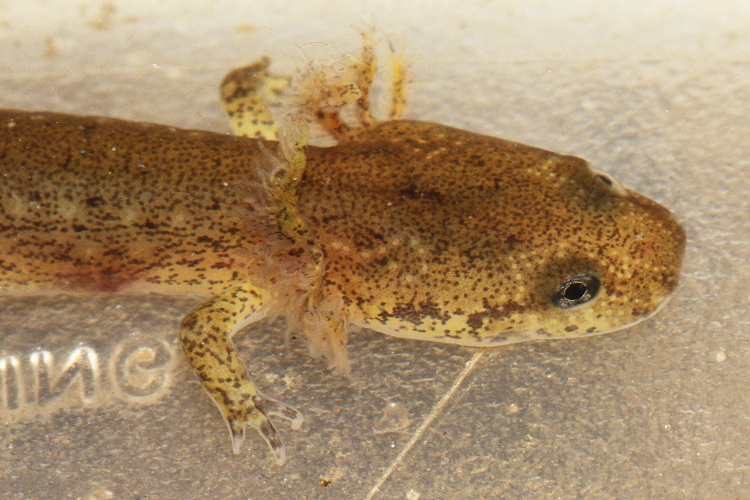
Another look at the Mud Salamander larva.
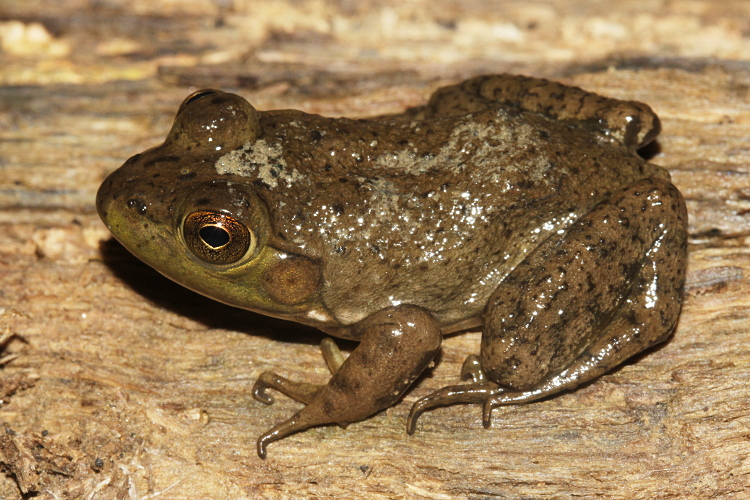
A young Bullfrog (Rana catesbeiana) was also dipnetted from the pool.
This creek and little pool are located under closed canopy and are definitely
not Bullfrog habitat. Young Bullfrogs often disperse long distances
from their place of birth in search of suitable habitat.
This is undoubtedly the reason this little frog turned up here.
Suitable habitat for Bullfrogs includes larger ponds, swamps,
abandoned swimming pools,...
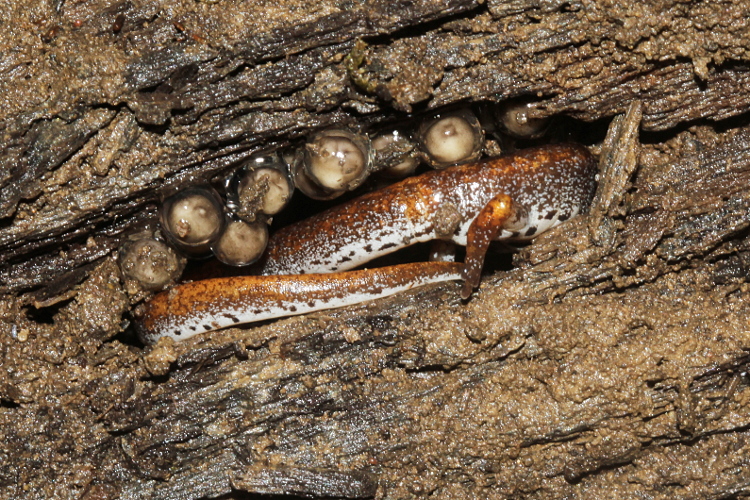
A nesting Four-toed Salamander (Hemidactylium scutatum) that was
revealed when the moss covering a log at the edge of a pond was lifted.
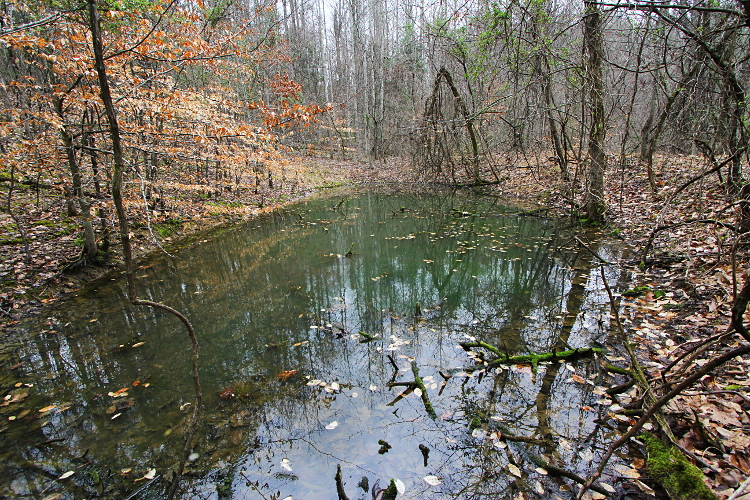
Nesting Four-toed Salamanders were found under moss along the edge of
this pond.
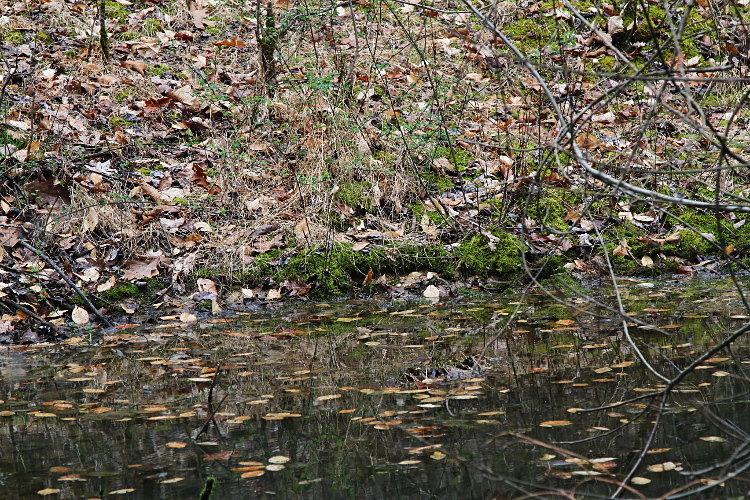
A closer look at the shoreline habitat.
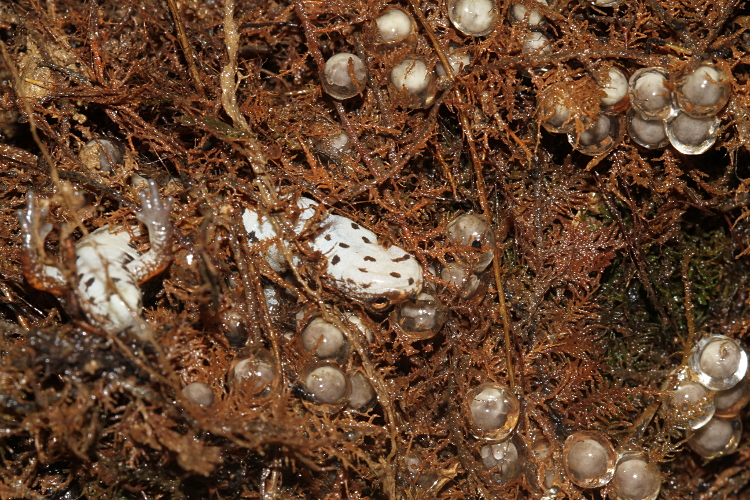
A Four-toed Salamander with eggs.
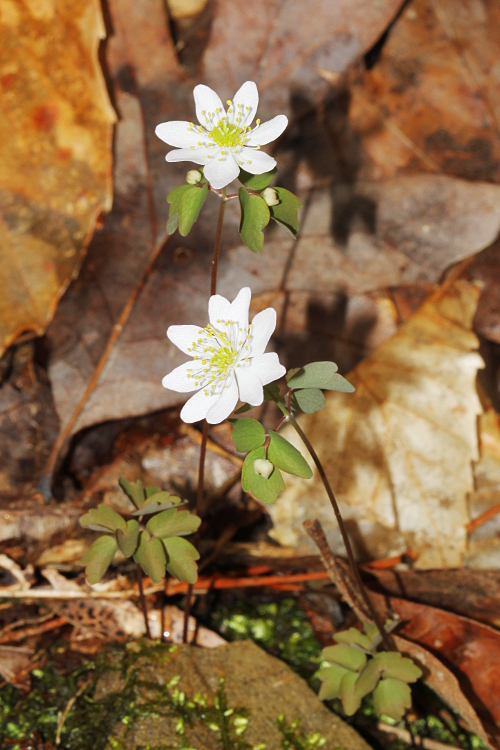
Rue Anemone (Thalictrum thalictroides).
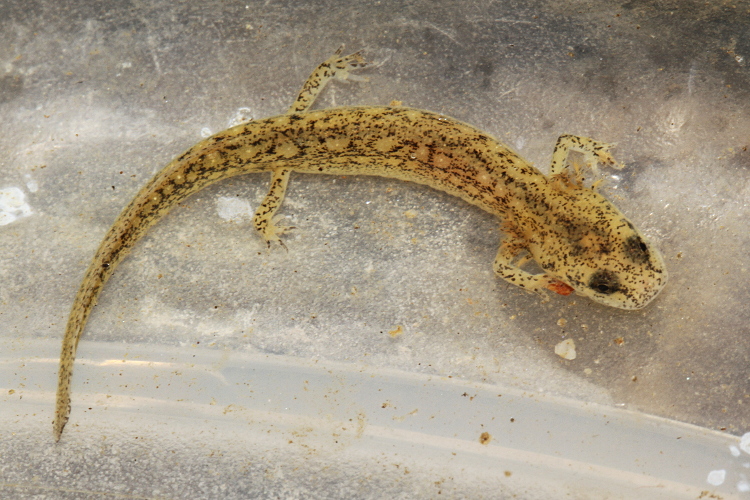
A Southern Two-lined Salamander (Eurycea cirrigera) larva.
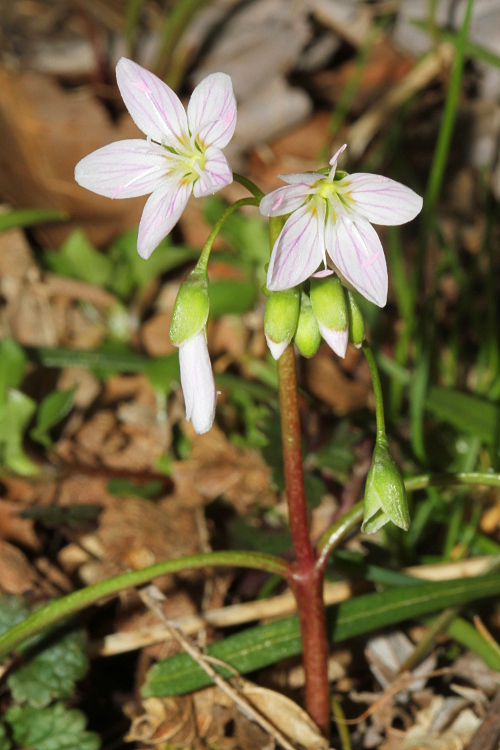
Spring Beauty (Claytonia virginica).
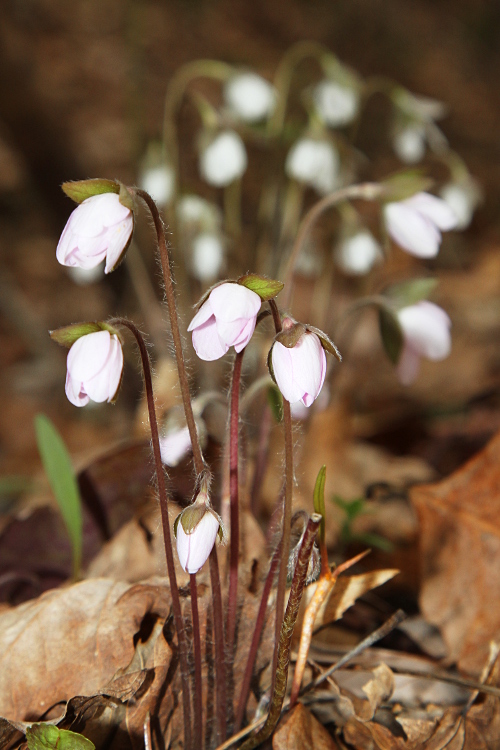
Sharp-lobed Hepatica (Hepatica acutiloba).
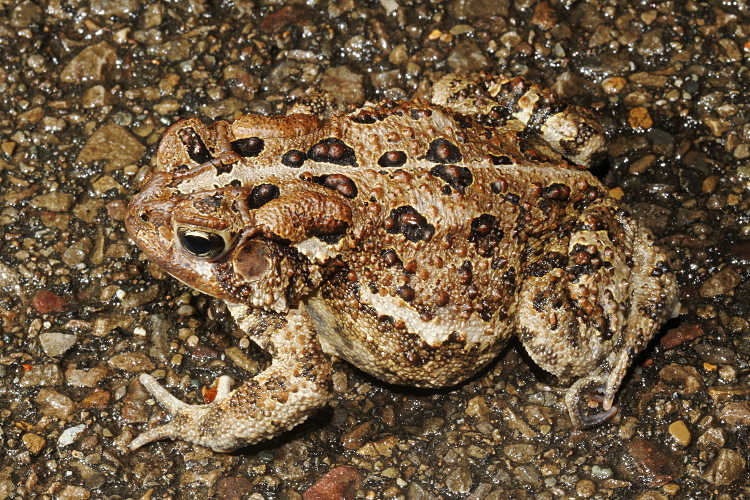
American Toad (Bufo americanus).
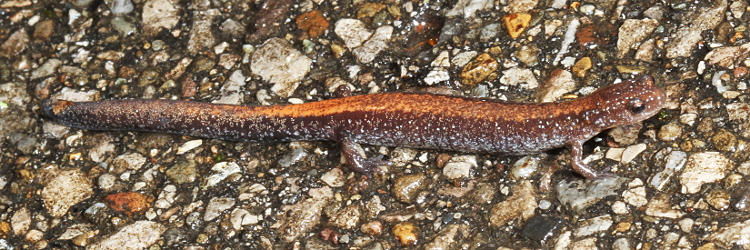
Red-backed Salamander (Plethodon cinereus).
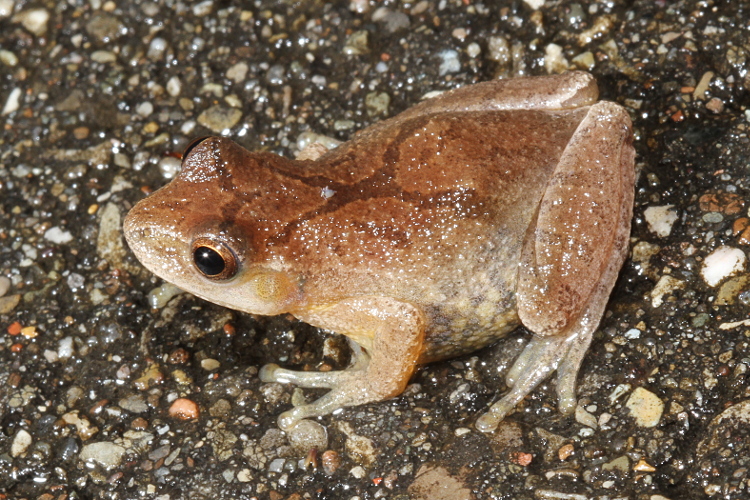
Spring Peeper (Pseudacris crucifer).
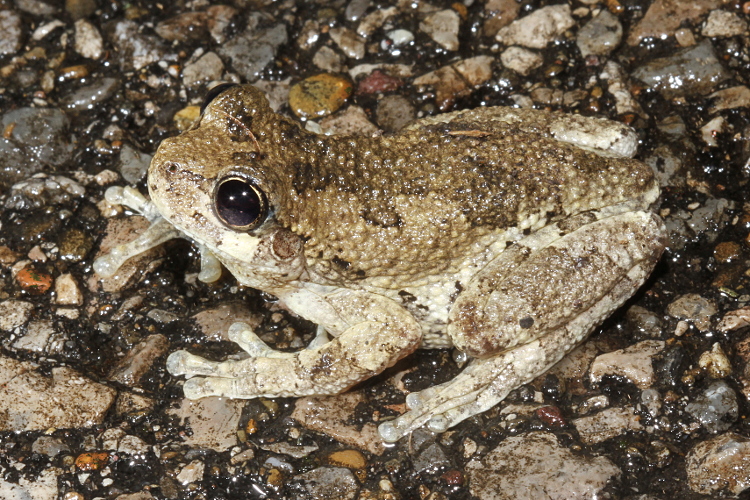
Cope's Gray Treefrog (Hyla chrysoscelis).
You know it's a warm spring here when these guys are out in March.
I did not hear it call, but it seems that all Gray Treefrogs in
Athens County are chrysoscelis.
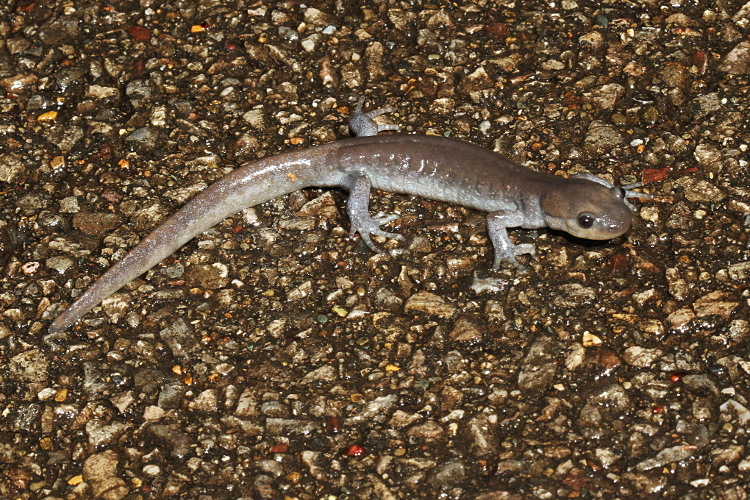
Jefferson Salamander (Ambystoma jeffersonianum).
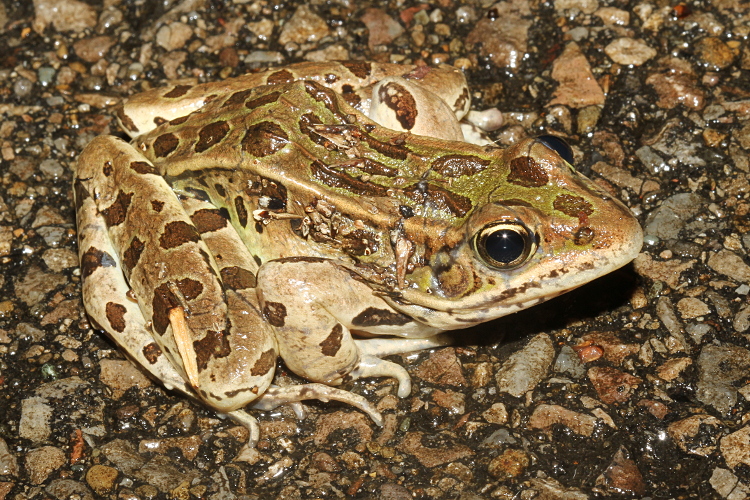
Northern Leopard Frog (Rana pipiens).
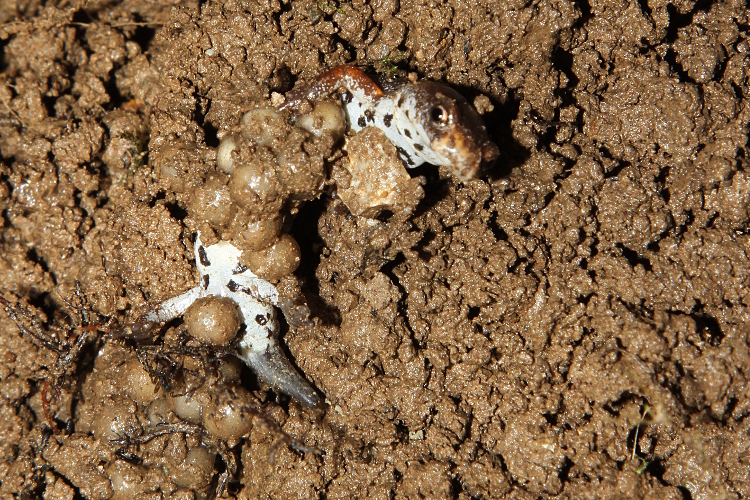
A nesting Four-toed Salamander (Hemidactylium scutatum), shown as
found under moss at the edge of a pool.
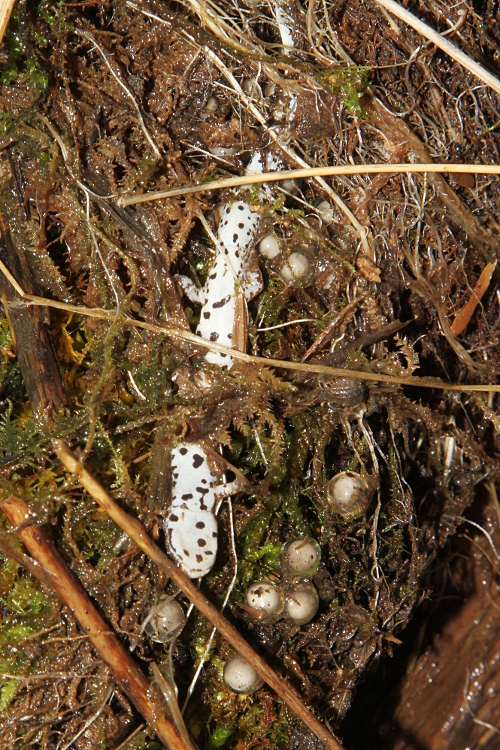
Another nesting Four-toed Salamander.
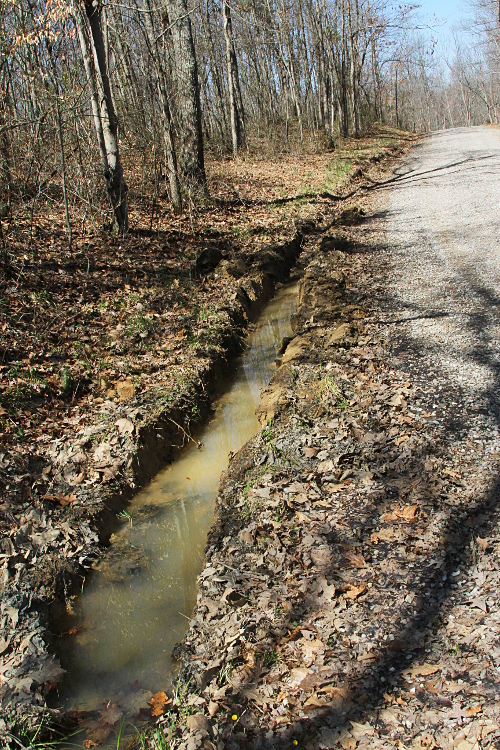
The road maintenance people re-dug this ditch just after the
Four-toed Salamanders laid their eggs in the moss that used to line the sides
of it. Well that's the way it goes at these rock and roll shows...
If they did not re-dig the ditch every once in a while, the habitat would
not exist. Fortunately those salamanders are common in this area.
And the Mountain Chorus Frogs were still happily calling from the ditch
and laying more eggs in it. Note added: a few weeks later there were
Spotted Salamander (Ambystoma maculatum) egg masses in this
ditch as well.

It must be an election year in Appalachia...
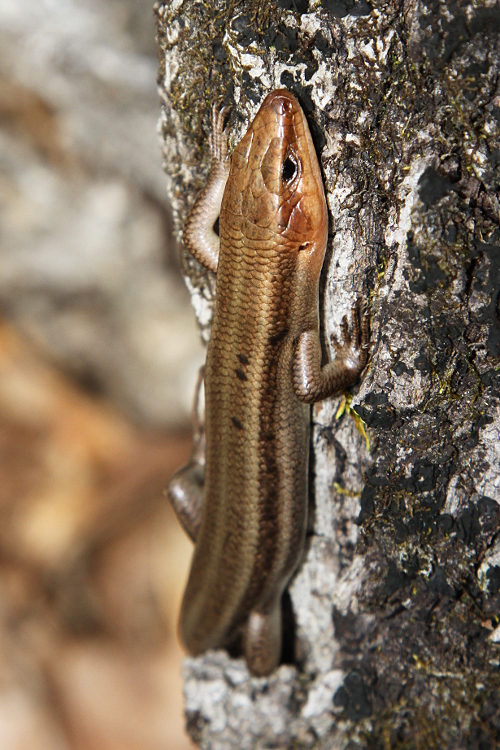
A Five-lined Skink (Eumeces fasciatus) found on a dead tree.
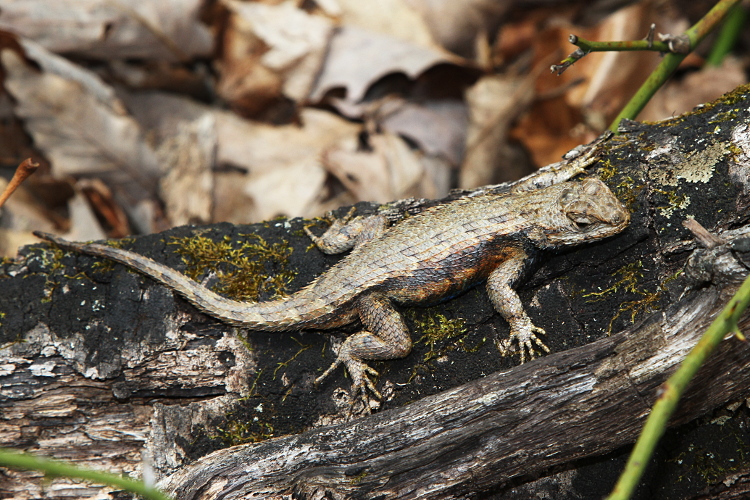
An Eastern Fence Lizard (Sceloporus undulatus), shown almost as
found on a log.
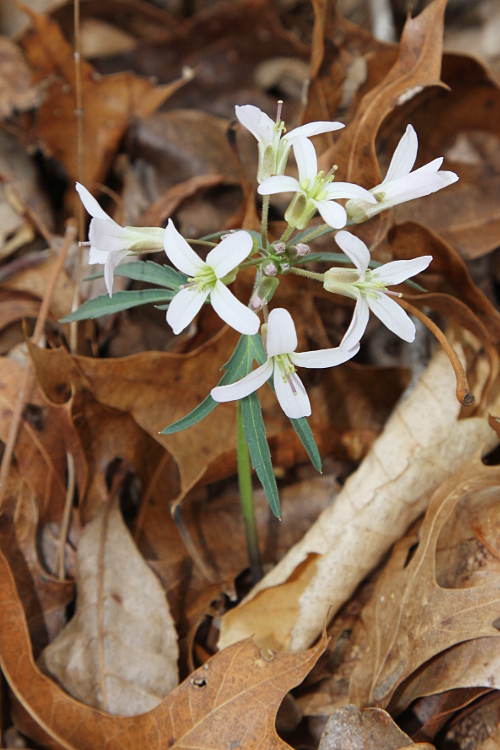
Cutleaf Toothwort (Cardamine concatenata).
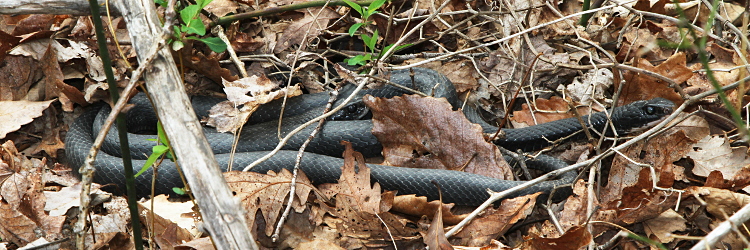
A pair of Black Racers (Coluber constrictor) found basking outside
their hibernaculum in late March.
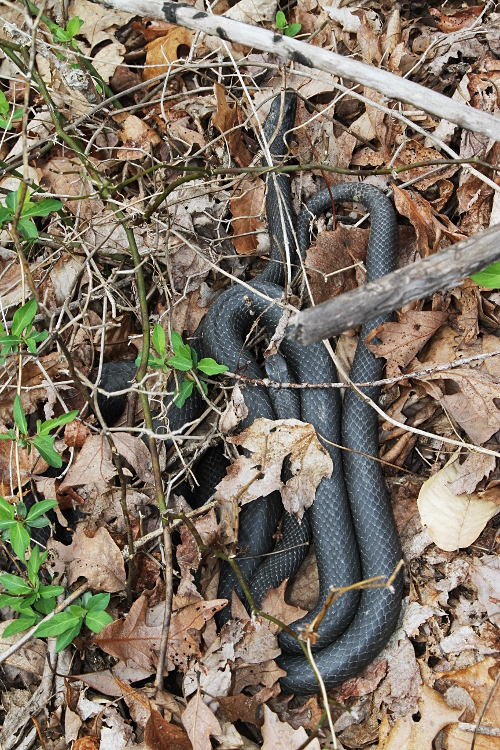
Another look at the racers.
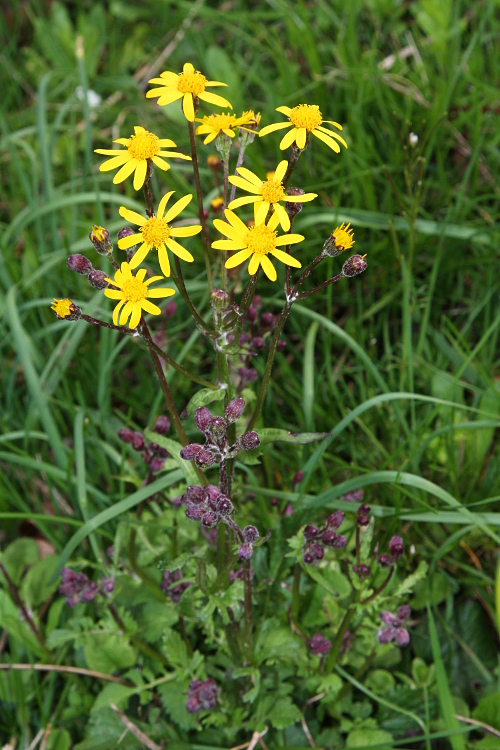
Golden Ragwort (Senecio aureus).
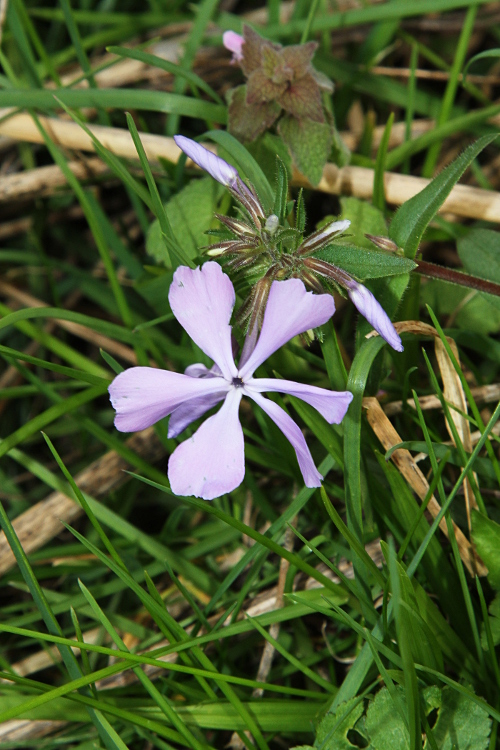
Blue Phlox (Phlox divaricata).
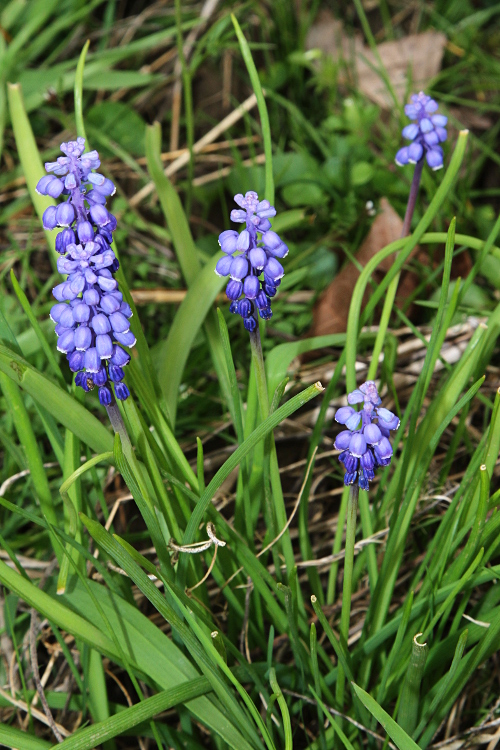
Grape Hyacinth (Muscari). This plant was found around an
abandoned homestead site and is not native to Ohio.
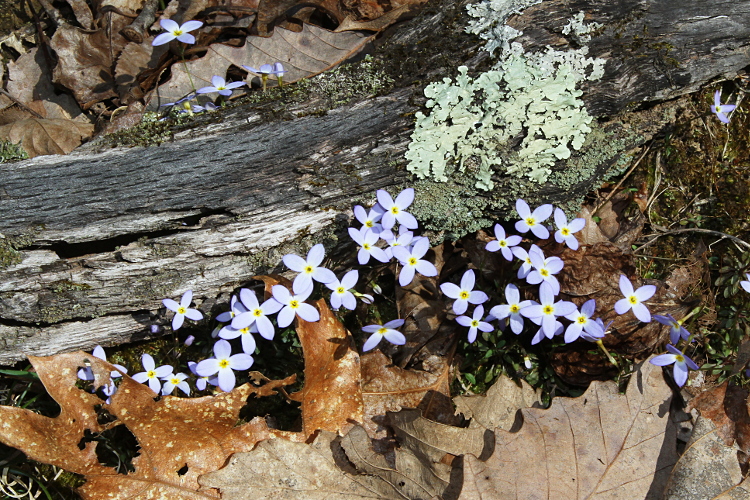
Azure Bluet (Houstonia caerulea).
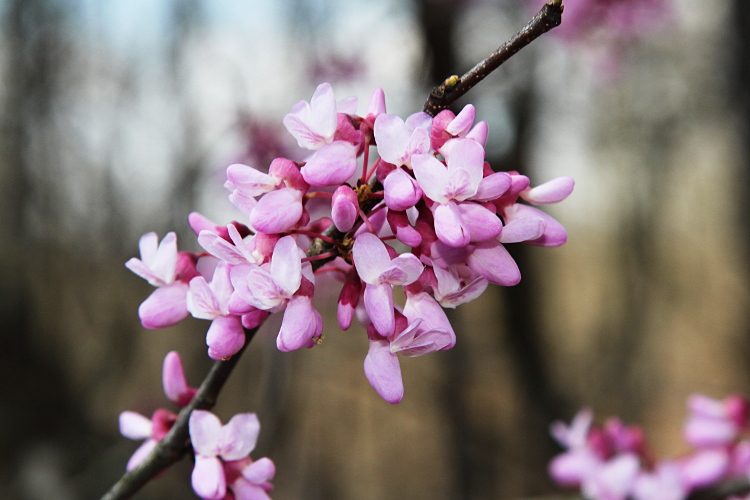
Eastern Redbud (Cercis canadensis), just starting to bud.
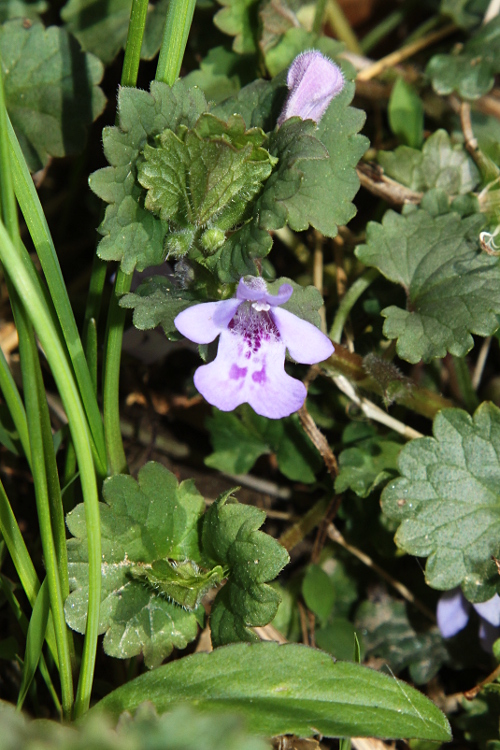
Ground Ivy (Glechoma hederacea). Another non-native found at
an old homestead site.
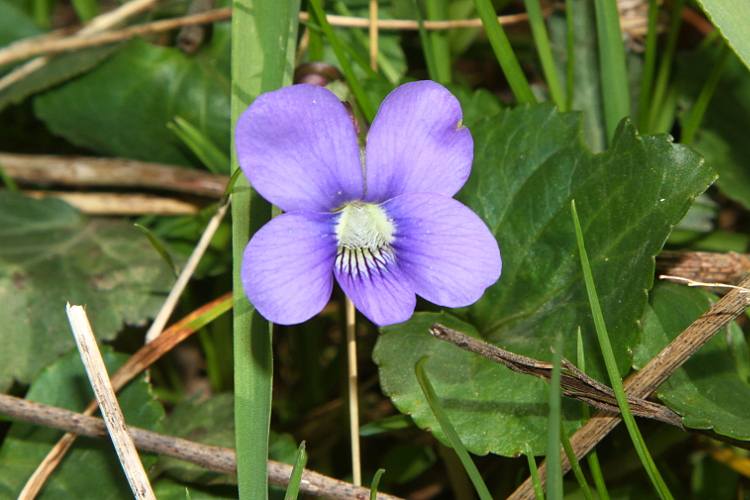
Common Blue Violet (Viola sororia).
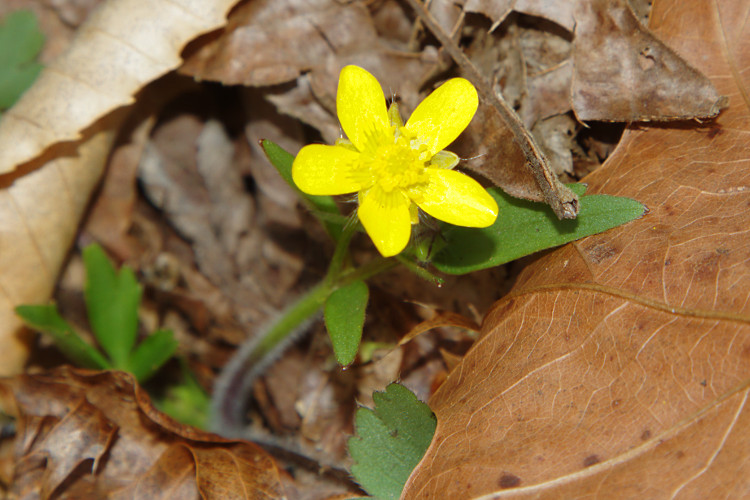
Bristly Buttercup (Ranunculus hispidus).
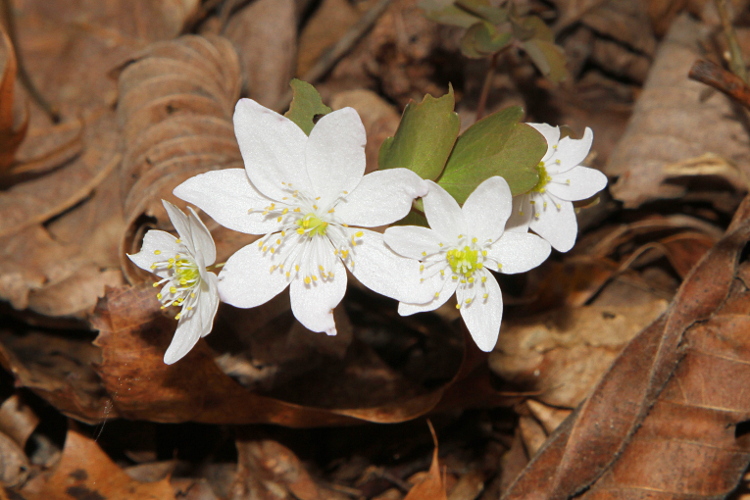
Rue Anemone (Thalictrum thalictroides).
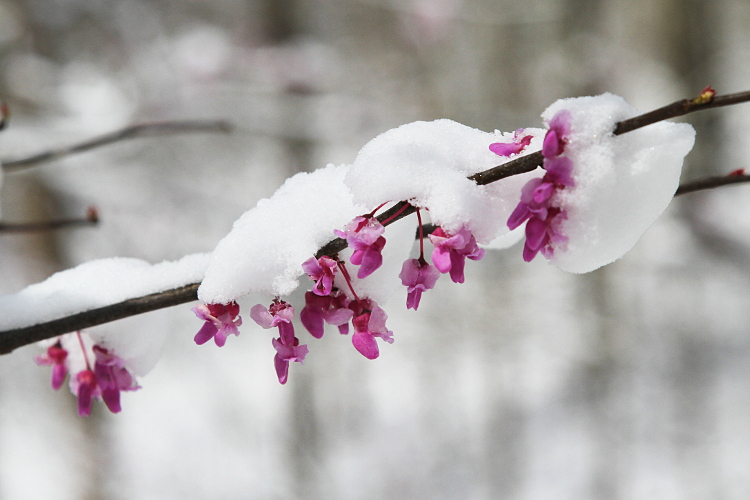
Redbuds in the snow. Snow is not welcome in the second week of April!
Wehrle's Salamander (Plethodon wehrlei) apparently does not
occur in Ohio, but it is present just over the Ohio River in West Virginia.
So cross the river we did. We were successful in finding
Wehrle's Salamander as well as several other species.
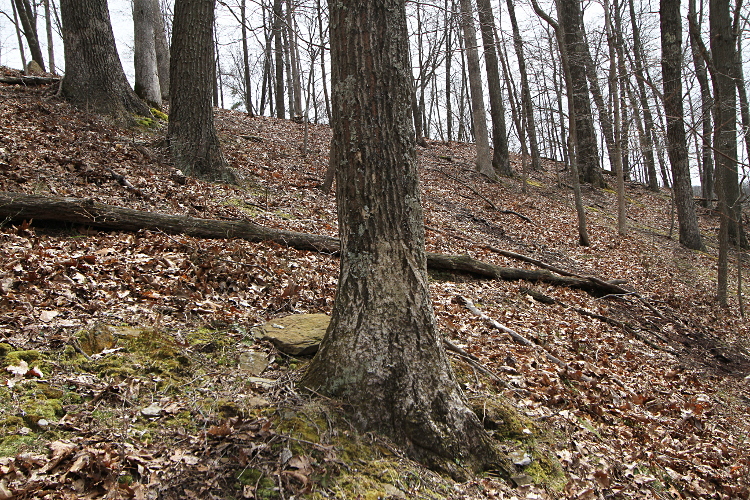
The habitat of Plethodon wehrlei and friends.
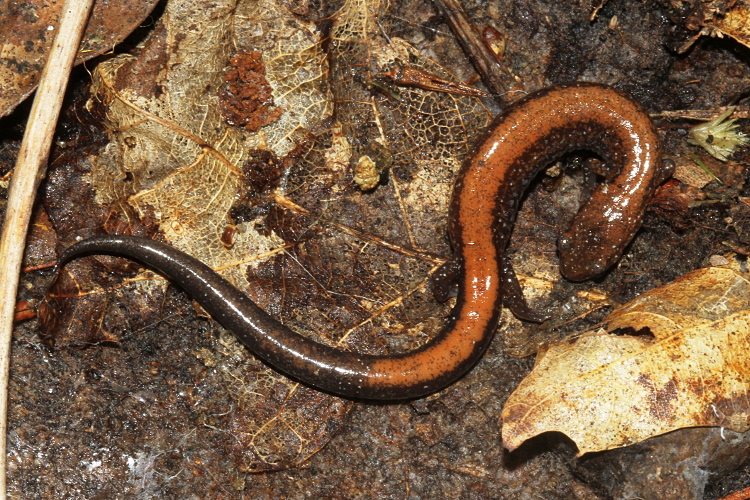
The first critter we saw was a
Red-backed Salamander (Plethodon cinereus).
We wound up seeing about a dozen of these.
Curiously, on the Ohio side of the Ohio River, instead of this species
you find the Ravine Salamander (Plethodon electromorphus).
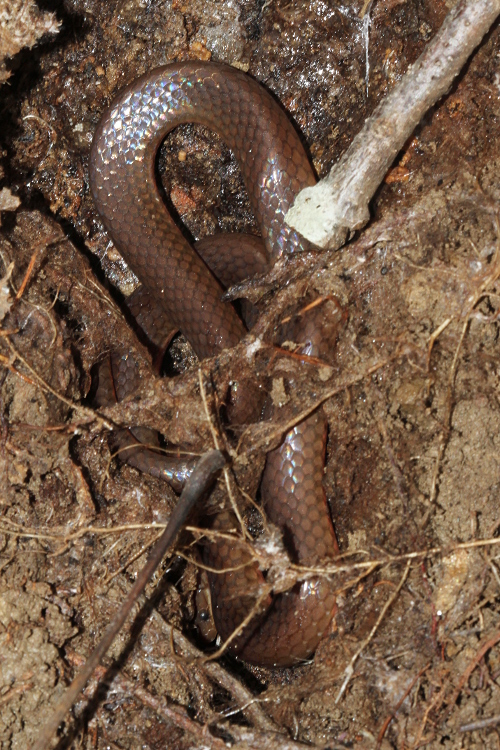
A Worm Snake (Carphophis amoenus), as found.
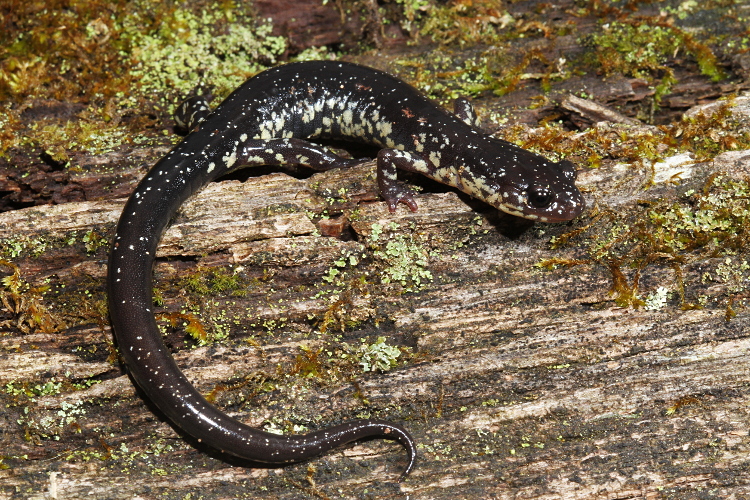
Wehrle's Salamander (Plethodon wehrlei).
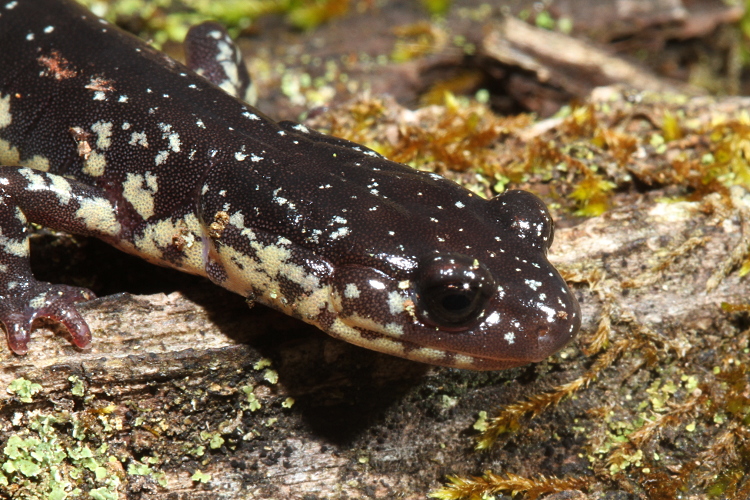
One more look. We wound up seeing three of them.
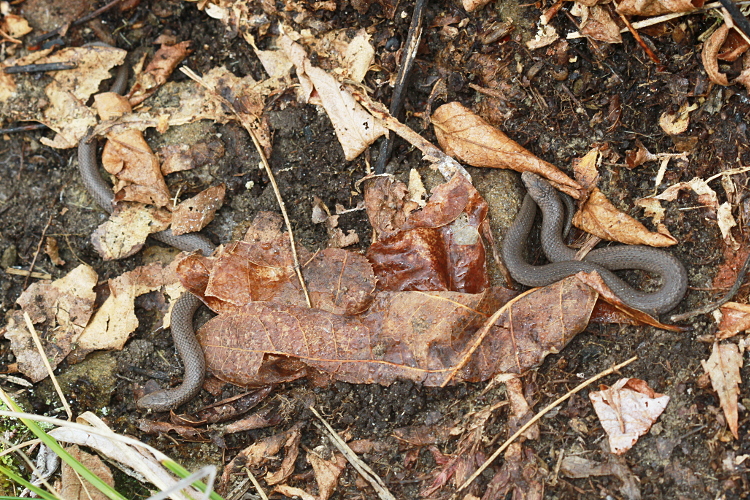
A pair of Smooth Earth Snakes (Virginia valeriae),
as found under a rock. These appear to be last year's babies.
It was a nice little out-of-state trip. We continue on in Ohio.
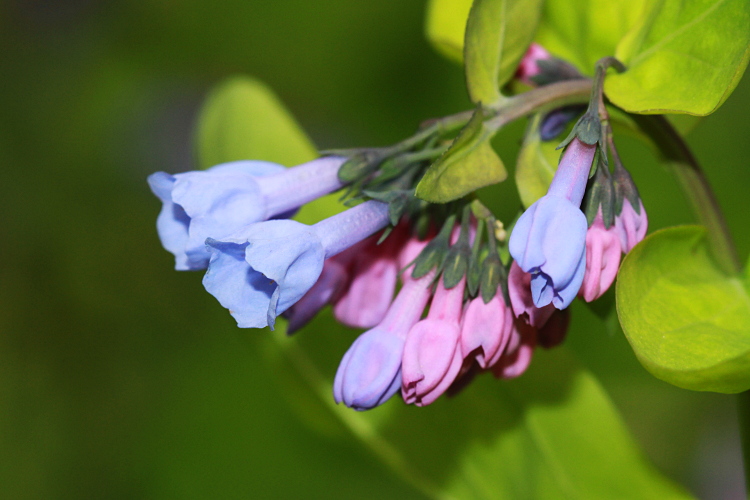
Virginia bluebells (Mertensia virginica).
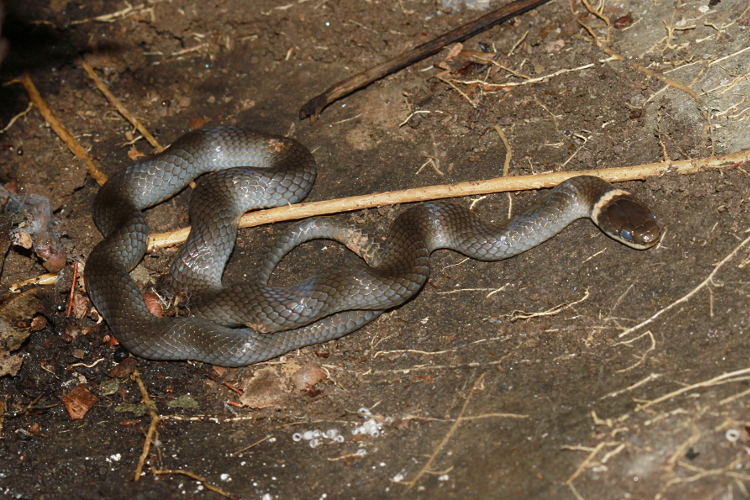
Ringneck Snake (Diadophis punctatus), as found under a rock slab.
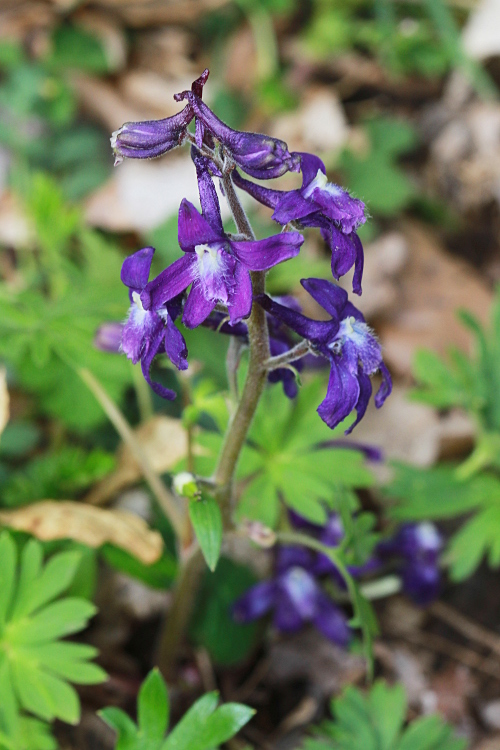
Dwarf Larkspur (Delphinium tricorne).

In the late spring of this year my region is going to experience an emergence
of periodical cicadas. It is a 17-year variety -- "Brood V".
The grubs (technically the final instar stage) were staging just below
the surface in mid April. Many were seen under rock slabs.
Hard to believe this guy is almost 17 years old.
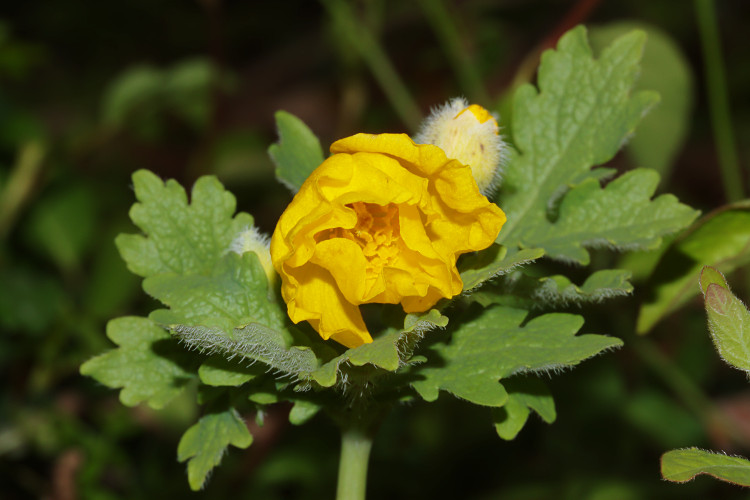
Wood Poppy (Stylophorum diphyllum).
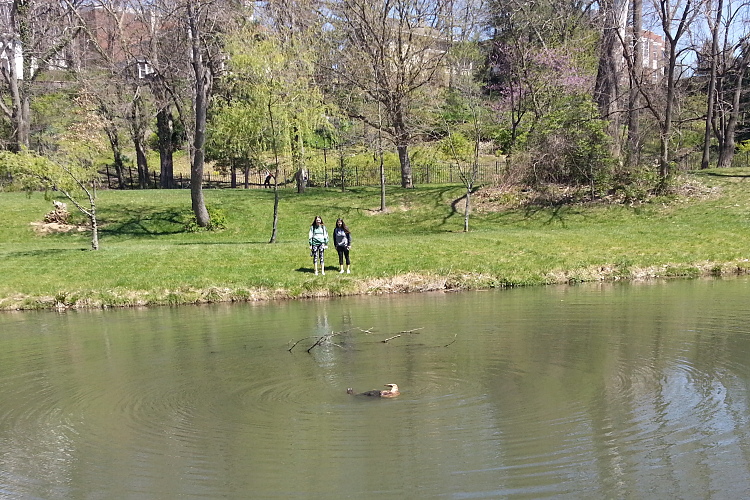
Some drama on campus seen in mid April. I saw these two good-sized
snapping turtles going at it in the pond by Baker Center just after lunch.
I'm pretty sure it was two males fighting. They went their separate ways
after about 3 minutes of wrestling on the surface of the water.
The students on the other side of the pond were likewise entertained.

The town of Pyro in Jackson County, Ohio has always
intrigued me. Probably because I was a bit of a pyro when I was kid
and perhaps I did not completely outgrow it (kind of like lizard hunting).
It turns out that Pyro started as a company town for the Pyro Clay Products
Company over a hundred years ago. They made firebricks and other refractory
items that could withstand high temperatures -- hence the name.
The clay in Jackson and neighboring counties is apparently very good for
this purpose and there were (and still are) several companies in the area in
this business. The refractories plant in Pyro is still there but it goes
by a different name now. I like how the church embraced the town name and
included flames on their sign. The "for sale" part is a bit sad.
Note added: about six months later, I noticed that the "for sale" stuff had
been removed from the sign and the times for services restored.
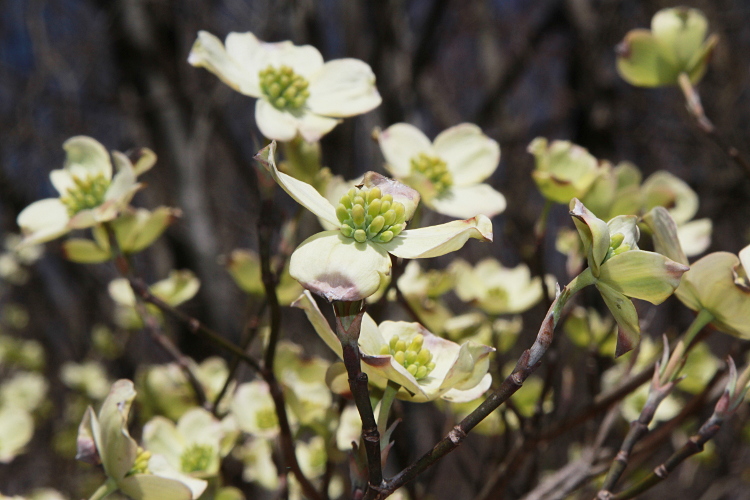
Dogwood (Cornus florida).
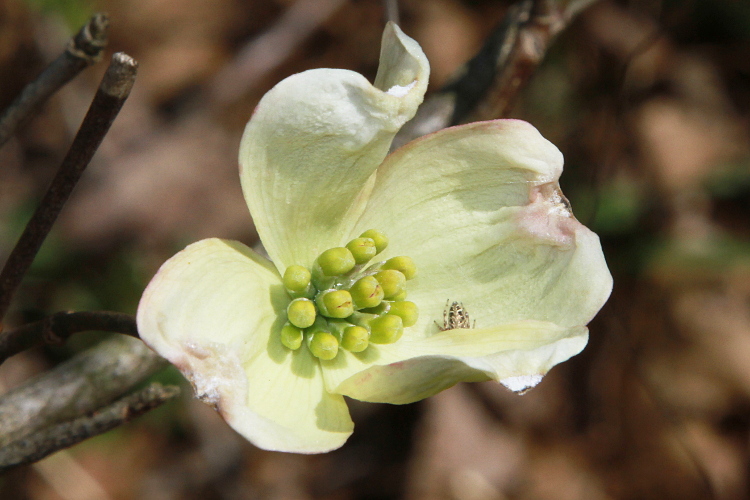
A closer look at a Dogwood flower.
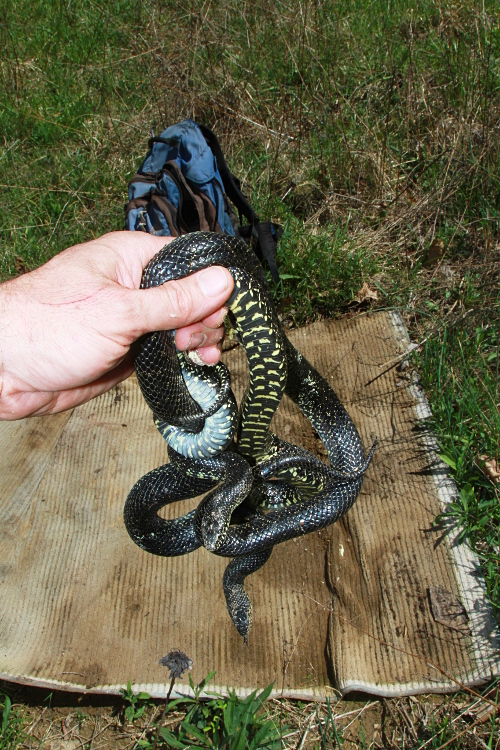
A pair of Black Kingsnakes (Lampropeltis getula nigra) found
between folds of a carpet.
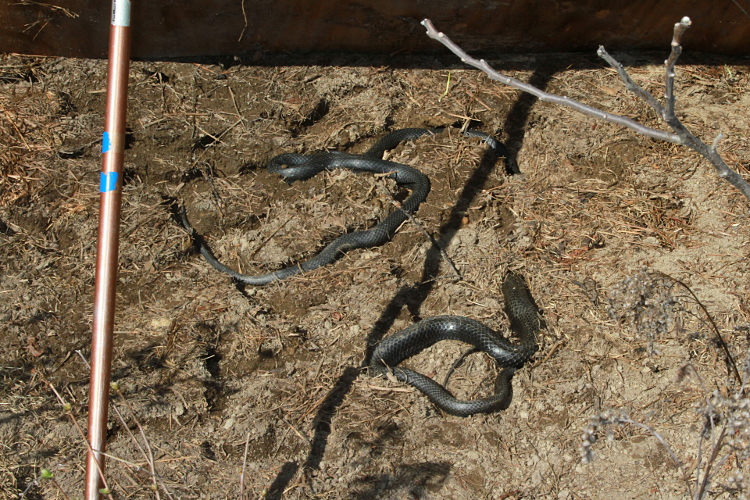
A pair of Black Racers (Coluber constrictor), as found
under a board.
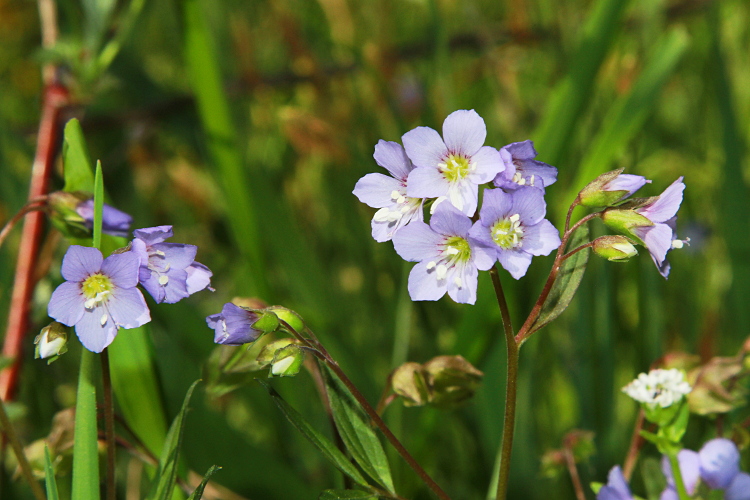
Jacob's Ladder (Polemonium reptans).
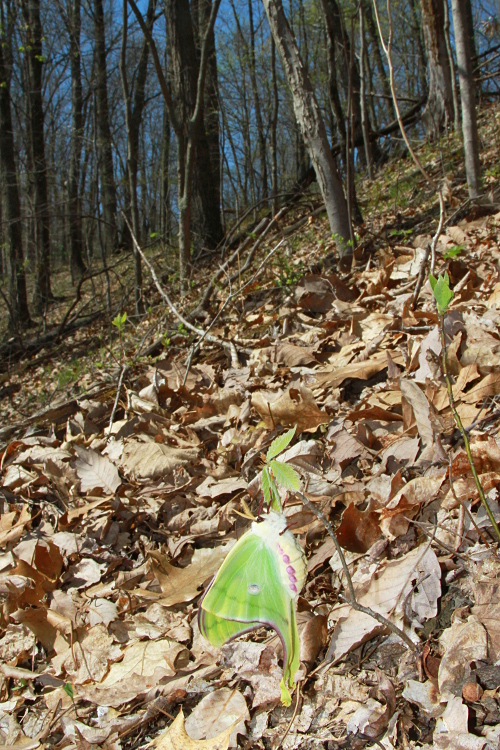
A Luna Moth, shown as found. I suspect that it had just emerged from its
cocoon and crawled up on this baby tree to fill its wings and wait for
nightfall. Apparently they overwinter in their cocoon in the leaf litter.
Very symbolic of spring!
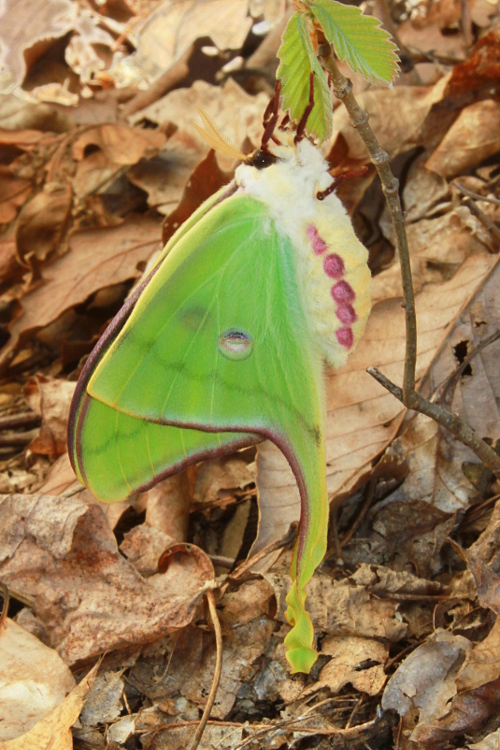
A closer look at the Luna Moth. It's interesting that it has its wings in
the closed position, which is not the usual posture for moths.
I suspect this is because it just filled its wings -- maybe it is still in
the process.
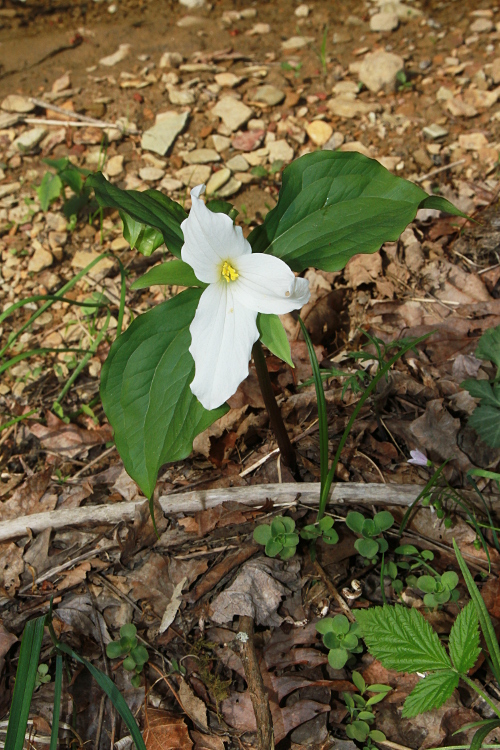
Great White Trillium (Trillium grandiflorum).
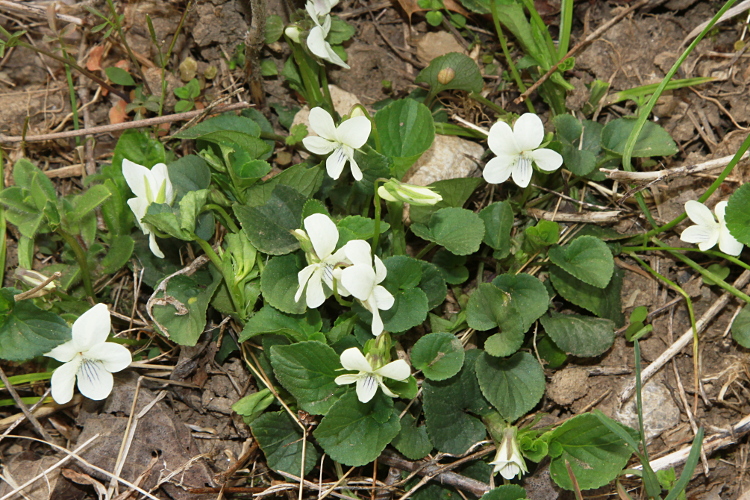
Violets of some sort.
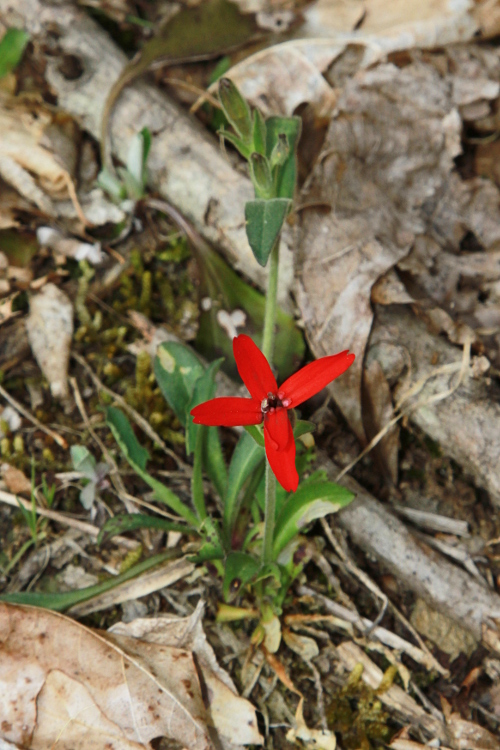
Fire Pink (Silene virginica).
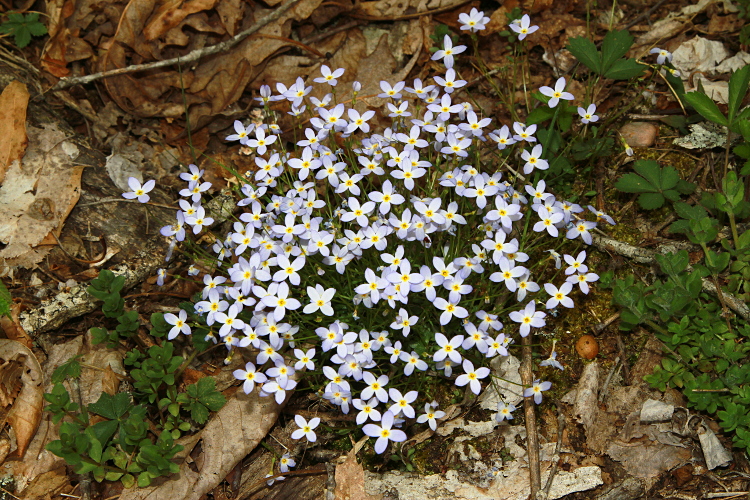
Azure Bluet (Houstonia caerulea).
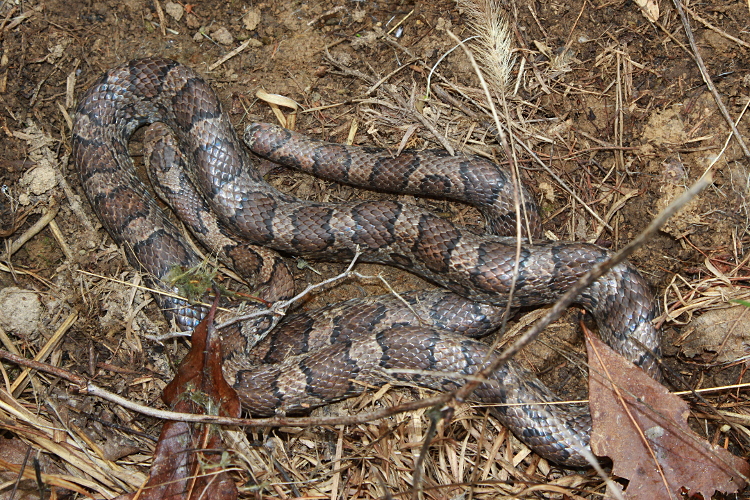
A stump-tailed Milksnake (Lampropeltis triangulum), as found
under cover.
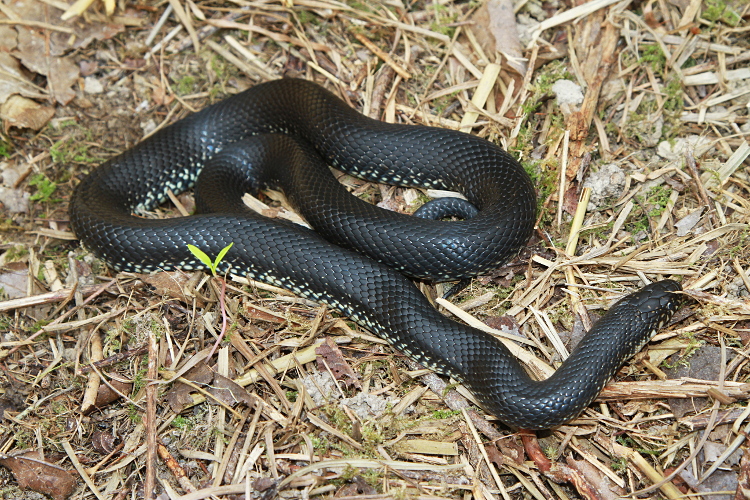
A nice Black Kingsnake (Lampropeltis getula nigra), as found
under a board. Black Satin.
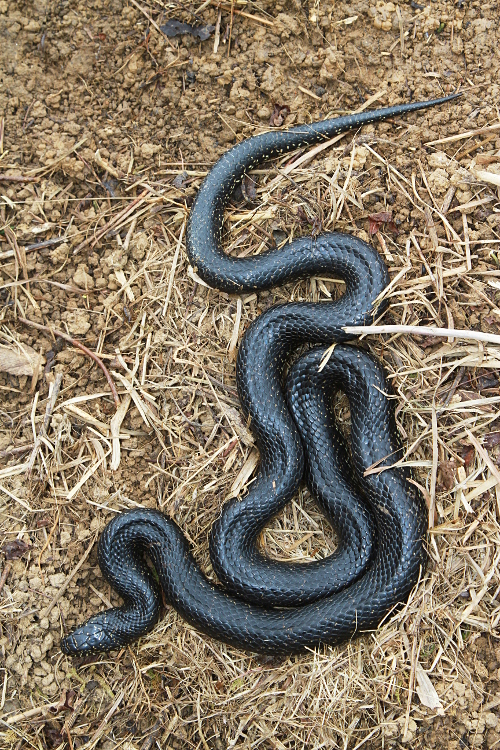
Another Black Kingsnake found on the same day, as found under cover.
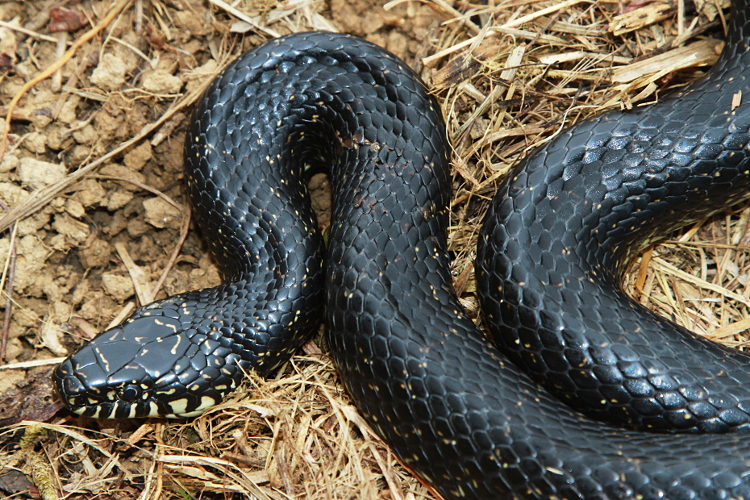
A closer look.
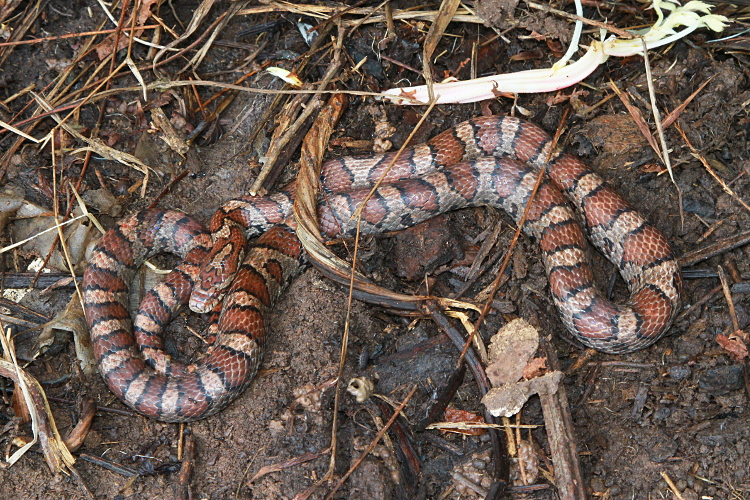
An attractive Milksnake (Lampropeltis triangulum), shown as found.
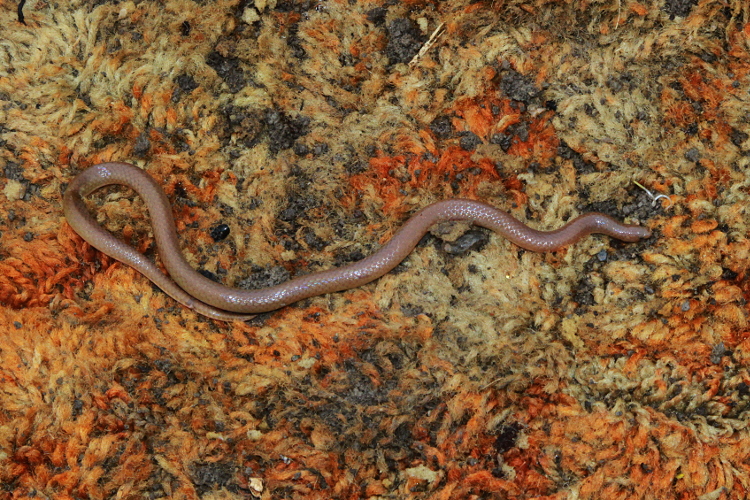
A Worm Snake (Carphophis amoenus), as revealed between folds
of a carpet.
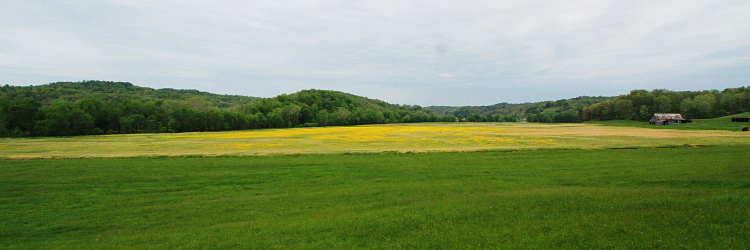
Beautiful green and gold fields in the springtime.
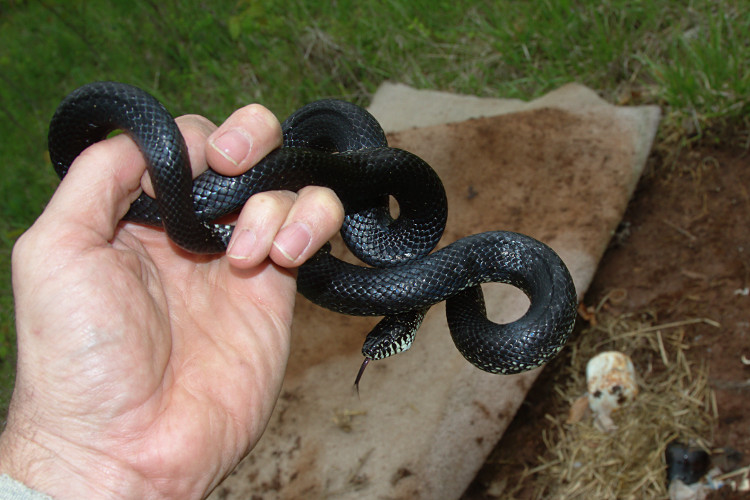
A Black Kingsnake (Lampropeltis getula nigra) found under carpet.
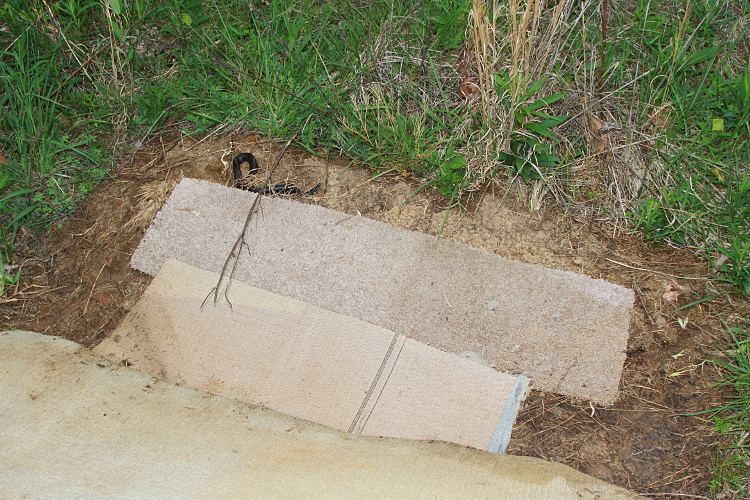
A different Black Kingsnake, shown as found.
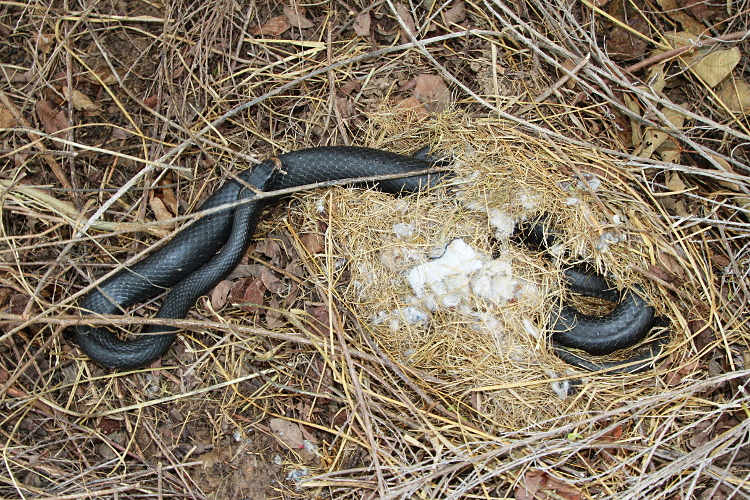
A Black Racer (Coluber constrictor), shown as found in a rodent nest
under the box springs of a discarded bed. My guess is that the maker of the
nest is now in the belly of the snake...
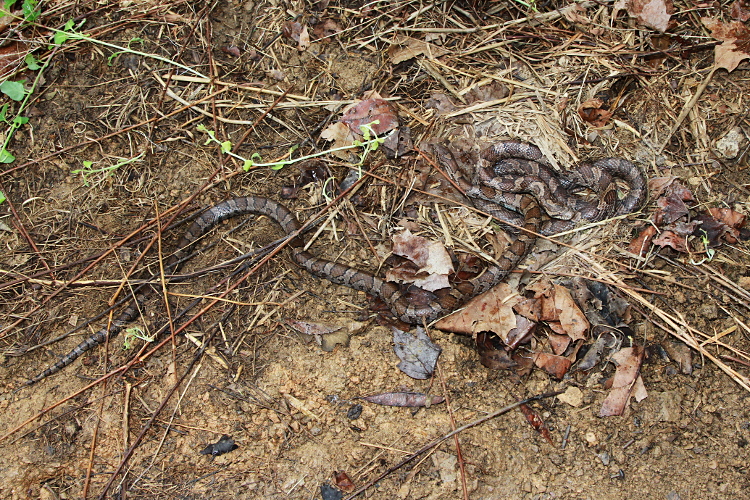
A pair of Milksnakes (Lampropeltis triangulum),
as found under a board.
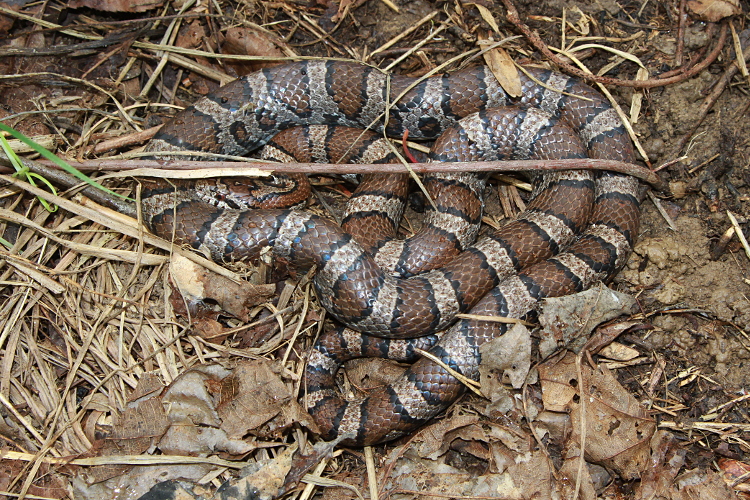
Another Milksnake, shown as found.
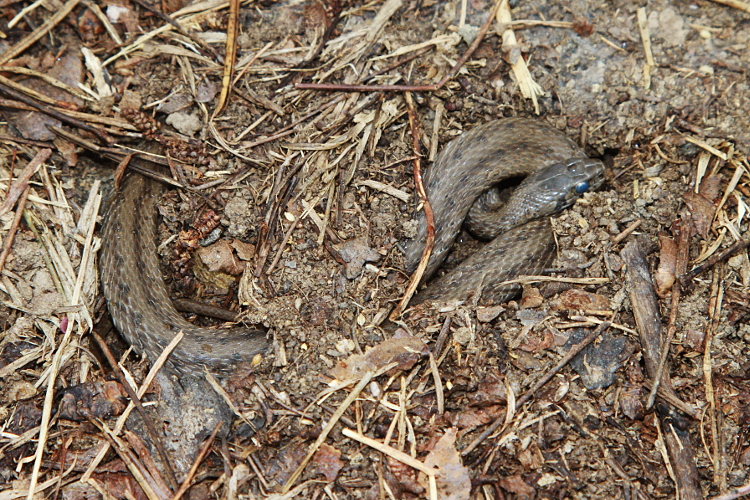
A Dekay's Snake (Storeria dekayi), as found under cover.
It is in pre-shed condition.
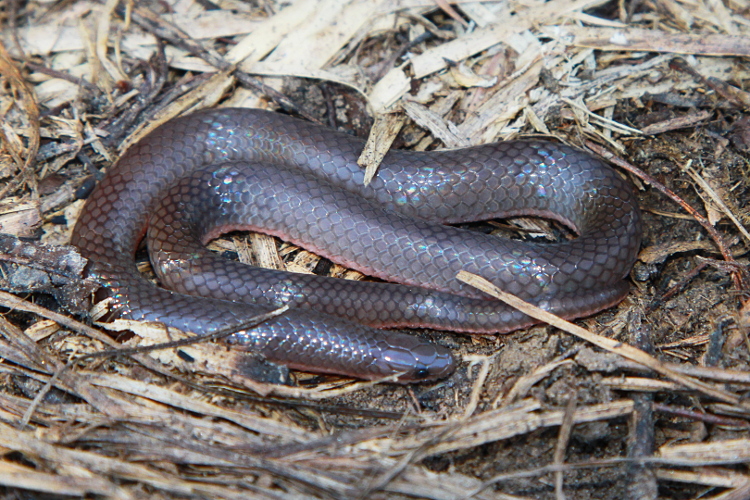
A Worm Snake (Carphophis amoenus), as found under cover.
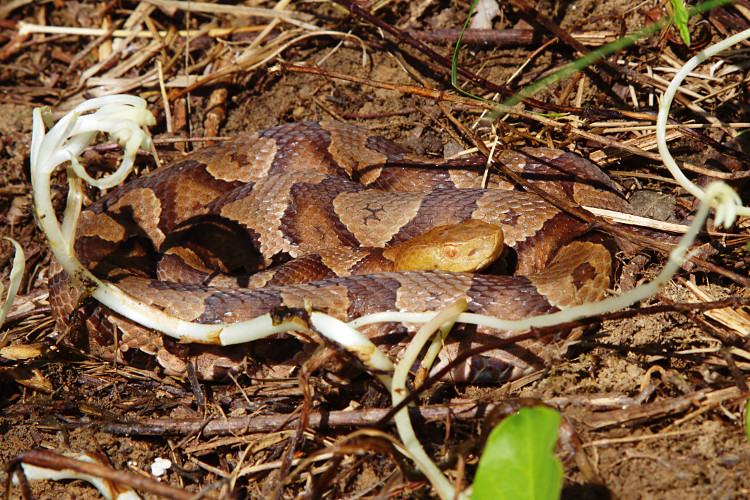
A Copperhead (Agkistrodon contortrix), as found under a sheet of carpet.
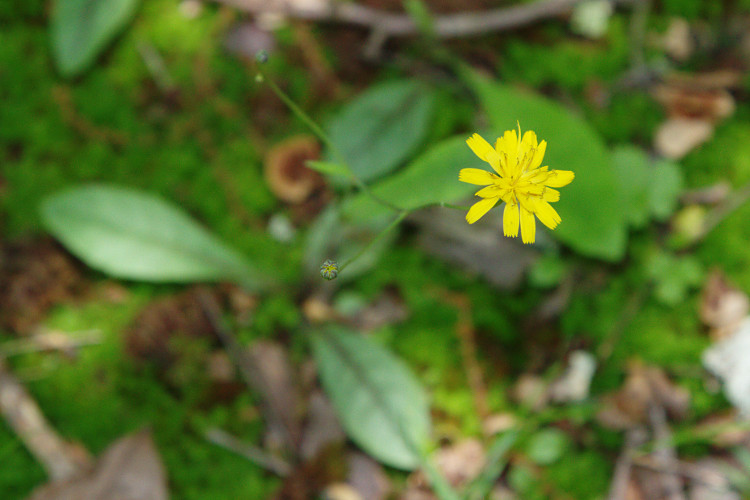
Rattlesnake Weed (Hieracium venosum).
The only thing missing is the rattlesnake.
In late May and early June we experienced the emergence of the
17-year periodical cicada (Magicicada sp.) in southeast Ohio.
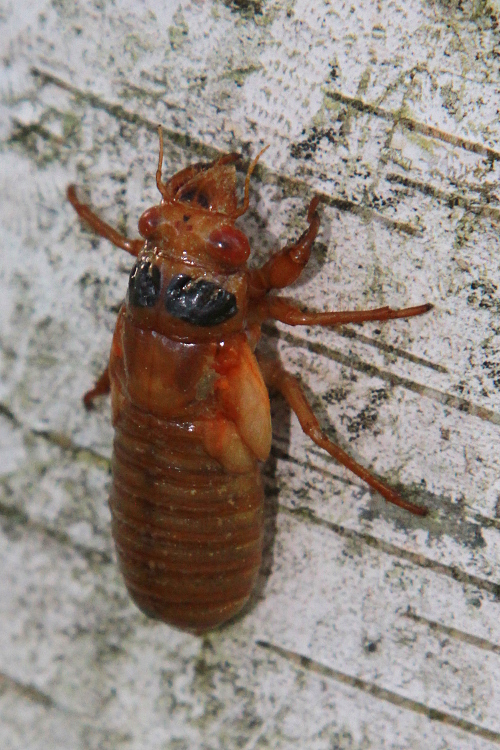
They crawl out of the ground as grubs, the final instar stage. They are
about an inch long. They climb up trees and other vegetation.
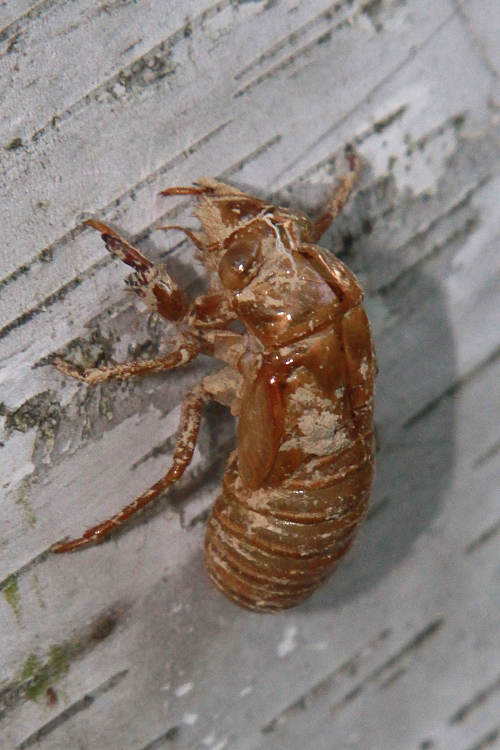
At some point they stop and crawl out of their shell. This is what a shell
looks like after the adult cicada has left. Note the split where it
crawled out.
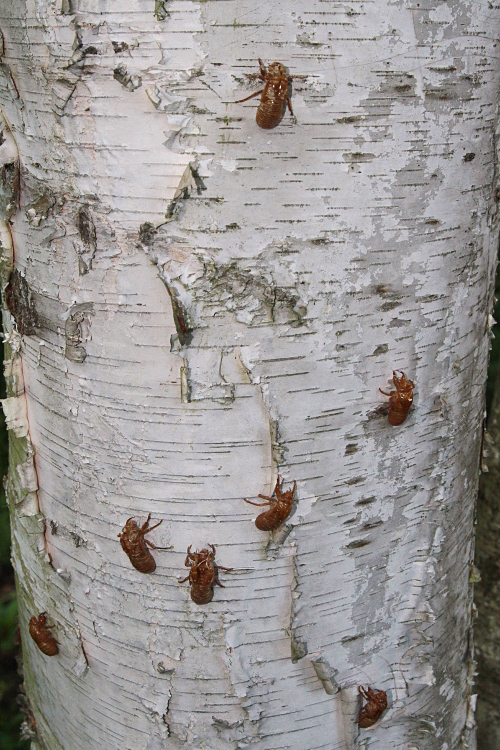
There are a lot of left over shells.
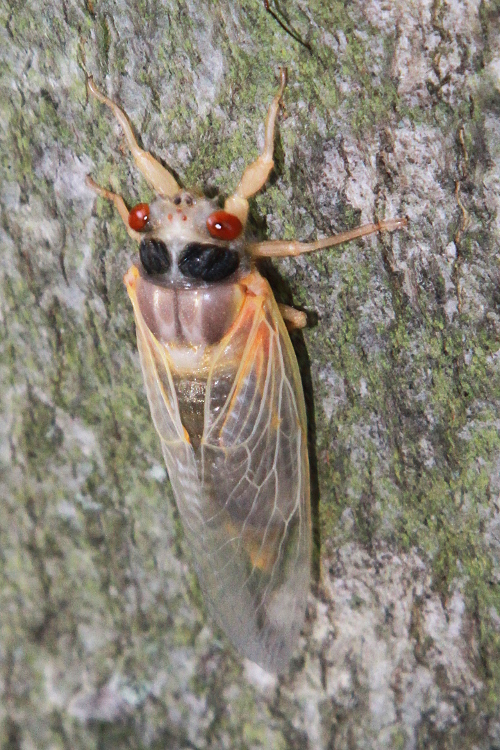
When they first come out they are a light color.
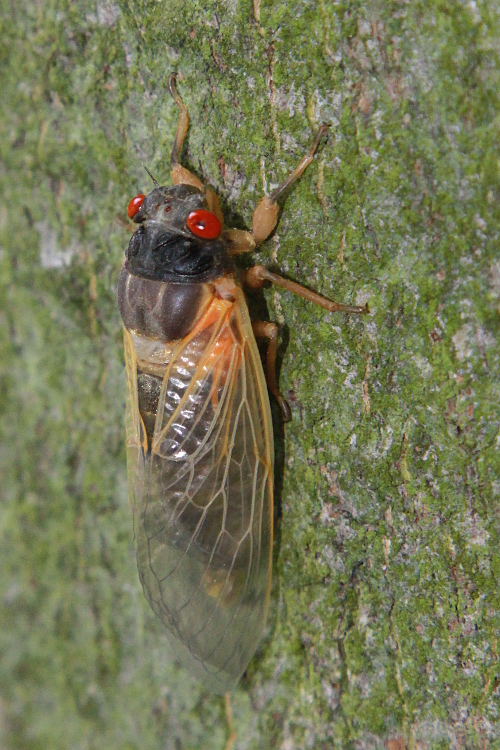
They quickly get darker.
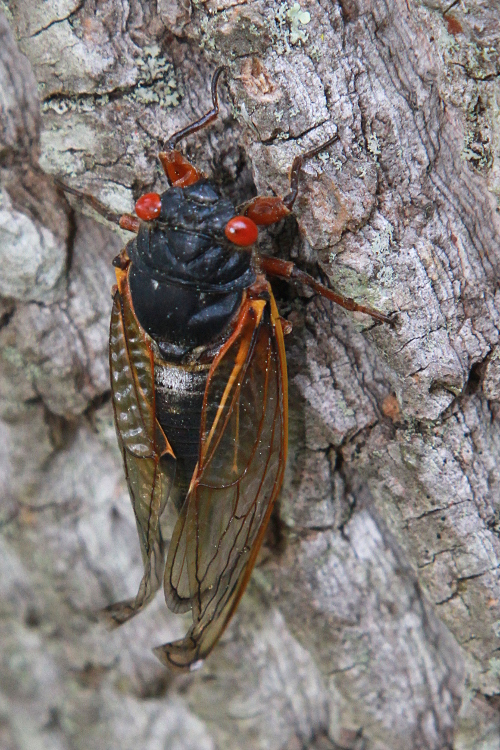
An adult cicada, ready to breed and repeat the cycle.
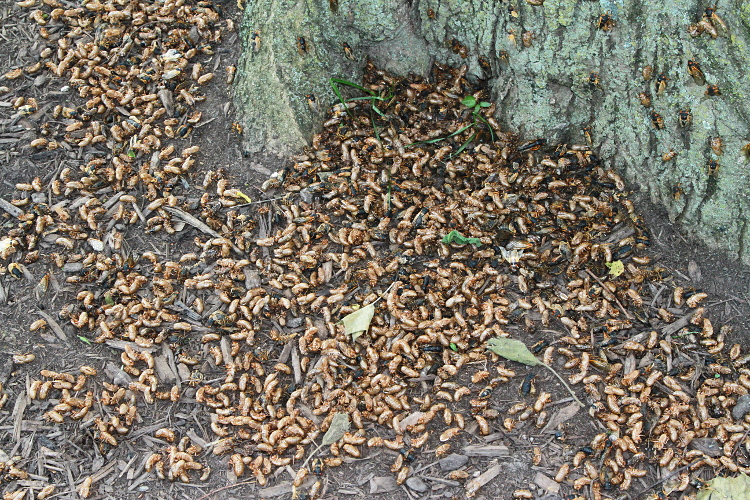
There are really a lot of left over shells.
The adults then start flying around. It seems that most of them
wind up in the tree tops. Where they make lots of noise.
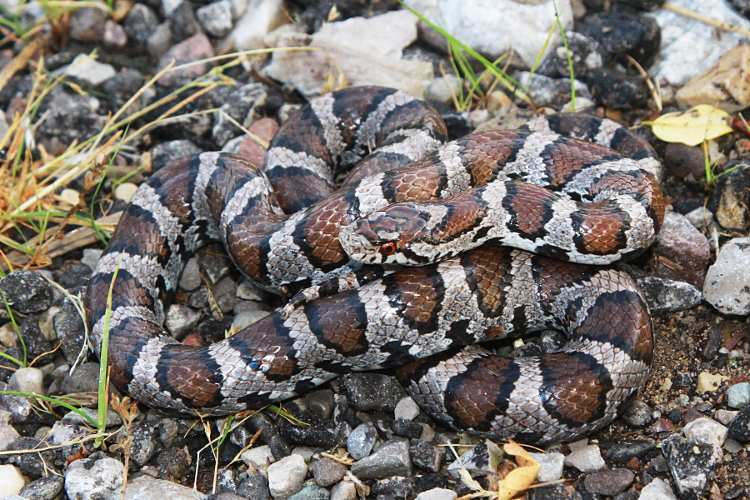
A Milksnake (Lampropeltis triangulum). I found this one at a spot
I drive by all the time but have not checked in about 10 years.
Good memories of friends and snakes.
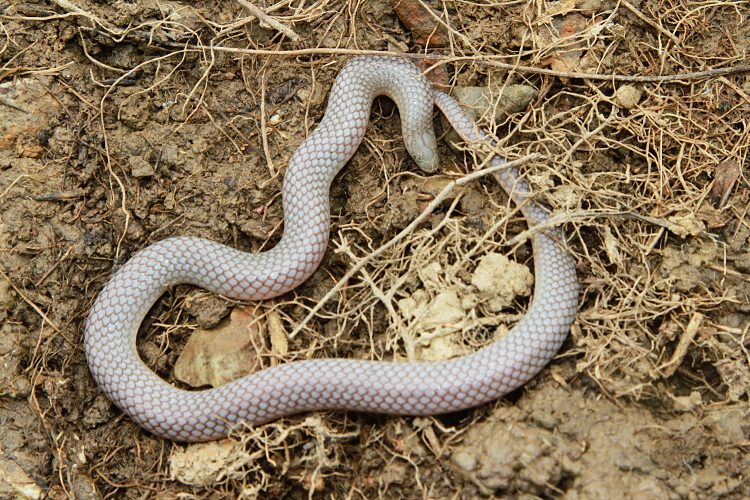
One normally does not think of snakes in the midst of their shed cycle as
being attractive (bad hair day), but I thought this
Worm Snake (Carphophis amoenus) was quite stunning. Shown as found.
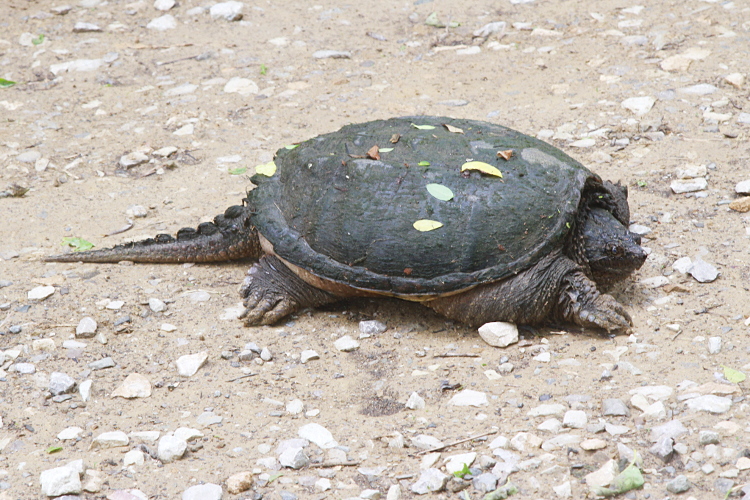
A large Snapping Turtle (Chelydra serpentina), as found crossing
a road.
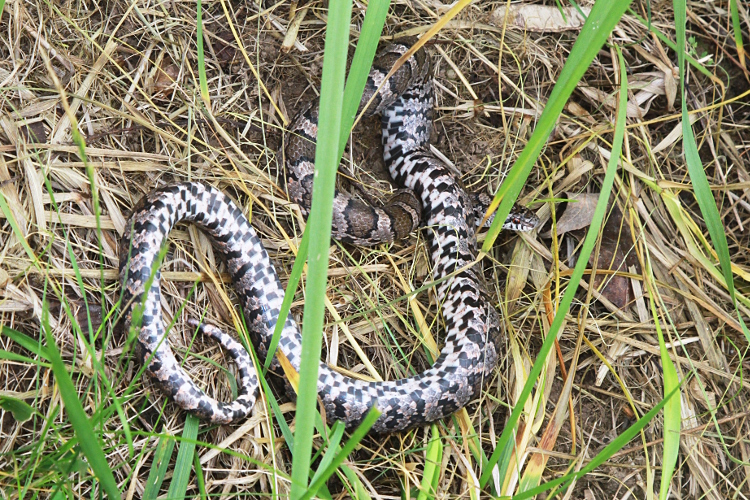
A Milksnake (Lampropeltis triangulum), as flipped.
When I lifted the cover it was under, some vegetation was also lifted,
which flipped the snake over. So it really is as flipped...
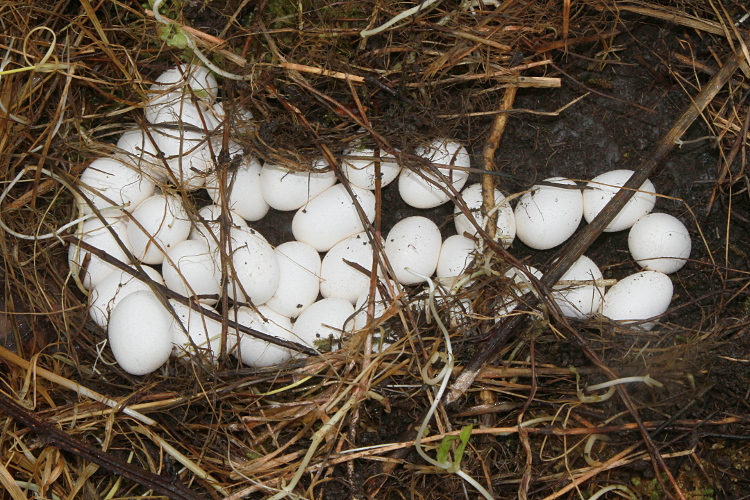
A clutch of Black Racer (Coluber constrictor) eggs found under carpet
on June 2.
I counted around 36 of them, which seems like an awful lot for one snake.
Do they nest communally? Or maybe it was just a Big Mama.
For scale, the longest dimension of each egg is about 1.25''.
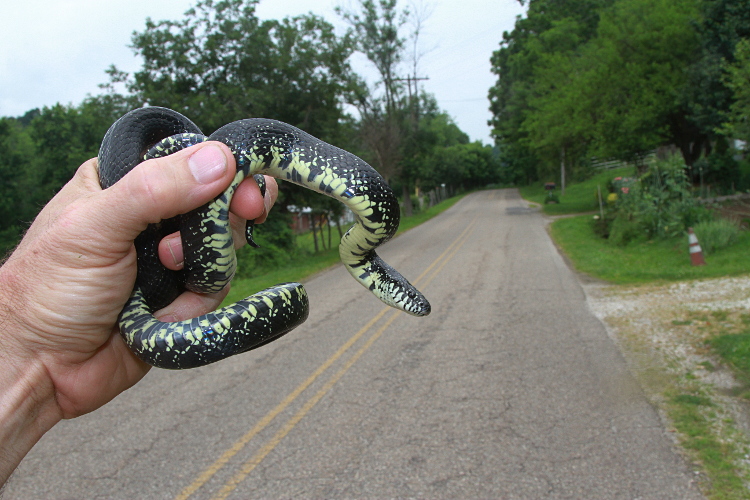
A Black Kingsnake (Lampropeltis getula nigra) found crossing the
road driving between sites. In a new area for me. The photo shows the
situation, houses along both sides of the road.
These snakes seem to live along side people pretty effectively.
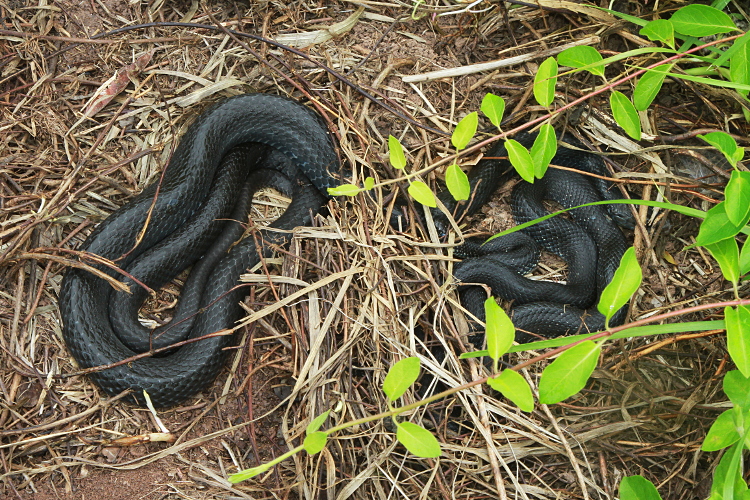
A Black Racer (Coluber constrictor, on the left) and
a Black Kingsnake (Lampropeltis getula nigra, on the right).
Shown as revealed.
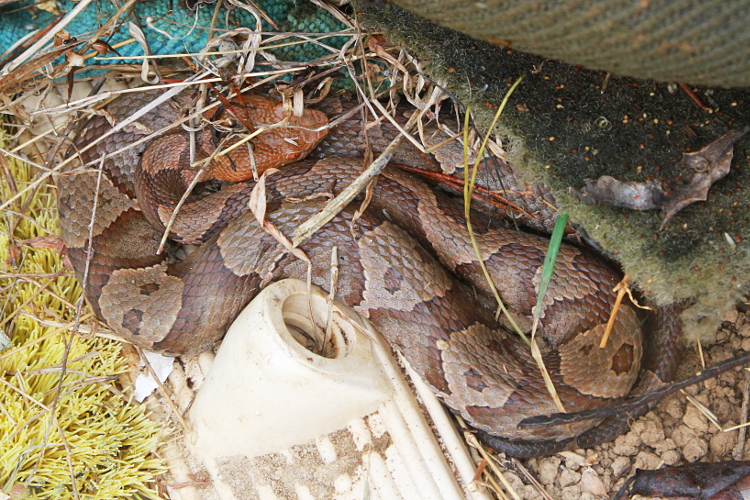
A Copperhead (Agkistrodon contortrix), as found in a trash pile.
Some dubious color coordination going on here.
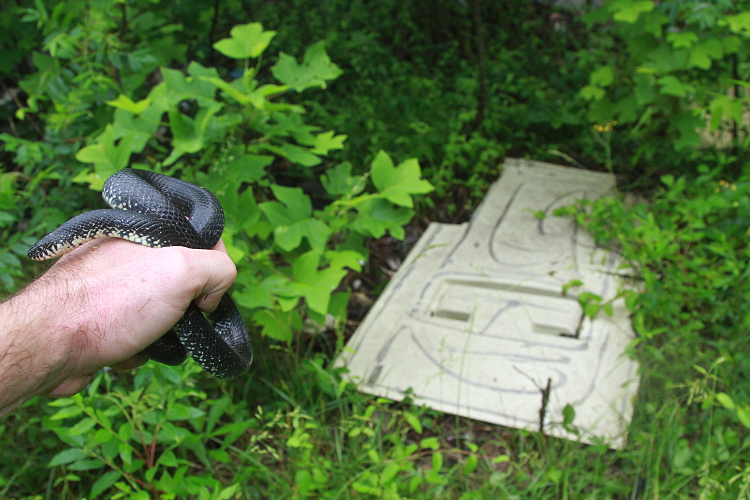
A Black Kingsnake (Lampropeltis getula nigra).
It was found under the big sheet of plastic in the background -- I think it
was part of a shower in its former life.
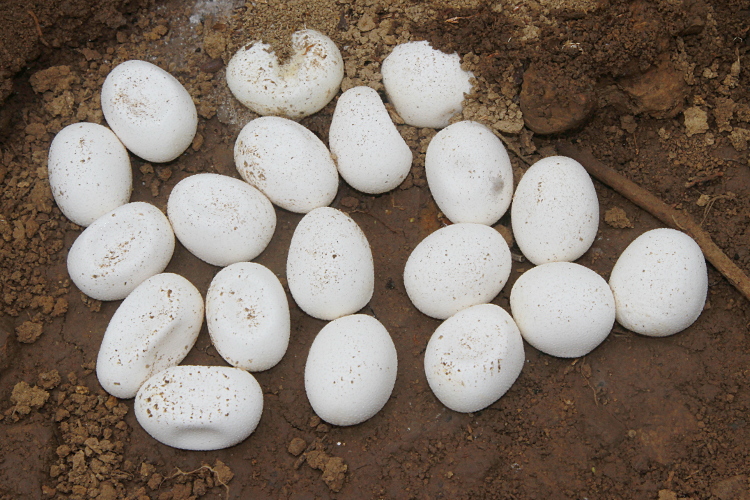
Another clutch of Black Racer (Coluber constrictor) eggs see on June 2.
They were found under a large sheet of carpet located in full sun.

A closer look at the eggs.
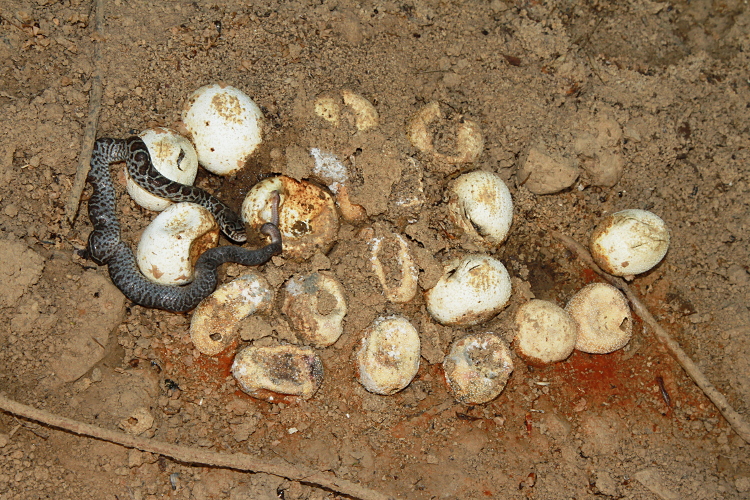
On August 5 I checked on these eggs again. They were hatching.
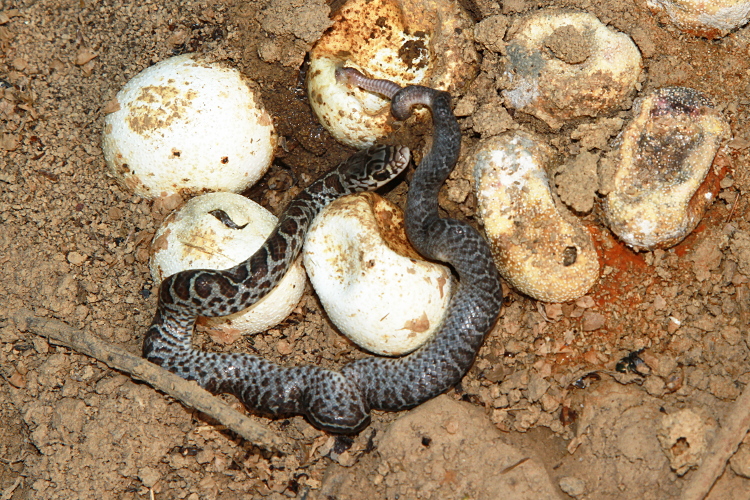
A closer look. Unfortunately, this baby racer appears to be deformed.
High egg incubation temperatures are known to increase the chance of
deformities in baby snakes. Considering the location of this carpet,
that may well be what happened here.
Now back to chronological order (early June).
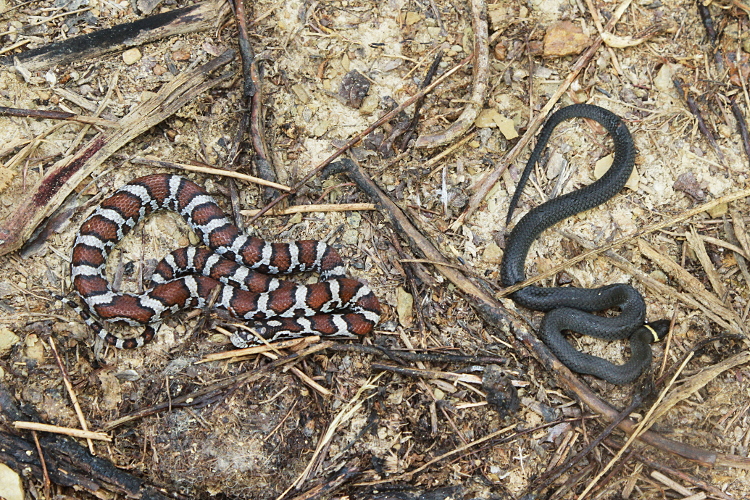
A young Milksnake (Lampropeltis triangulum, on the left) and
a Ringneck Snake (Diadophis punctatus, on the right),
as found under carpet.
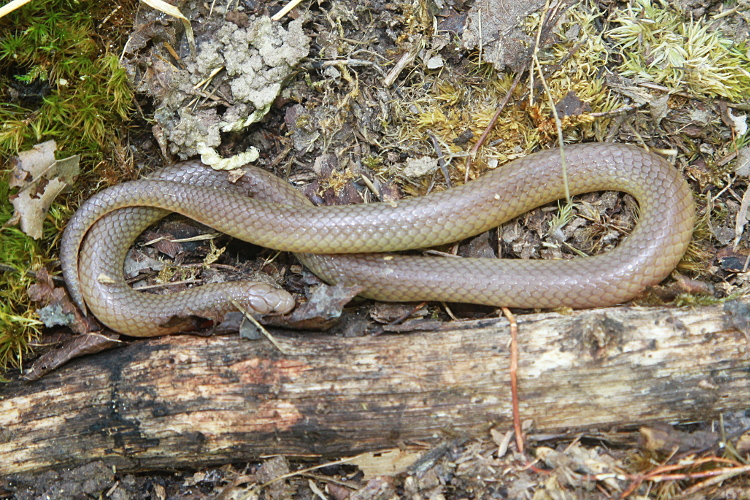
A Worm Snake (Carphophis amoenus), as found under cover.
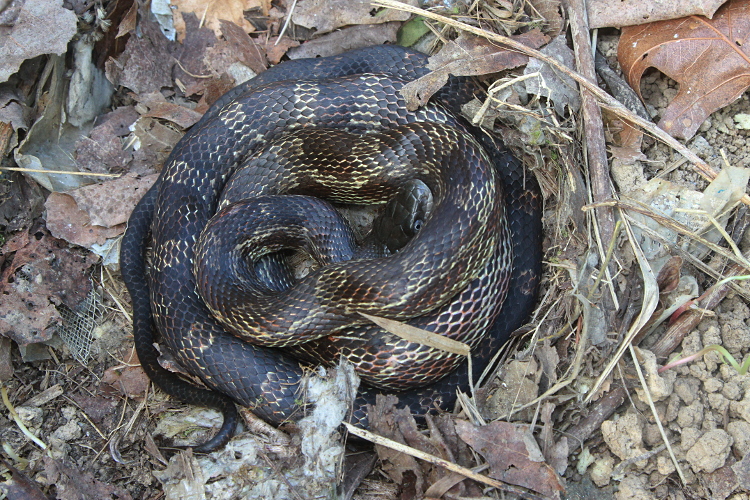
A Black Ratsnake (Elaphe obsoleta), almost as found under cover.
I think it pulled its head down inside its coil a little bit.
Also note that it is coiled in a rodent nest -- makes one wonder what all
has transpired here.
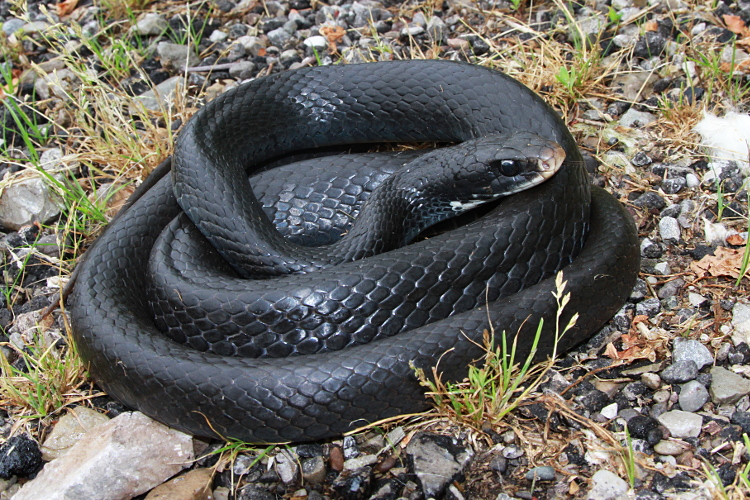
A Black Racer (Coluber constrictor). This is a posed photo,
something I rarely do any more.
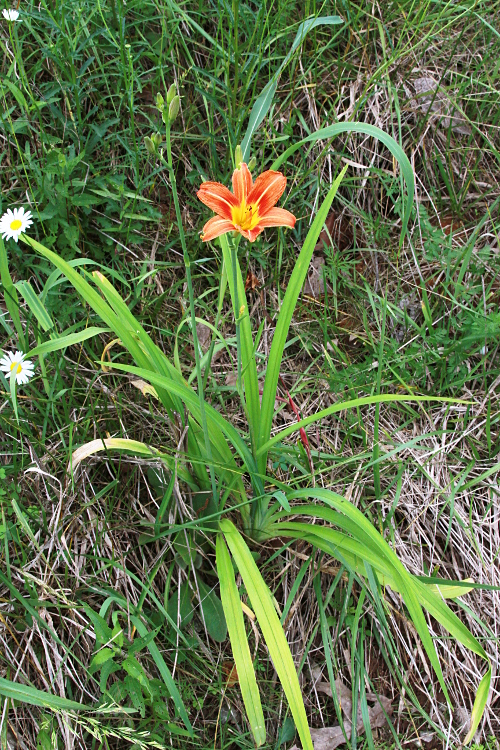
Ditch Lily (Hemerocallis fulva).
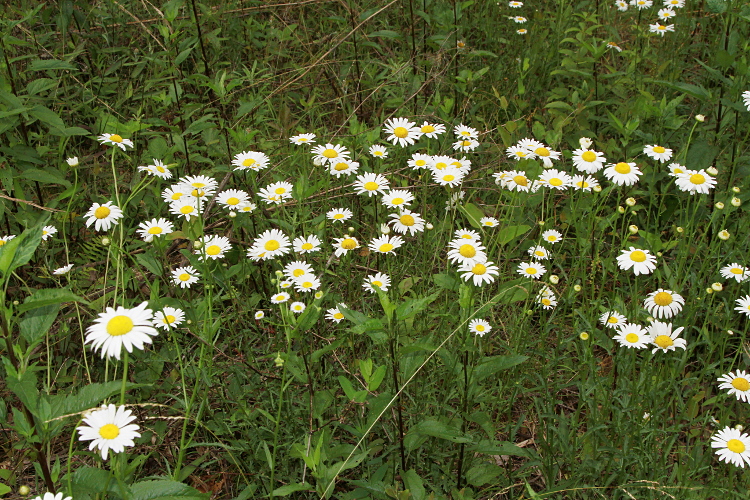
Ox-eye Daisies (Leucanthemum vulgare).
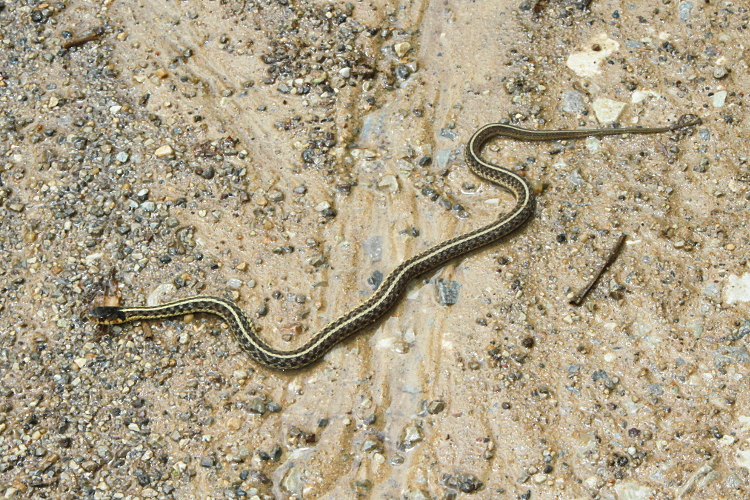
A young Common Gartersnake (Thamnophis sirtalis), as found
on a dirt road just after a thunderstorm.
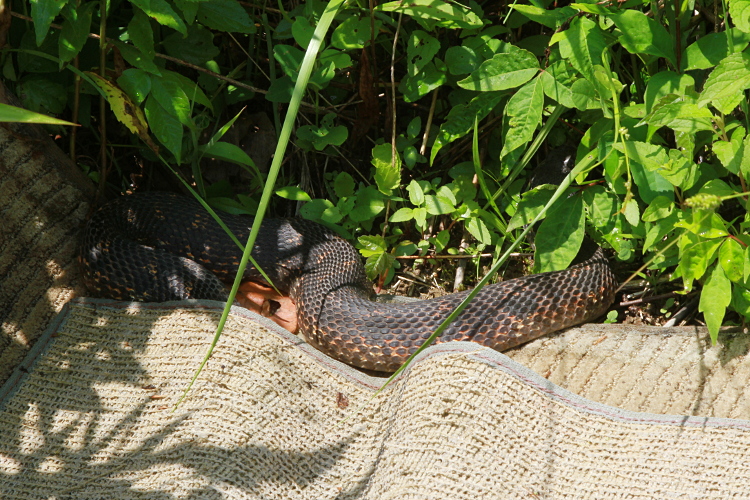
I walked up on this one day. Made my day.
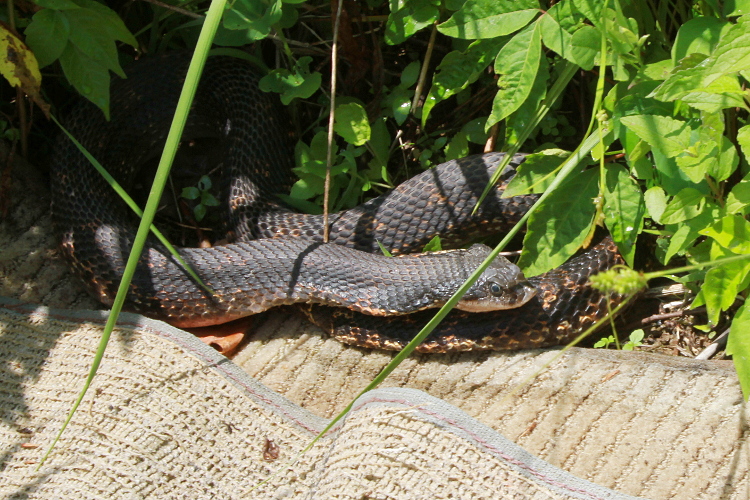
After the snake moved around some.
It is an Eastern Hog-nosed Snake (Heterodon platirhinos).
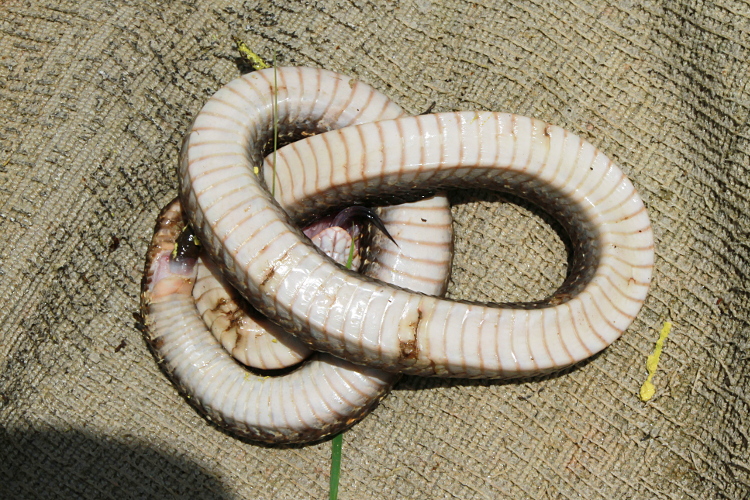
It played dead after I cut off its escape route.
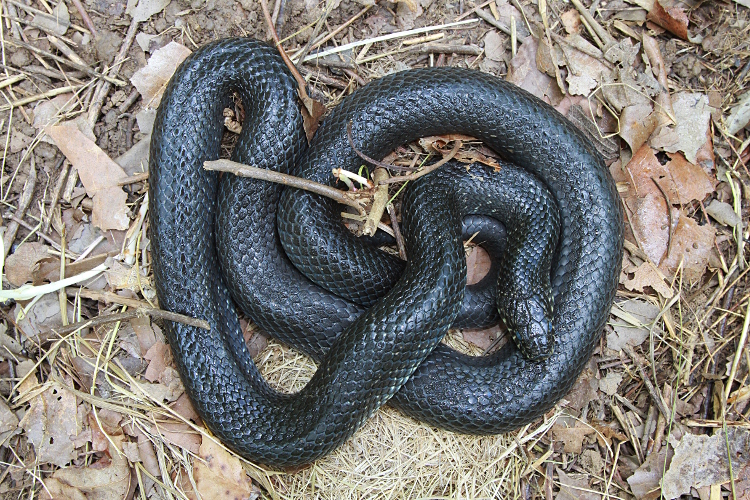
A Black Kingsnake (Lampropeltis getula nigra), as found under a board.
In is in its shed cycle and is also covered with condensation droplets.
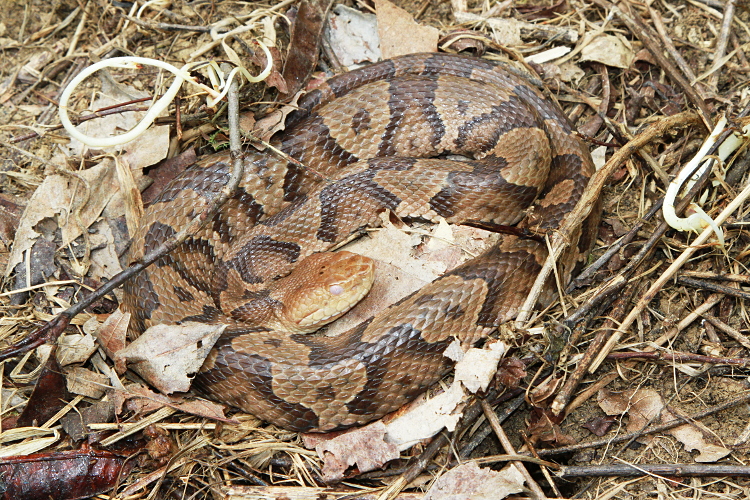
A Copperhead (Agkistrodon contortrix), as found under cover.
It is in its shed cycle.
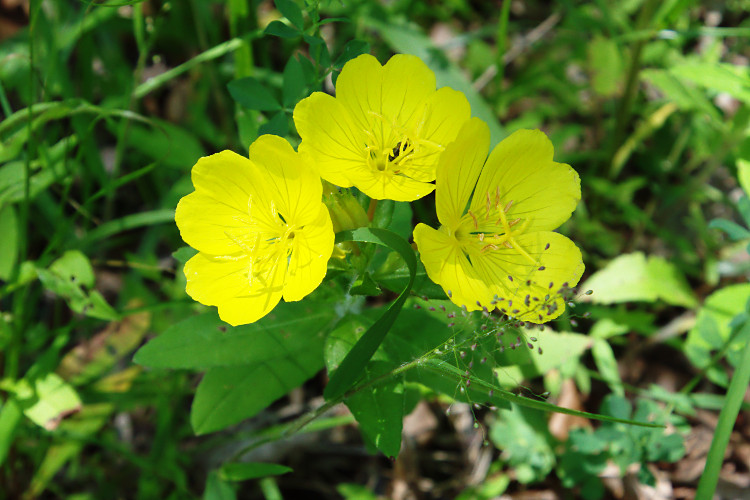
Evening Primrose (Oenothera sp.).
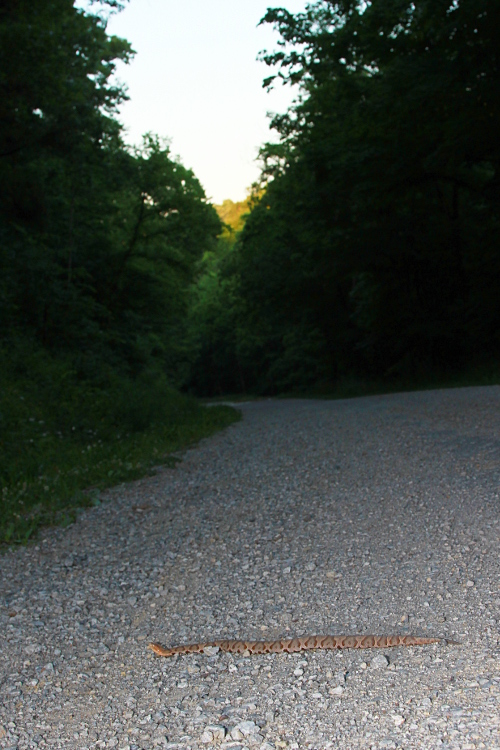
A Copperhead (Agkistrodon contortrix), as found crossing the road
at sunset.
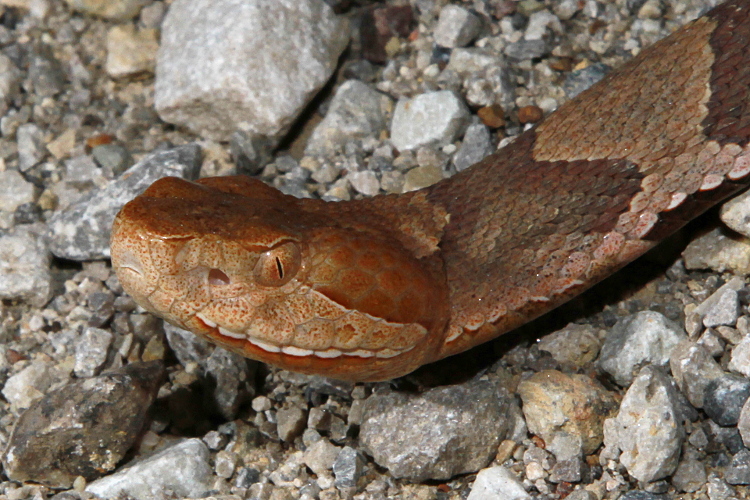
A closer look at the Copperhead.
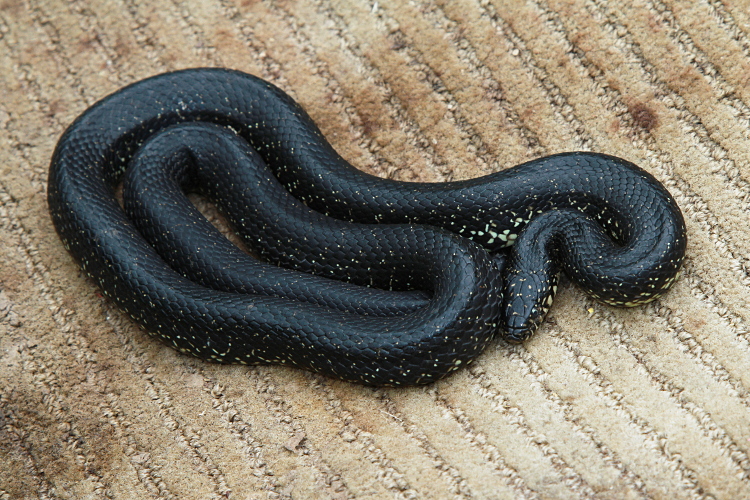
A Black Kingsnake (Lampropeltis getula nigra), as found between
layers of carpet.
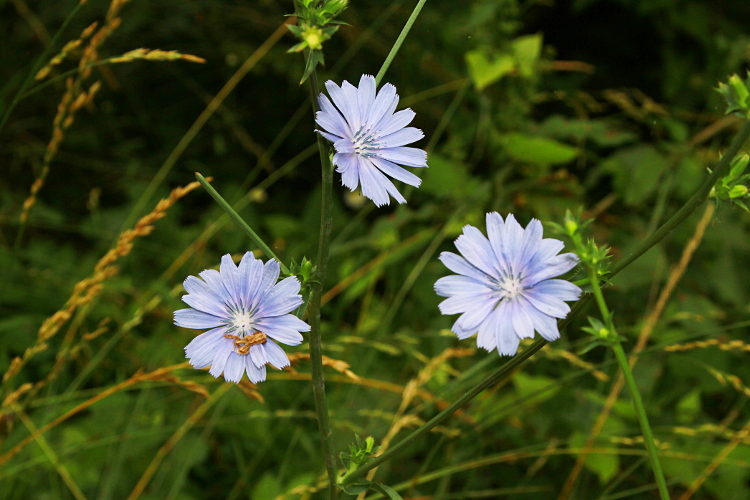
Chicory (Cichorium intybus).
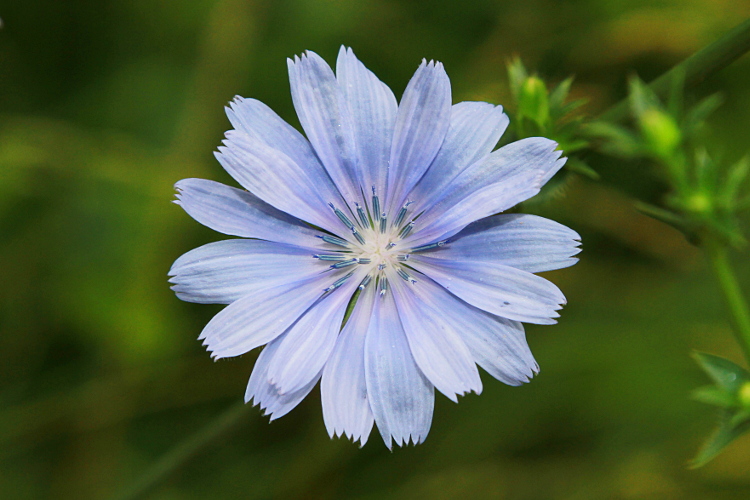
A closer look. Flowers that are actually blue are rather rare, at
least in my experience.
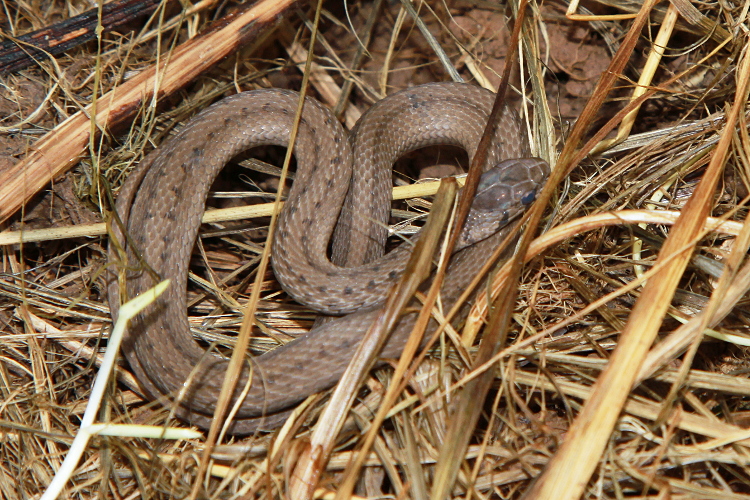
A Dekay's Snake (Storeria dekayi), as found under an old cooler lid.
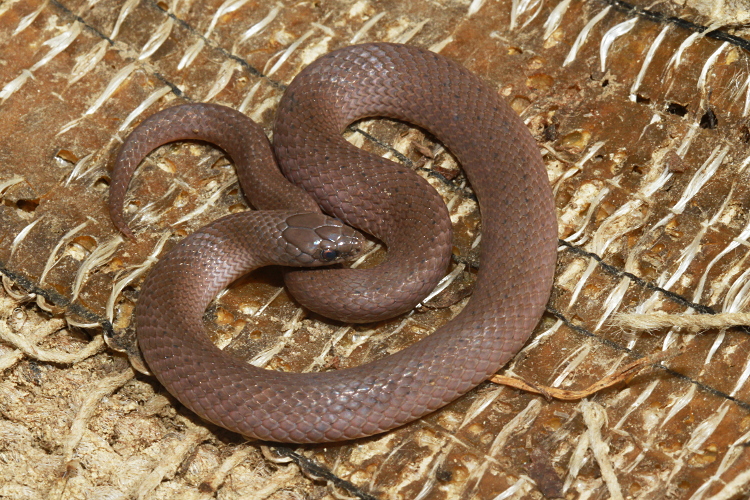
A Smooth Earth Snake (Virginia valeriae).
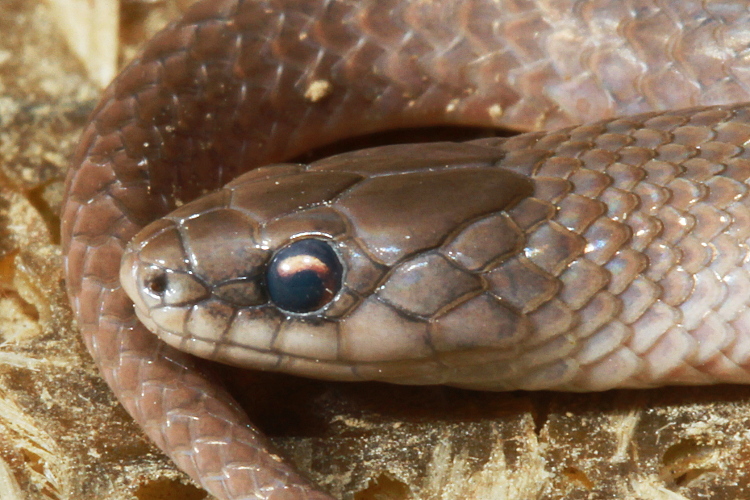
Another look.
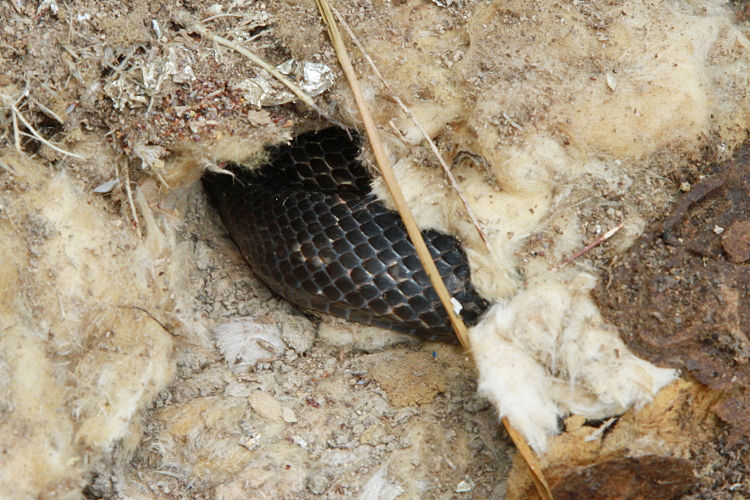
A coil of a Black Ratsnake (Elaphe obsoleta), as spotted
in some insulation that had been covered by carpet.
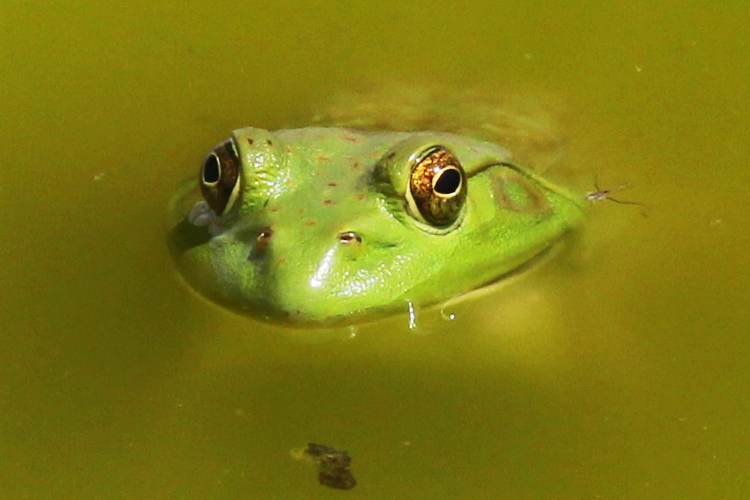
A Bullfrog (Rana catesbeiana) observed in our pool.
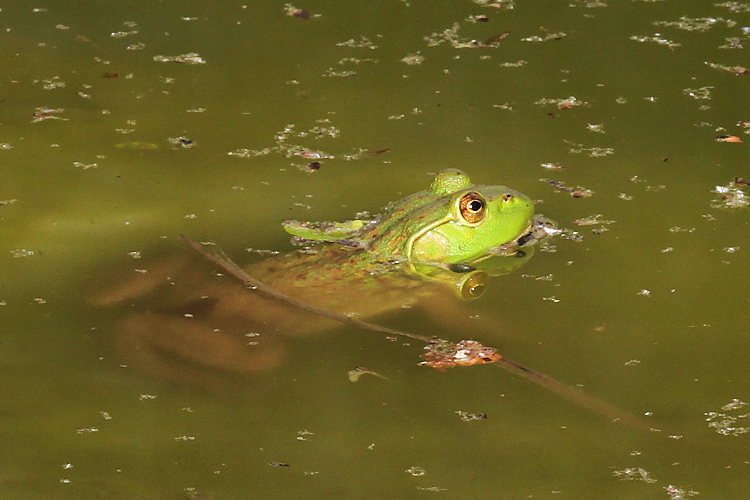
Another Bullfrog in our pool.
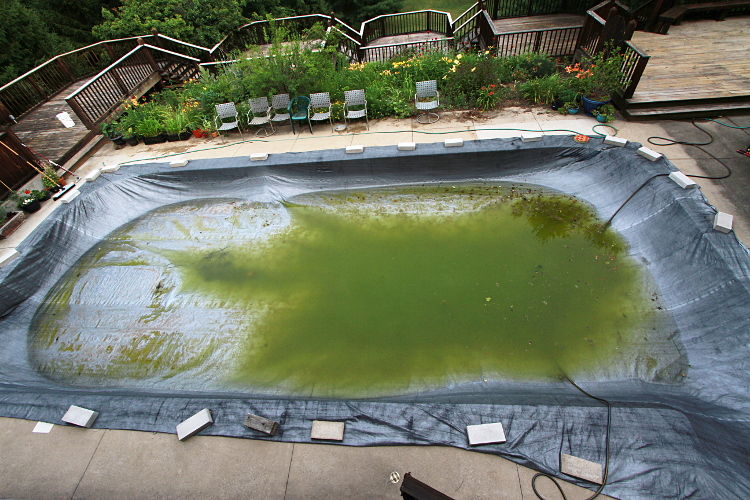
Our pool on June 20.
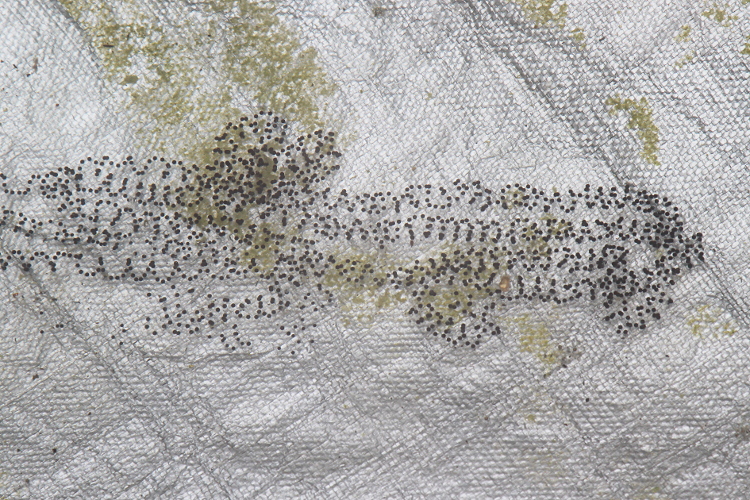
A string of American Toads (Bufo americanus) eggs observed in our pool
on June 28. They had been laid the night before. This is the latest
in the season that I have ever see eggs laid by this species.
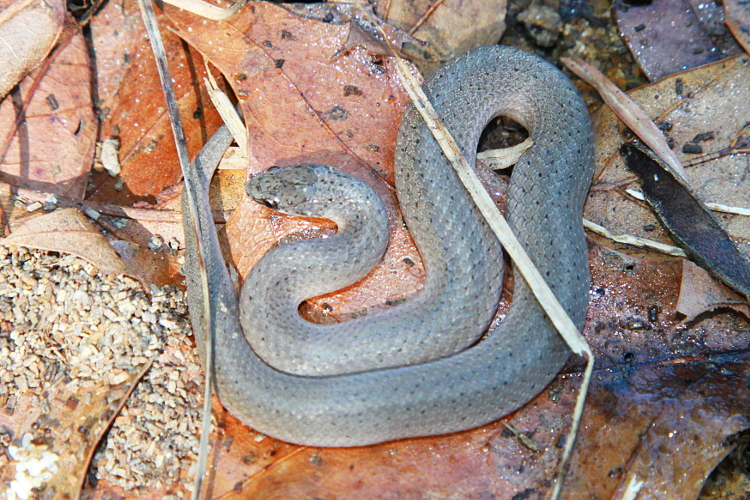
A Smooth Earth Snake (Virginia valeriae), as found under a board.
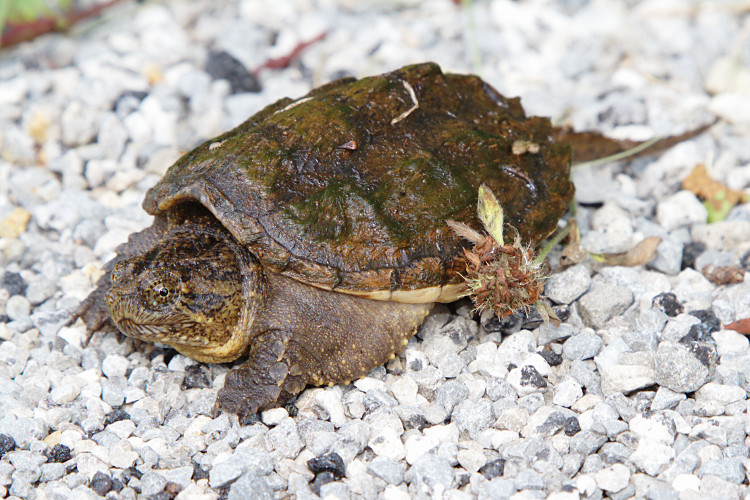
A young Snapping Turtle (Chelydra serpentina), as found
crossing a gravel road.
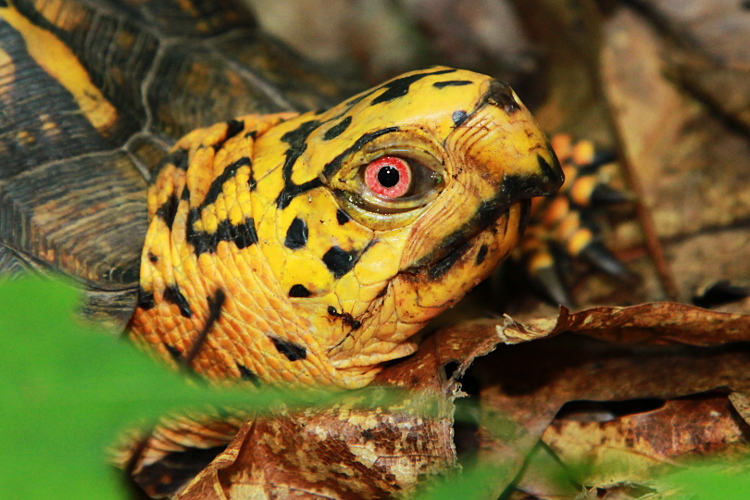
A colorful Eastern Box Turtle (Terrapene carolina).
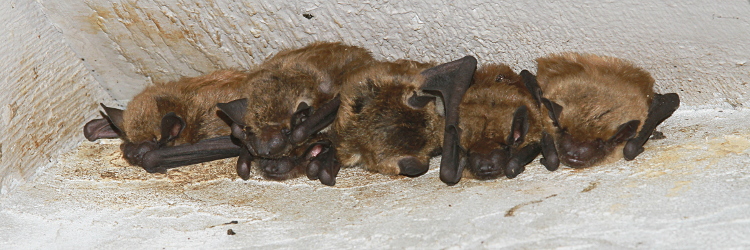
Some bats under the eaves of our house. Roxanne thinks they are cute.
I'm not going to go that far, but they are interesting. They are either
Big Brown or Little Brown Bats.
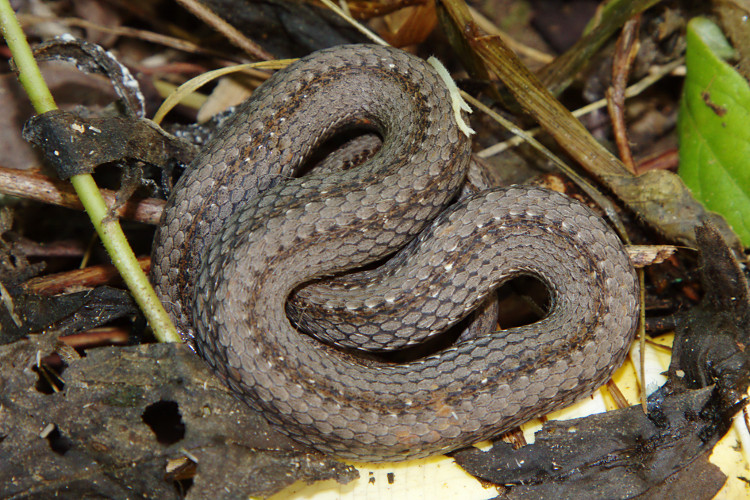
A Red-bellied Snake (Storeria occipitomaculata), as found under cover.
This was a very welcome find as I had not seen one of these since 2013.
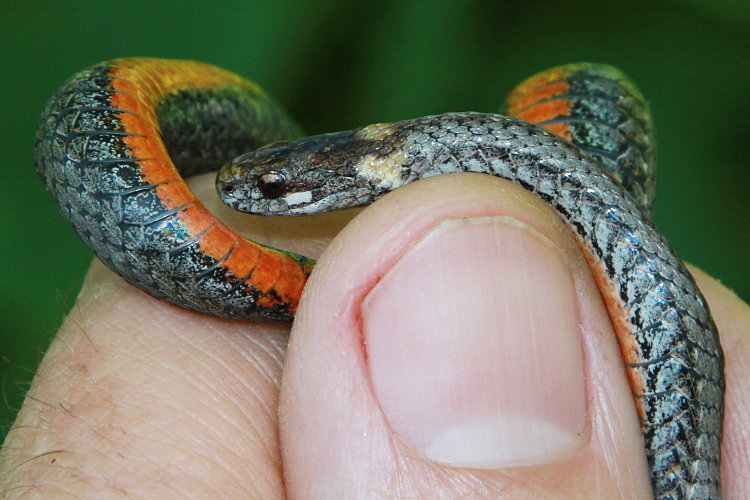
A closer look at the Red-bellied Snake.
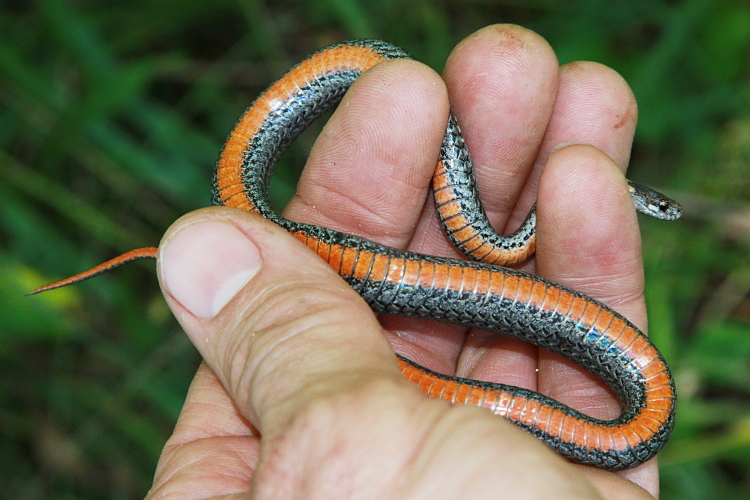
Why it's called a Red-bellied Snake.
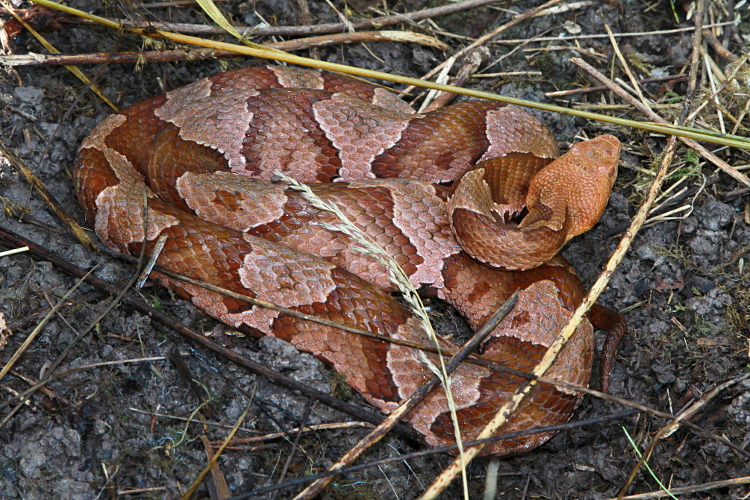
A rather stunning Copperhead (Agkistrodon contortrix), shown
almost as found under a board.
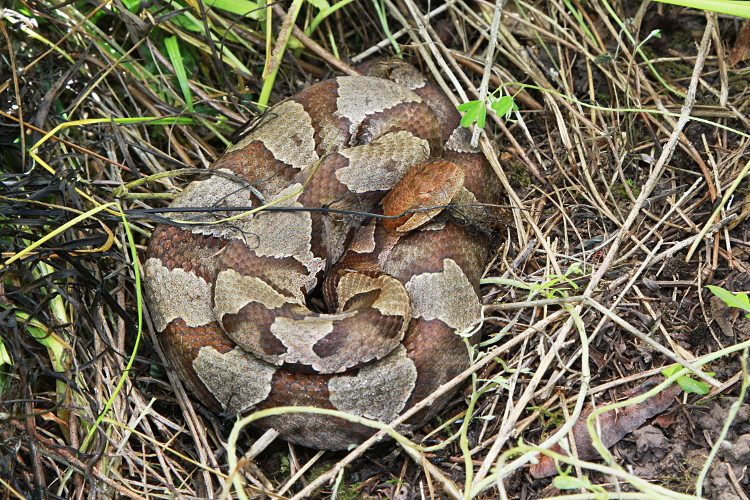
Another Copperhead found under a board.
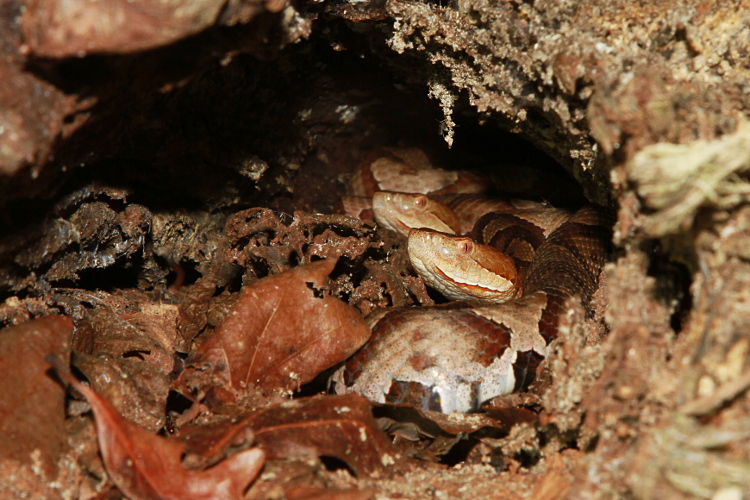
A couple of Copperheads spotted inside a hollow log.
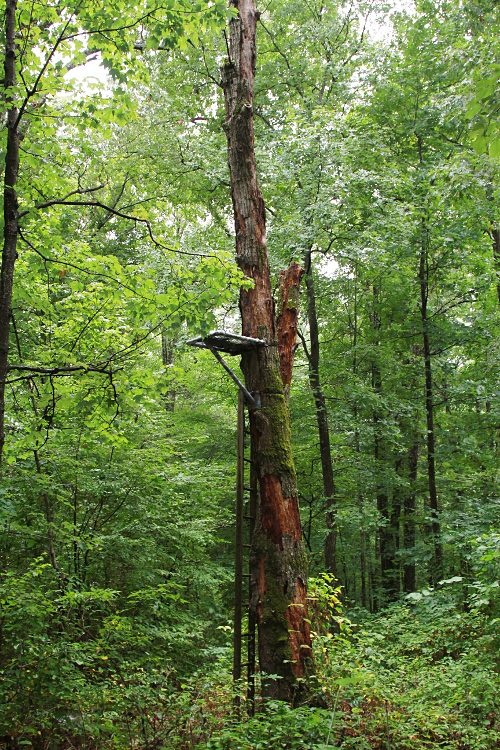
I thought this old-school tree stand was an interesting find. It is deep in
the woods, far from any road. It has been here for a very long time.
The chains that hold it to the tree are buried inside the wood of the trunk,
so the tree must have grown quite a bit after the stand was installed.
The tree has also been dead for many years and is about ready to fall over.
The stand itself is made of thick-walled steel tubing. The ladder that
you can see is made of wood and is totally rotten.
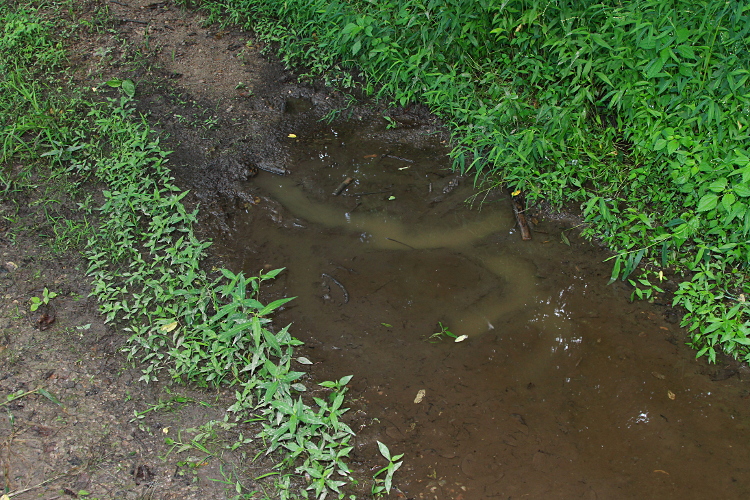
Playing in the mud. I was looking at these tracks in the mud when my friend
pointed out that a lump of mud was in fact an
Eastern Box Turtle (Terrapene carolina).
I like to think that animals sometimes just do things for the fun of it...
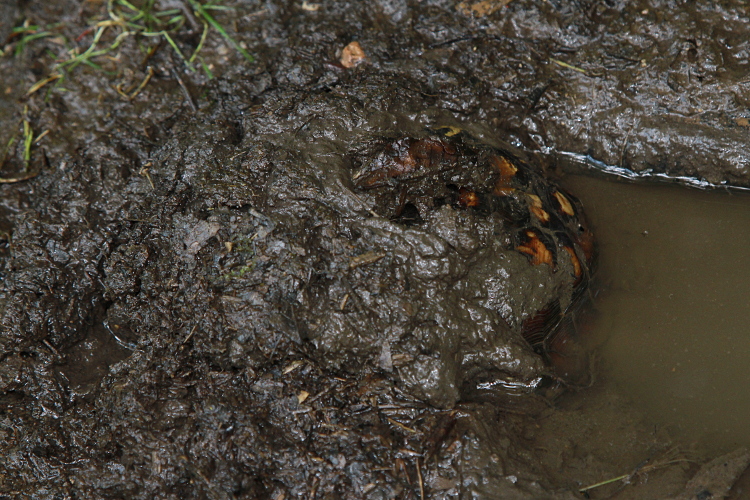
Definitely a Box Turtle.
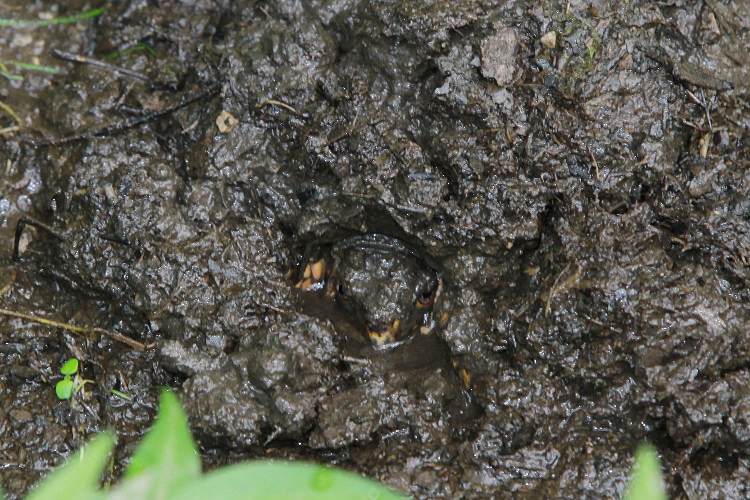
Peekaboo!
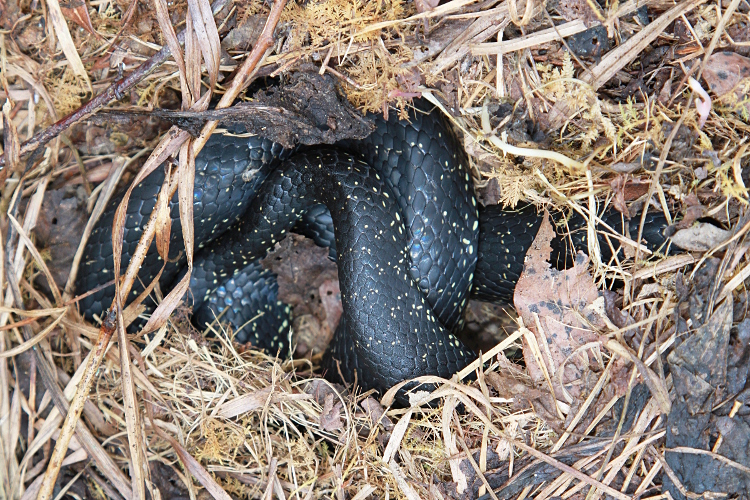
A Black Kingsnake (Lampropeltis getula nigra), as spotted in
a rodent nest under a board.
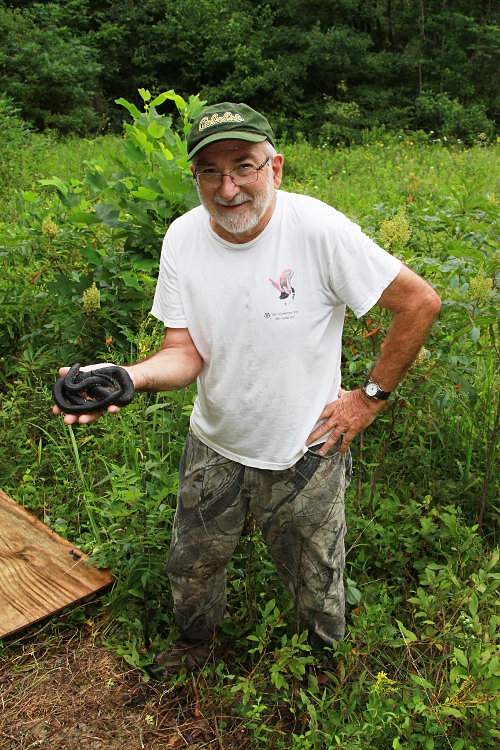
My friend Jim with the Kingsnake.
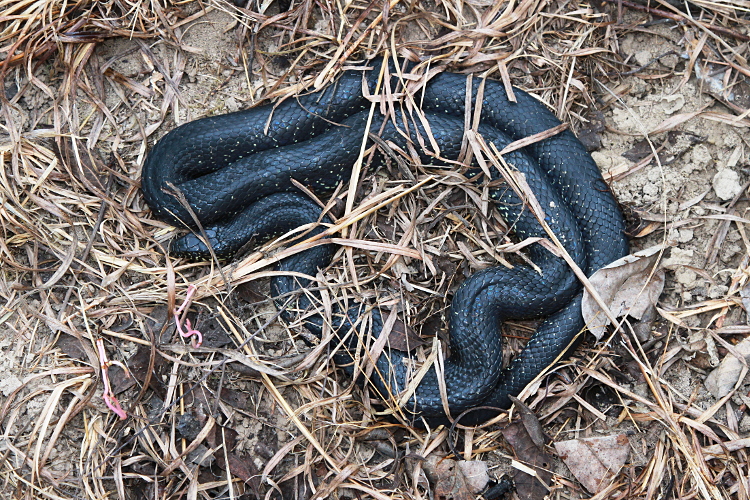
Another Black Kingsnake, as found under a board.
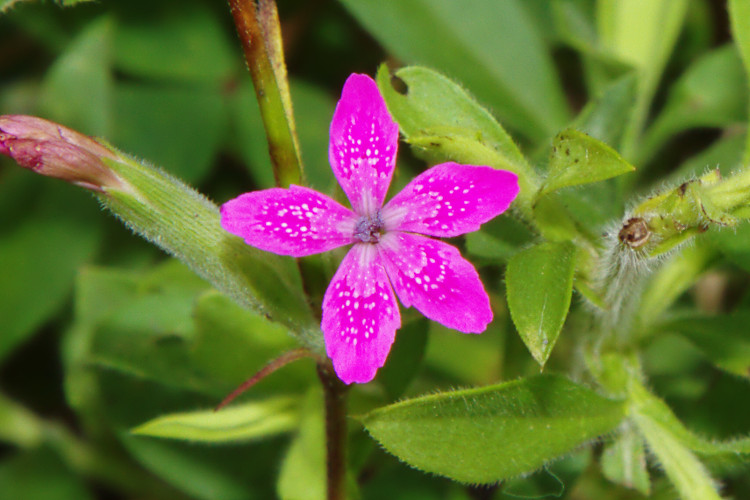
Deptford Pink (Dianthus armeria).
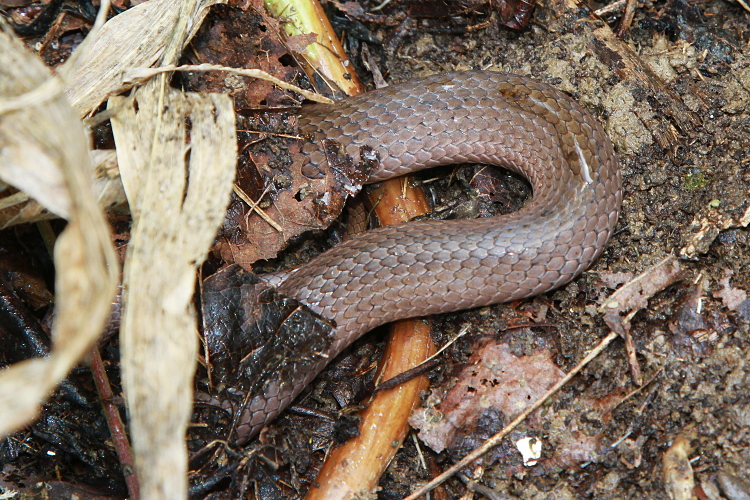
A coil of a Smooth Earth Snake (Virginia valeriae), as
revealed when a board was lifted. The snake appeared to be very
gravid. Interestingly, it was right at the edge of the board.
It pays to look carefully.
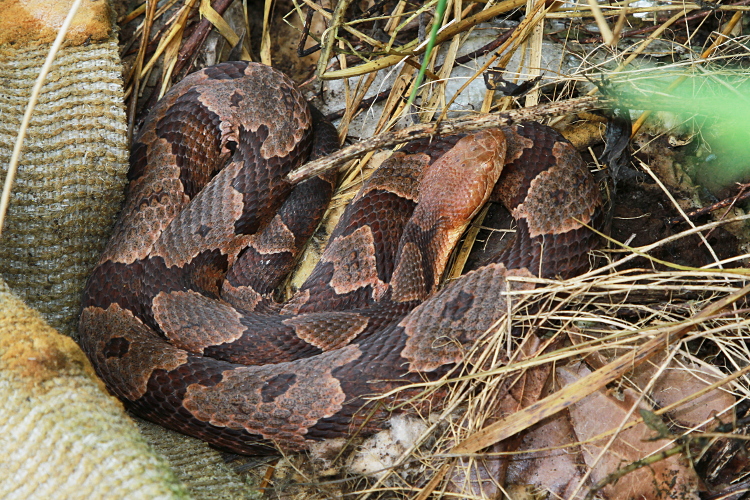
A large Copperhead (Agkistrodon contortrix), as found under carpet.
The same snake was seen at this site last year.
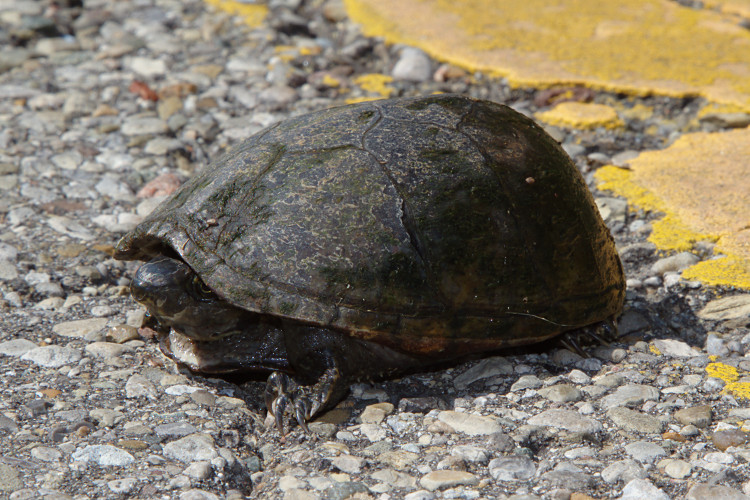
A Stinkpot (Sternotherus odoratus), as found crossing a road
on a hot day in late July. I had not seen one of these since 2010.
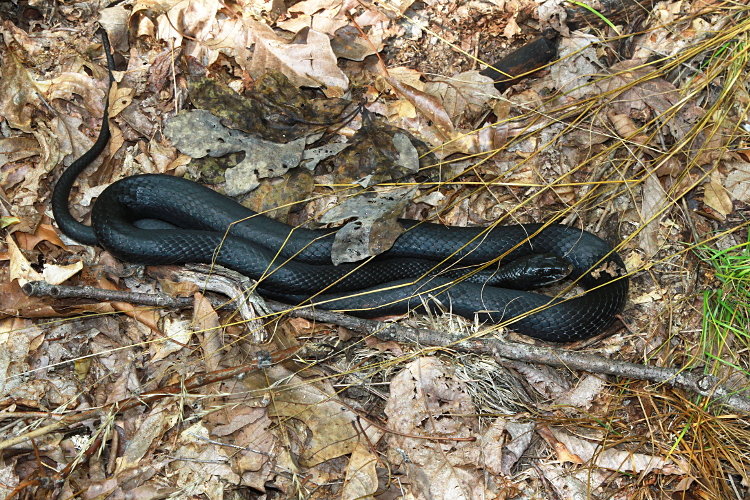
A Black Racer (Coluber constrictor), as found under a board.
I really like the way that racers will sometimes rest in a very
elongated coil, such as this one.
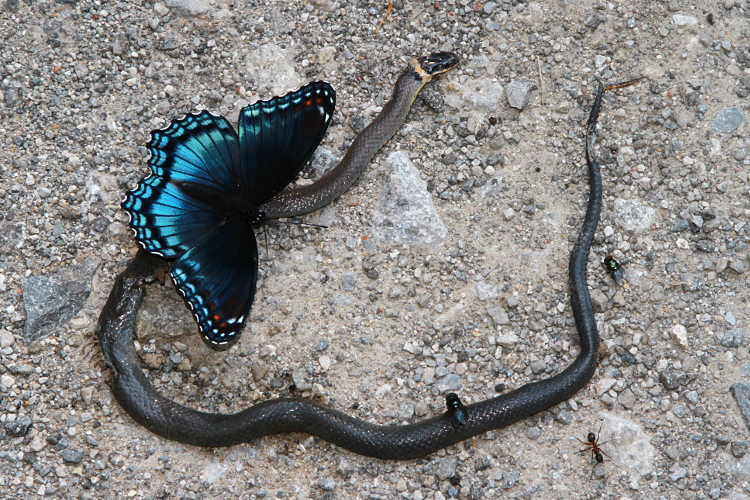
A Red-spotted Purple (Limenitis arthemis) taking sustenance from an
unfortunate Ring-necked Snake (Diadophis punctatus) that had
been run over on a dirt road.
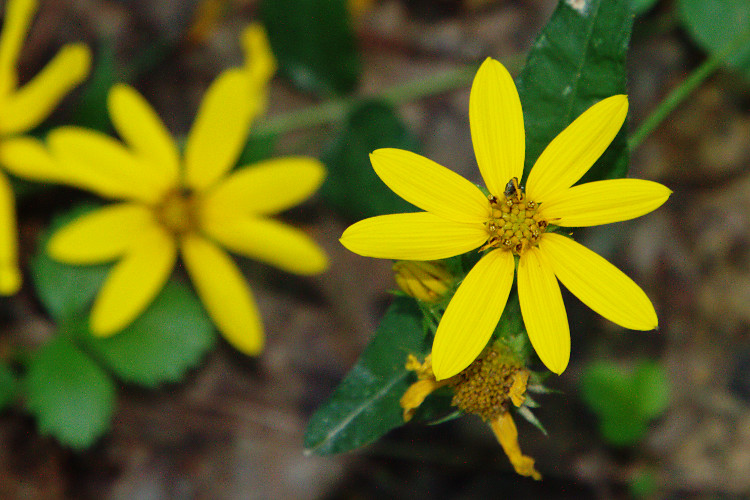
A Sunflower (Helianthus sp.) of some sort.
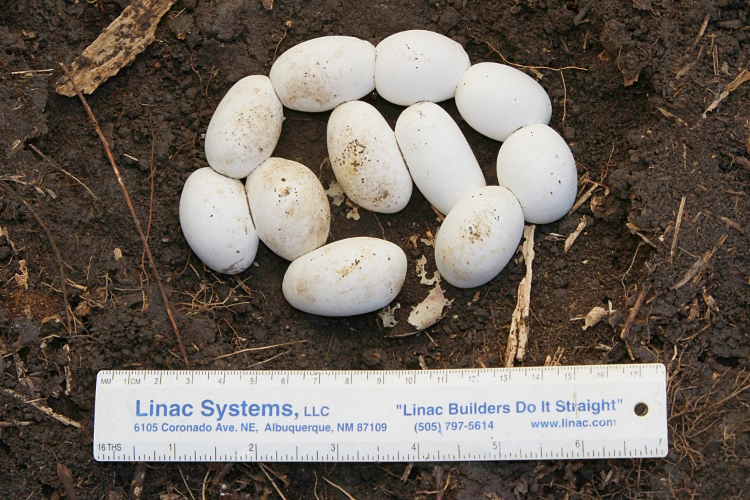
Some snake eggs found on August 7. They were under a rubber mat that
was under several layers of carpet padding that was under a layer of carpet.
I brought them home, hoping to hatch them out and see what
species they are.
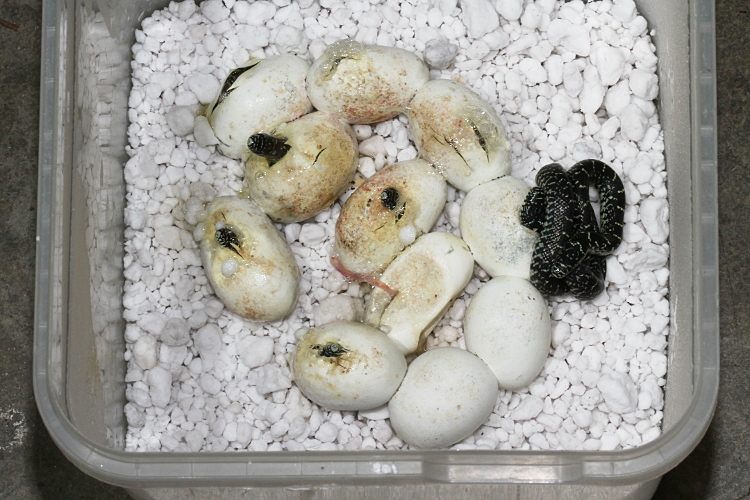
On September 5, the eggs started to hatch.
It turns out the are Black Kingsnakes (Lampropeltis getula nigra)!
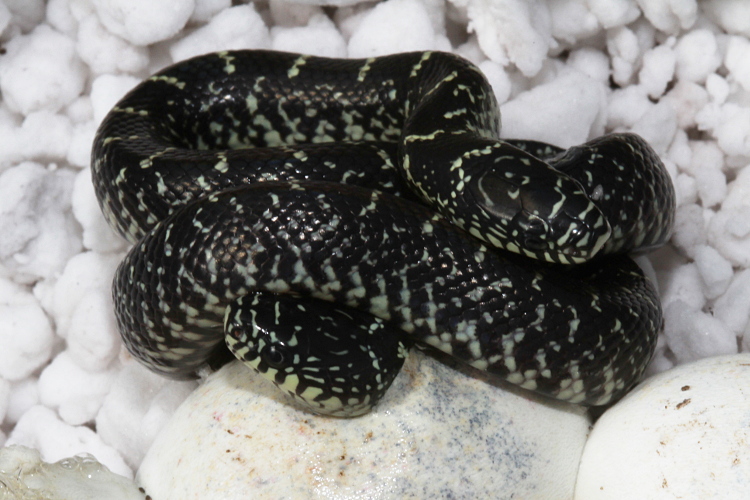
For the most part, I do not consider reptiles to be cute.
Hatching baby snakes would be an exception to this rule.
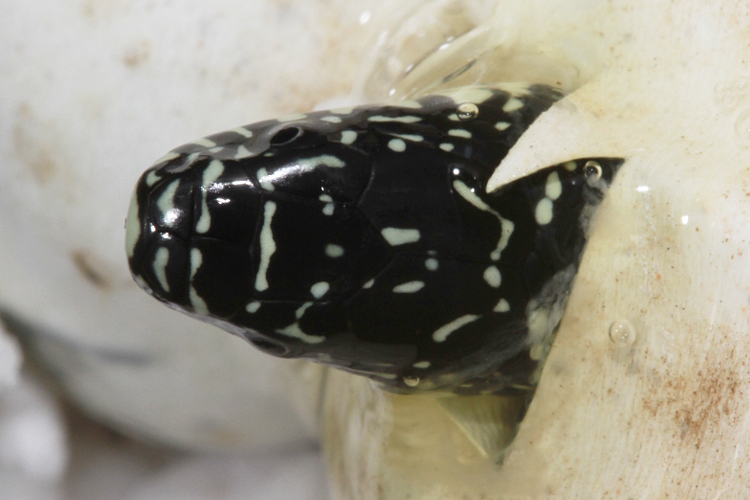
Coming into the world.
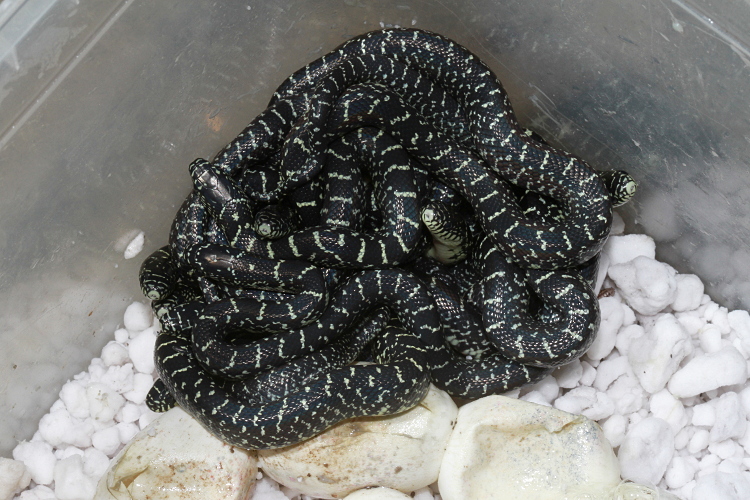
By September 6, 9 out of the 11 eggs had hatched.
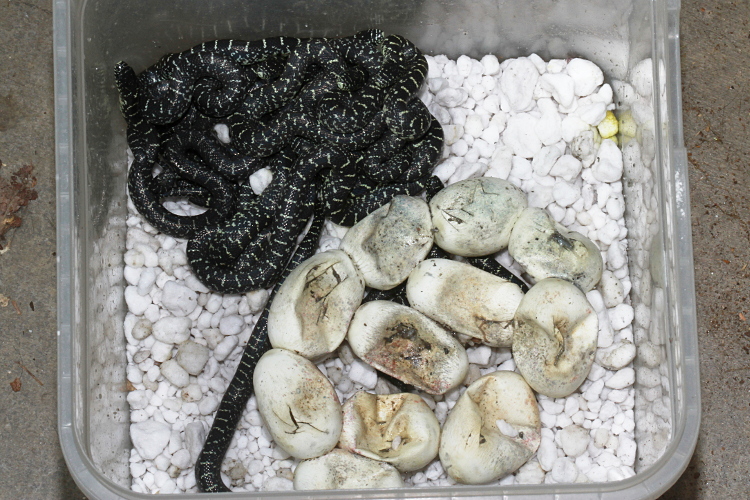
Finally, on September 8, all 11 of the babies were completely out.
I was happy to see that all of the eggs successfully hatched.
They were released at the location where the eggs were found, but
before doing so, measurements were taken:
| snake |
weight (grams) |
total length (mm) |
snout-vent length (mm) |
| #1 |
8.7 |
272 |
241 |
| #2 |
7.9 |
265 |
230 |
| #3 |
9.3 |
270 |
237 |
| #4 |
9.7 |
289 |
251 |
| #5 |
8.7 |
266 |
230 |
| #6 |
9.3 |
273 |
233 |
| #7 |
9.3 |
283 |
241 |
| #8 |
9.5 |
286 |
245 |
| #9 |
10.0 |
292 |
250 |
| #10 |
10.0 |
282 |
245 |
| #11 |
9.4 |
276 |
240 |
Now back to regular chronological order.
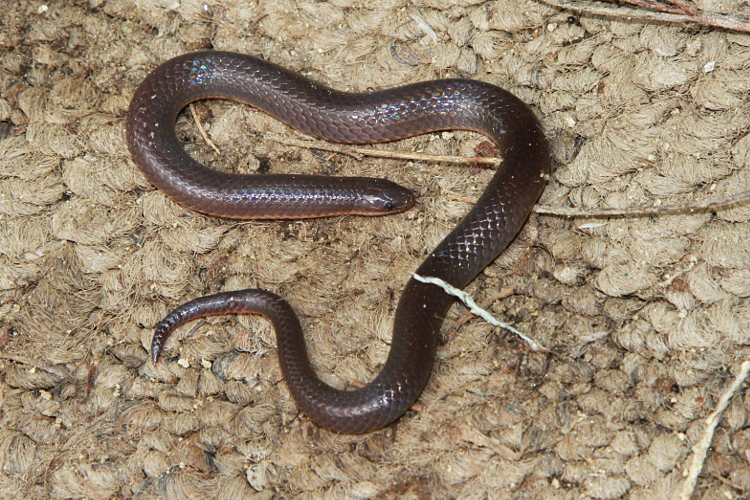
A Worm Snake (Carphophis amoenus), as found between layers of carpet.
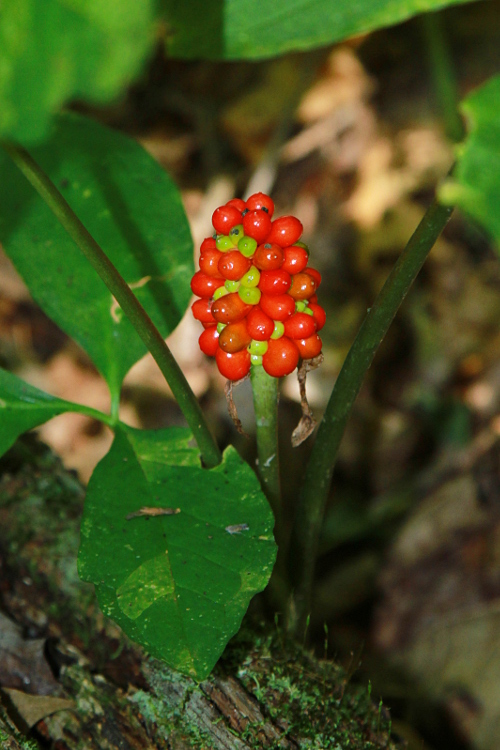
Jack-in-the-Pulpit (Arisaema triphyllum) berries provide a nice
splash of color in the late summer.
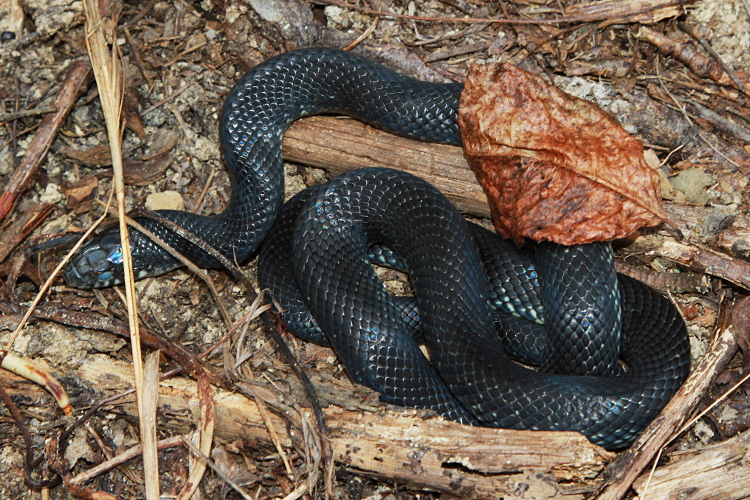
A Black Kingsnake (Lampropeltis getula nigra), as found under cover
in late August. It is in pre-shed condition.
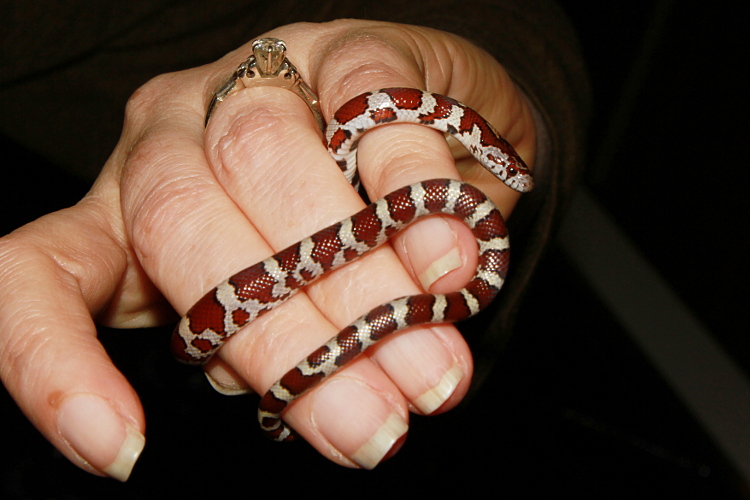
A hatchling Milksnake (Lampropeltis triangulum) that Roxanne
found on our driveway on the night of September 2.
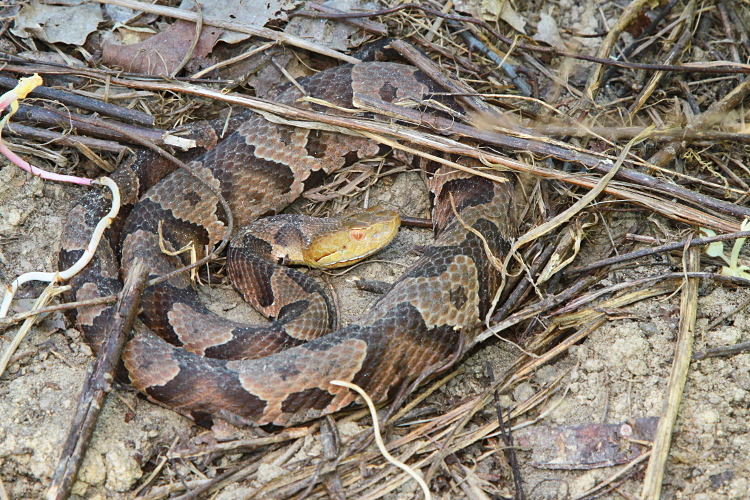
A Copperhead (Agkistrodon contortrix), shown as found under cover.
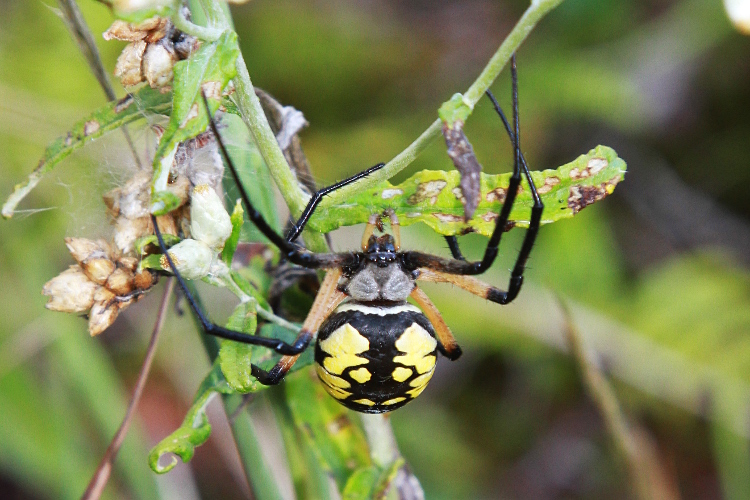
An annoyance of hiking in the late summer and early fall is
huge number of spider webs that one winds up walking through. I am not
afraid of spiders -- in fact I like and appreciate them.
But constantly cleaning web off of your face and arms gets old.
Using a snake hook to clear out the webs as you go is helpful
but only goes so far.
I found this rather large spider crawling on my arm one day.
It is a Zipper Spider aka Black and Yellow Garden
Spider aka Argiope aurantia.
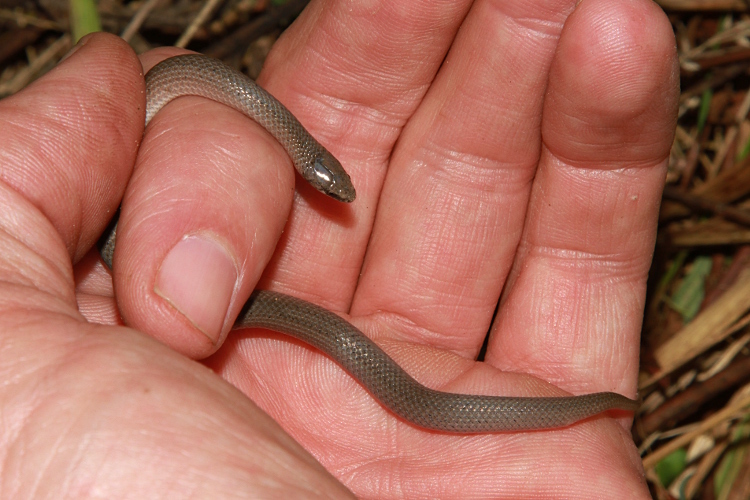
A Smooth Earth Snake (Virginia valeriae) that was found under some
carpet. The species name valeriae honors Miss Valeria Blaney, who
was apparently collected the first documented specimen of this species.
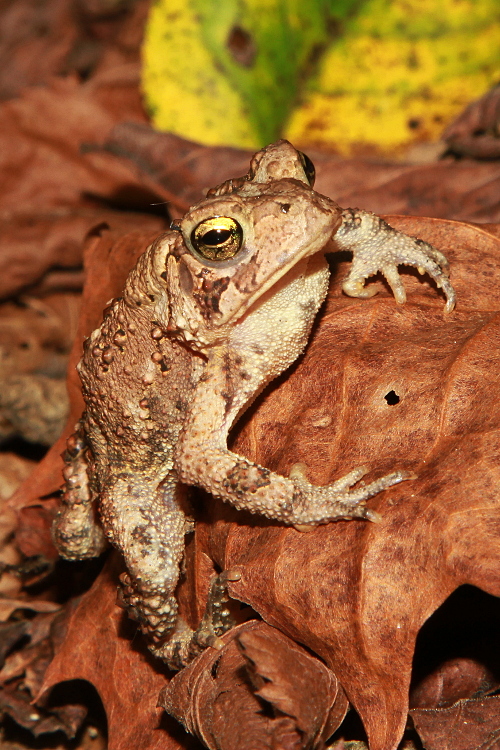
An American Toad (Bufo americanus) found hopping in a dry creek bed.
Dry was the operative word for the second half of the summer.
In very late September we finally received some rain and the
amphibians responded.

A Marbled Salamander (Ambystoma opacum).
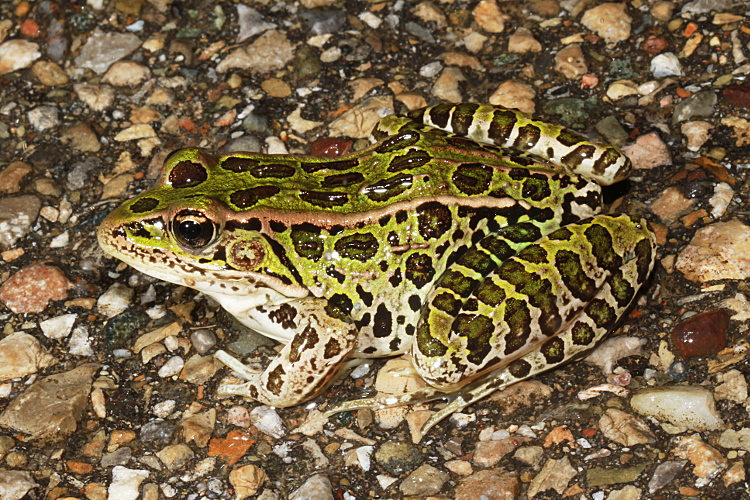
A Northern Leopard Frog (Rana pipiens).
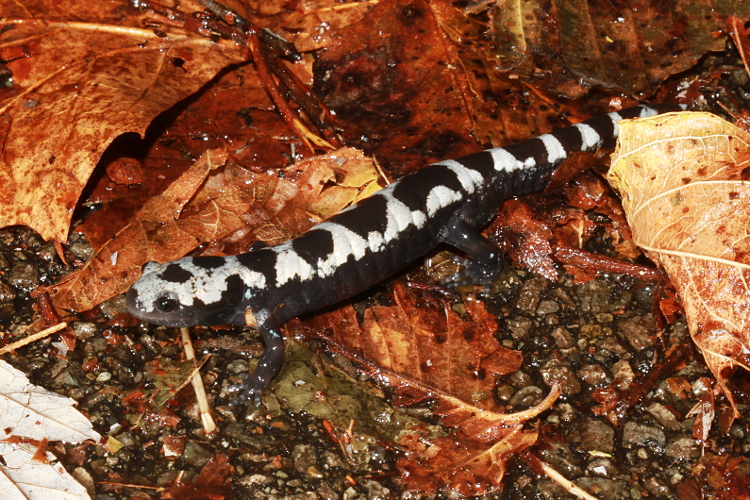
A Marbled Salamander (Ambystoma opacum).
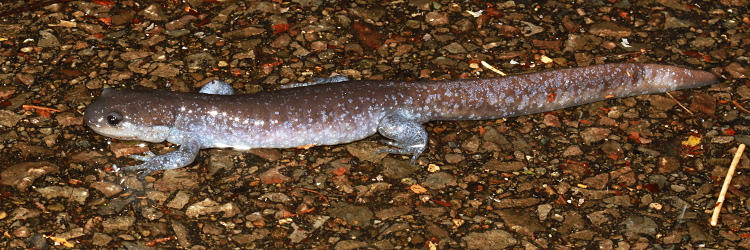
A Jefferson Salamander (Ambystoma jeffersonianum).
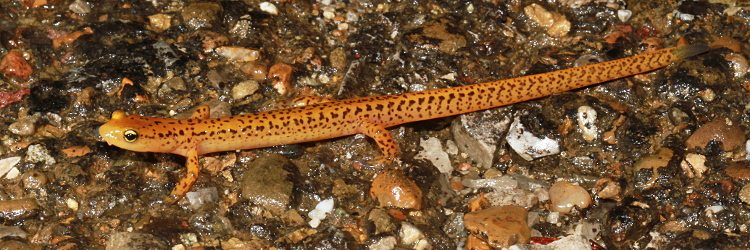
A Long-tailed Salamander (Eurycea longicauda). I have visited
the particular site where this animal was found many times over the past
12 years -- and this is the first example of this species that I have
seen here.
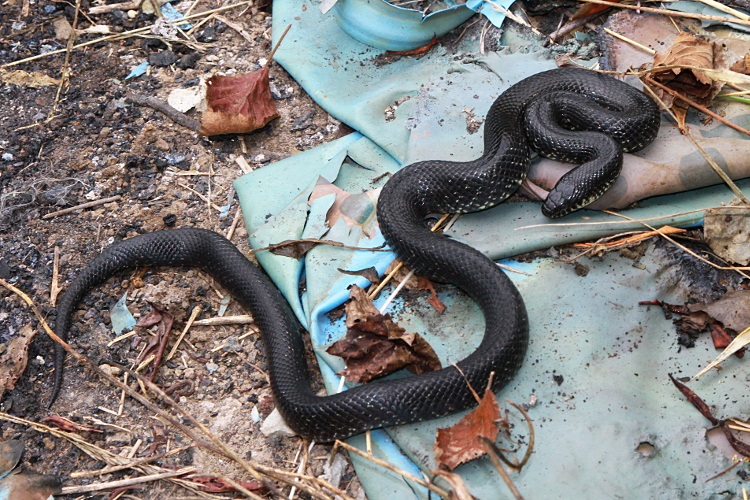
A Black Kingsnake (Lampropeltis getula nigra), as found under
some trash.
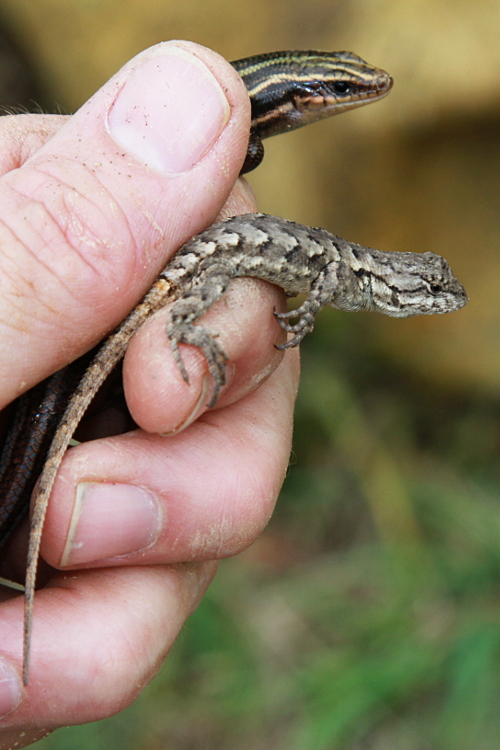
A Five-lined Skink (Eumeces fasciatus) (top) and
an Eastern Fence Lizard (Sceloporus undulatus) (bottom).
Bother were found under the pile of carpet and carpet padding that I
found the Black Kingsnake eggs under a couple of months earlier.
I was by myself -- and I was rather pleased that I was able to capture both
lizards, as I had not seen either species at this site before and I wanted to
get photographs of them. I posted this on facebook along with the photo --
and my childhood lizard-hunting partner Steve C. remarked
"Impressive Carl, you still got it after all these years!"
I would like to think so...
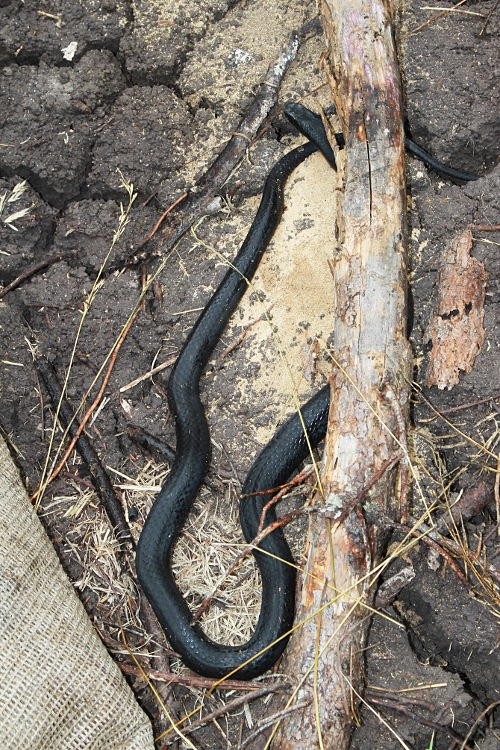
A Black Racer (Coluber constrictor), almost as found under carpet.
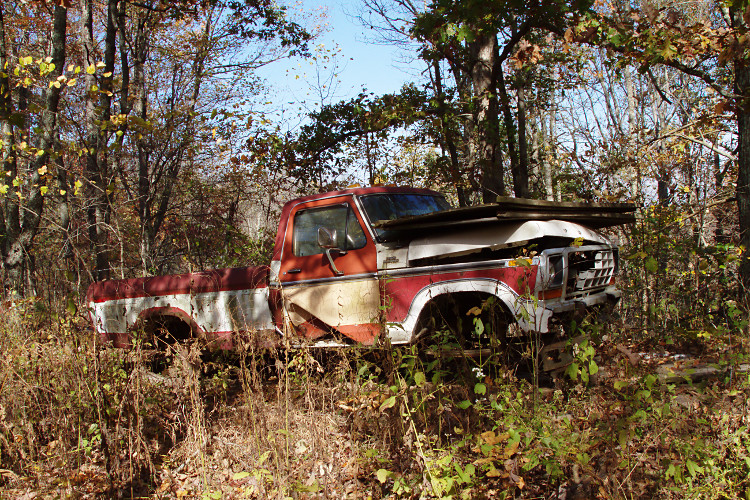
An old truck that I stumbled across deep in the woods. It's a circa 1980 Ford
F250. The wheels are gone and it's sitting on cinder blocks.
There is not even a road here any more. An honest appraisal of this
situation suggests that I am the one that is old...
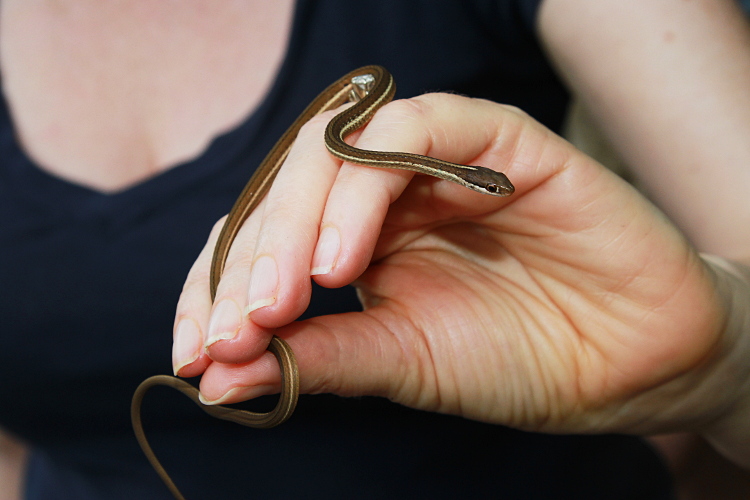
This photo is from Florida, taken between Christmas and New Years.
The snake is a baby Eastern Ribbon Snake (Thamnophis sauritus)
that Roxanne found and captured.
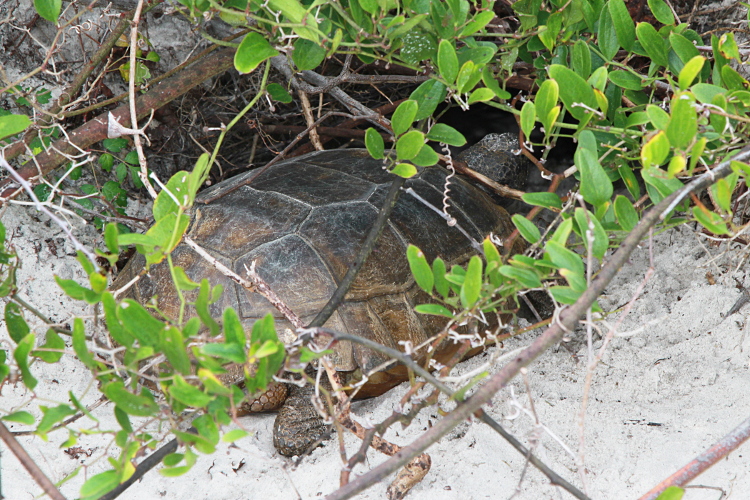
A Gopher Tortoise (Gopherus polyphemus), also from Florida.
That's it for 2016. What will 2017 bring?
























































































































































































